Leica Monochrom 246 Vs M10
Shortly afterwards the M Monochrom (Typ 246) was introduced back in early 2015, I published an article comparing it to an M (Typ 240) with its color files converted to black and white to run across if loftier ISO performance was really superior with a dedicated monochrome sensor, along with the previous M Monochrom (M9M) to gauge whatever generational improvement. The friction match-up was certainly illuminating, conspicuously showcasing the superiority of the then-new M246 over both its CCD-based predecessor and color CMOS sibling. The M9M and M240 both put up a adept fight and displayed their ain depression-light capabilities. But the Yard Monochrom (Typ 246) was the articulate victor, pulling even further ahead at the higher ISO settings.
Since publishing that article, there have been some major developments in the Leica world. In 2015 alone, both the Q (Typ 116) and SL (Typ 601) were introduced, each featuring exceptional low-light operation intendance of their next generation 24-megapixel sensor architecture. Then, in January 2017, the Yard system got a pregnant upgrade with the launch of the M10. Included with the myriad overall improvements was a sizable bump to high ISO functioning from the M240. And only within the by six months, the SL2 has doubled the resolution from the original SL, while the latest M10 Monochrom now offers upwards fifty-fifty higher ISO adequacy, too as boasting 41 megapixels for the get-go time in an One thousand camera.
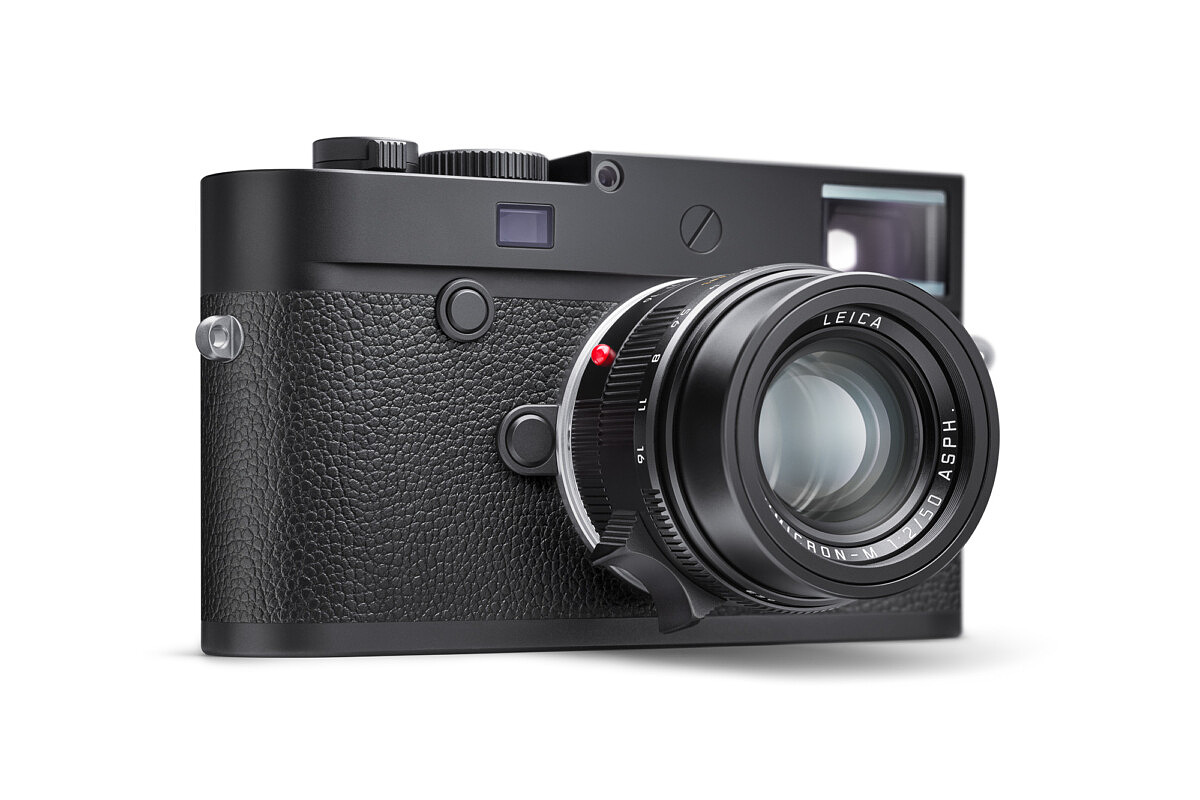
A lot has changed in the last five years. And with so many new options in the Leica lineup, I figured it was high fourth dimension for a refreshed B&W ISO Showdown in 2020. And fair warning – a copious quantity of images lie ahead. Equally in, over 100 comparison images.
Thoughts and caveats
Before we dive in too deep, let's go the caveats out of the mode first. Tests like this are, by definition, pixel-peeping. And I know that many don't consider that a positive thing. Personally, I favor a more holistic arroyo, but do value the clarity of a well-designed, controlled test.
When evaluating a new camera for a full review, I form my opinions by venturing out and using it for real work. Actual results under various lighting conditions, with a broad variety of field of study matter serve as the foundation to my review. I don't actually first writing a unmarried word until I've had ample time to both shoot and process the resulting images, in order to get a clearer picture of the character and capabilities of the camera.
But even that's not the whole story. See, there is far more than to judging the forcefulness of a photographic tool than epitome quality alone. How it feels in hand, the audio of the shutter, the clarity of the viewfinder, the ease and accuracy of focus, interaction with the UI, overall responsiveness, etc. Only later on considering the total experience of using a camera, can I truly develop a cogent assessment of it as a photographic tool. I'm a lensman first and foremost. My reviews are always taken from that perspective.
And while I identify heavy emphasis on existent-world shooting, in that location is undeniable value in understanding the critical performance envelope of a camera nether ideal test conditions. Knowing, empirically, how the photographic camera will perform when you push it to its limits, allows you as a photographer to work within those parameters comfortably and confidently. More than insight and understanding into our tools is never a bad thing. And then, let'south not hate on the pixel-peeping this time around, ok?
Okay, more than caveats.
Testing is difficult. Testing is imperfect. And no single methodology will be ideal. But, I'll explain my approach and reasoning behind information technology. Starting off, let's take a expect at our contenders for this showdown:
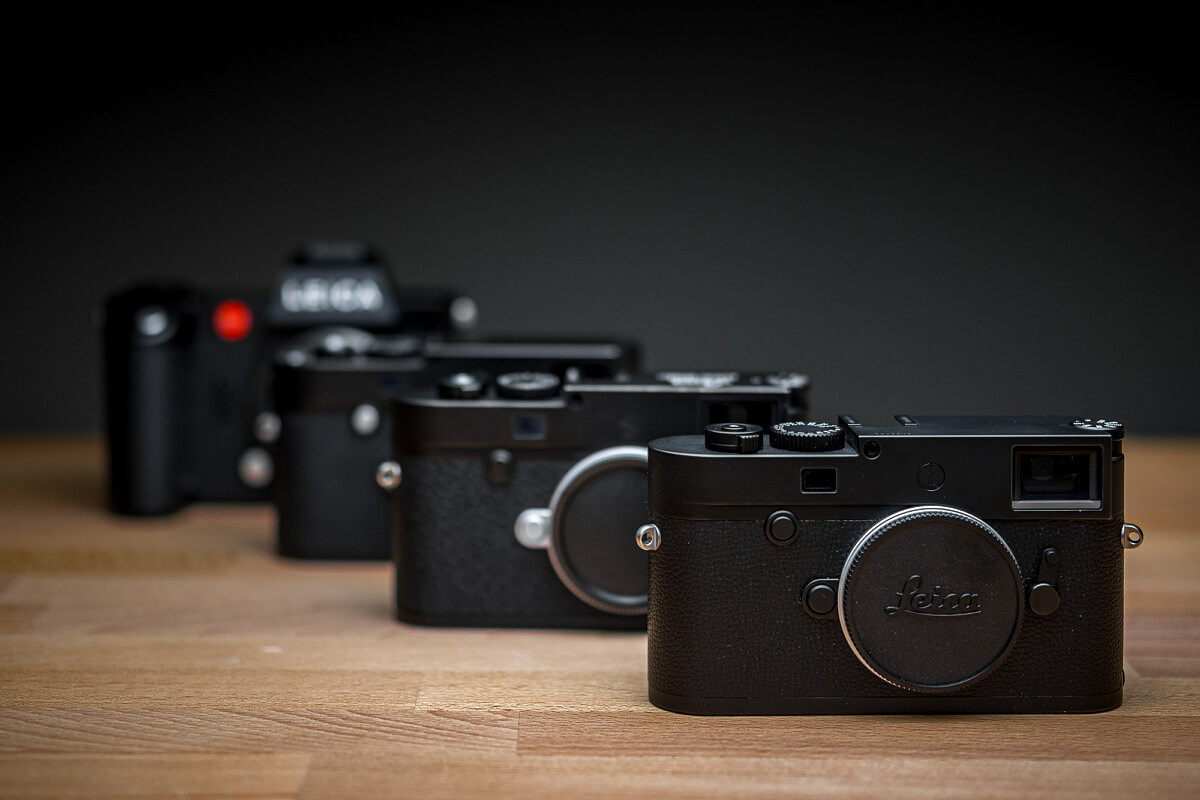
| Camera | Resolution | ISO Range | Sensor Type |
| Leica M10 Monochrom | 41 MP | 160 – 100000 | Monochome |
| Leica G Monochrom (Typ 246) | 24 MP | 320 – 25000 | Monochrome |
| Leica M10-P | 24 MP | 100 – 50000 | Color |
| Leica SL2 | 47 MP | 50 – 50000 | Color |
Clearly, at that place are a fair amount of dissimilarities in our round-upwards. Three different resolutions. Widely ranging ISO values. Color and monochrome sensors. Thankfully, nosotros can utilize the same exceptional lens, the APO-Summicron-M 50mm f/2 ASPH, on all cameras. They also all feature alive view with focus magnification allowing for critical focus off the sensor. Simply this is where the similarities finish and the testing challenges begin.
ISO Range
Showing every unmarried ISO value on all cameras wasn't feasible. Not only are the lowest and highest values unlike on all (except for the max of 50000 on the M10-P and SL2), the SL2 only has whole ISO values, non thirds like the Thousand cameras. This is slightly problematic as performance differences are typically apparent with small changes towards the upper stop of the range. Thankfully, 1/three stop moves were insignificant at lower ISO values, so I stuck to whole ISO steps at 6400 and below.
By ISO 6400 nosotros get-go to encounter some meaningful changes with each incremental crash-land, then I've included all one/3 stop results all the style upwards to the M10M'south maximum of ISO 100000. Doing then created way more comparison sets, but I think nigh will appreciate the added granularity. In addition to the lack of 1/3 stops on the SL2, note that there are no detached steps between ISO 12500 and ISO 25000 on the M246, and so for 16000 and 20000 the M246 is yet showing the 12500 issue. Just be enlightened when viewing these comparisons.
With regards to the ISO range disparity, I chose to start at a mutual value of ISO 200, making a small exception for the M246 which competes here at ISO 320, as this is its base ISO. No, 200 isn't base ISO for any of the other cameras, just there is no real quality sacrifice versus the bodily base values.
At the top of the range, I permit the M10M strut its stuff and testify results all the way up to its maximum of ISO 100000. And since none of the other cameras become equally high, I freeze them at their respective upper limits. Behave this in mind as well when looking at the comparing images. While simply showing the changes in the M10 Monochrom, I do think quantifying the improvement relative to the other cameras is useful.
I decided against underexposing and pushing the exposure in post processing to emulate even higher ISO values. The reality is that while mayhap interesting to some, I can't realistically imagine anyone actually doing this in a real shooting scenario.
Resolution
Four cameras, iii different resolutions. In our examination grouping, nosotros've got 47, 41, 24 and 24 megapixels. For this claiming, I took a two-pronged arroyo. Start, after taking into account the SL2 not fitting into the granular ISO comparisons due to its whole stop ISO limitation, along with its sizable megapixel disparity with all the other cameras here, I omitted information technology from the all-camera friction match-upward. What you'll see below are 3-way match-ups between all the M cameras. But don't worry. I did include the SL2, just in a separate serial below versus the M10 Monochrom, both at total native resolution.
With the SL2 eliminated from the main M camera friction match-upwardly, we're all the same left with the M10 Monochrom at 41 megapixels pitted against 2 24 megapixel cameras. So, in an effort to produce the nigh apples-to-apples comparison, I downsampled the M10M files to 24 megapixels. Why not scale the others up to 41? Well, I vehemently oppose uprezzing across native resolution as you can't make something from nothing, and doing so can create boosted artifacts. Merely, reducing size to match upwardly actually makes some sense.
Let's suppose for this test, instead of 100% crops displayed on screen, I made 24 x 36 inch prints. In essence, I would be downscaling the higher resolution image to match the other ii. Except we don't call up of information technology that style. Rather, the larger paradigm file benefits by requiring less enlargement. So while at offset, reducing the resolution reward in this instance may seem counterintuitive, if we simply consider this a examination at a given output size, it really does make sense.
And if you want to see the full resolution difference on display, I've included that likewise. To simplify this additional series, I've matched up the M10 Monochrom against its predecessor the G Monohcrom (Typ 246) and merely included one photo per ISO. I did warn you about at that place beingness a lot of images. But this manner, everyone should exist (mostly) satisfied.
Full Size Images Download
At present, simply in instance all the following comparisons don't fully satisfy your marvel and you desire to practise your ain evaluations, I'chiliad leaving a link to download the full resolution exports for each camera at (almost) every ISO. The images were output directly from Lightroom every bit not-resized JPGs, with no output sharpening and saved at a quality level of 100. For all intents and purposes, they are on par quality-wise with TIFF files.
B&W ISO Showdown 2020 – Full Size Files
The Test
With all the reasoning out of the mode, time to move onto to the test setup and methodology.
Similar my previous B&Westward ISO Showdown five years ago, I went with an Italian food-themed tabletop setup as it offers a broad variety of detail, texture and tonality. A big thank you to our function manager Rayssa for styling the scene ameliorate than I ever could. Unlike the last time around, I opted to use controlled studio lighting rather than window low-cal. The continuous studio calorie-free affords far more command with regards to exposure and white balance, as well as 100% consistency from shot to shot. For lighting, I'g using a single Intellytech Light Cannon F-165 Bi-Color LED Fresnel. With a CRI of 97+, this is an extremely accurate, flicker-free professional cine light with full spectrum illumination.
All cameras were mounted on my Gitzo 3-Series tripod and Actually Right Stuff BH-55 brawl head using Arca-fashion quick release plates. The same APO-Summicron 50mm f/two ASPH lens was mounted on all cameras, with the improver of the M-Adapter-L for employ on the SL2. Focus for all shots was on the text of the balsamic vinegar bottle and was achieved in live view with focus magnification assist. The aperture was set to f/8 and the cameras were put into Aperture priority mode.
I outset set the exposure of the M10 Monochrom equally it has the widest ISO range and I needed to be sure that the shutter speed for this highest setting wouldn't exceed i/4000th of a second, the fastest available shutter speed. Then, all cameras were shot at base of operations ISO, adjusting exposure bounty as needed to match up to the M10M as a reference. Once exposures were squared away, I shot a total ISO series on each camera using the two-second cocky timer to avoid any possible vibration. And even later all that, at that place was yet slight framing differences betwixt the cameras.
For the image crops, I selected three zones. The label of balsamic vinegar bottle was the truthful focal point for all cameras, and demonstrates loftier-contrast loftier-detail image areas. The artichoke and pasta highlights textural details. And the tomato can with flat background shows smooth tonal areas. There are other interesting crops that I explored likewise, but at that place are already far too many images here as it is.



Epitome Processing and Noise Reduction
All the comparing images were processed using basic tone adjustments in the latest version of Lightroom Classic CC. I stayed abroad from any Presence tools equally this would have disproportionately colored the results. So, no Texture, Clarity or Dehaze was used on any of the images. I also made no adjustments to exposure, as doing and then would have impacted noise performance. Any variance in exposure at increasing ISO values was left in. And I didn't change toning on a per ISO footing. All corrections are per-photographic camera and remain consistent for the unabridged ISO run.
For the color cameras, I applied Lightroom's default Monochrome profile, dialed in basic tone adjustments, then used the Black & White Mix controls to attempt to match the overall look of the native monochrome cameras. The resulting conversions aren't perfect, only certainly very close.
I chose to optimize noise reduction settings as ISO levels increased for each camera. At base ISO, even a small-scale corporeality of default noise reduction would take diminished detail. And at high ISO, a lack of noise reduction would not have been representative of existent-world usage. These are all best-instance scenarios under platonic exam conditions, then please view them every bit such.
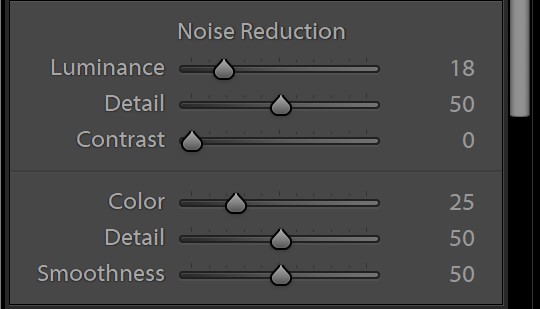
All files were exported from Lightroom using the highest level of JPG quality (100) with the least compression, with no image resizing and no boosted output sharpening. Why didn't I use TIFF? In my experience, there is no visible difference in a highest quality JPG and a TIFF. These processed images were then brought into Adobe Photoshop every bit full-size layers, composited for comparison, then output for spider web with a JPG level of eleven. If nil else, in preparing for the results, I did manage to create the largest Photoshop file I've ever worked with, at over 31GB in size. Yes, for single file.
How to Properly View the Comparisons
One final note before we go into the comparisons: these images are output to 2000px on the long side, with 1:1 pixel rendering.Exist certain to click on each crop gear up to view the larger image. When viewed with no onscreen scaling, one pixel on your monitor will display one pixel from the camera. This is complicated somewhat by Retina-type displays that exercise pixel resampling. Applications like the latest versions of Photoshop and Lightroom have the option of running in non-scaled, ane:ane manner, but the pictures will appear smaller on screen.
If your monitor resolution is less than 2000px across, like on an iPad or a laptop, be sure to right-click on the epitome and selectOpen link in new tab (be sure to selectlink notimage). This will open just the epitome, allowing y'all to view it at the correct size once yous click to magnify. Or, even ameliorate, right-click toSave link as… and view in Photoshop. Unfortunately, with technological innovation comes its ain set of challenges. Retina and 4K/5K displays look stunning, particularly for text, but are sometimes less than ideal for image comparisons every bit they utilise pixel doubling and no longer show 1:one.
Chiliad Cameras Compared: M10 Monochrom vs. Grand Monochrom (Typ 246) vs. M10-P
For this M-System matchup, we're comparison the new M10 Monochrom, the previous generation Thousand Monochrom (Typ 246) and the M10-P, with its color file converted to blackness and white. As I stated above, the M10 Monochrom'southward 41 megapixel files take been downsampled to 24 megapixel, matching upwards to the other two. For more caption on my reasoning, please see the resolution section above. If you want to see the resolution difference you tin can ringlet past the 3-way comparisons, and I have a native resolution match-upward between the M10M and the M246.
ISO 200
To start things off, we've got all the G cameras at low ISO. While the base ISO of the M10M is ISO 160 and the M10-P is ISO 100, the M246 doesn't go below ISO 320. So, 200 for the newer cameras and 320 for the previous Monochrom is a bit of a compromise. And actually, in that location is no visual deviation. All are exceptionally good.
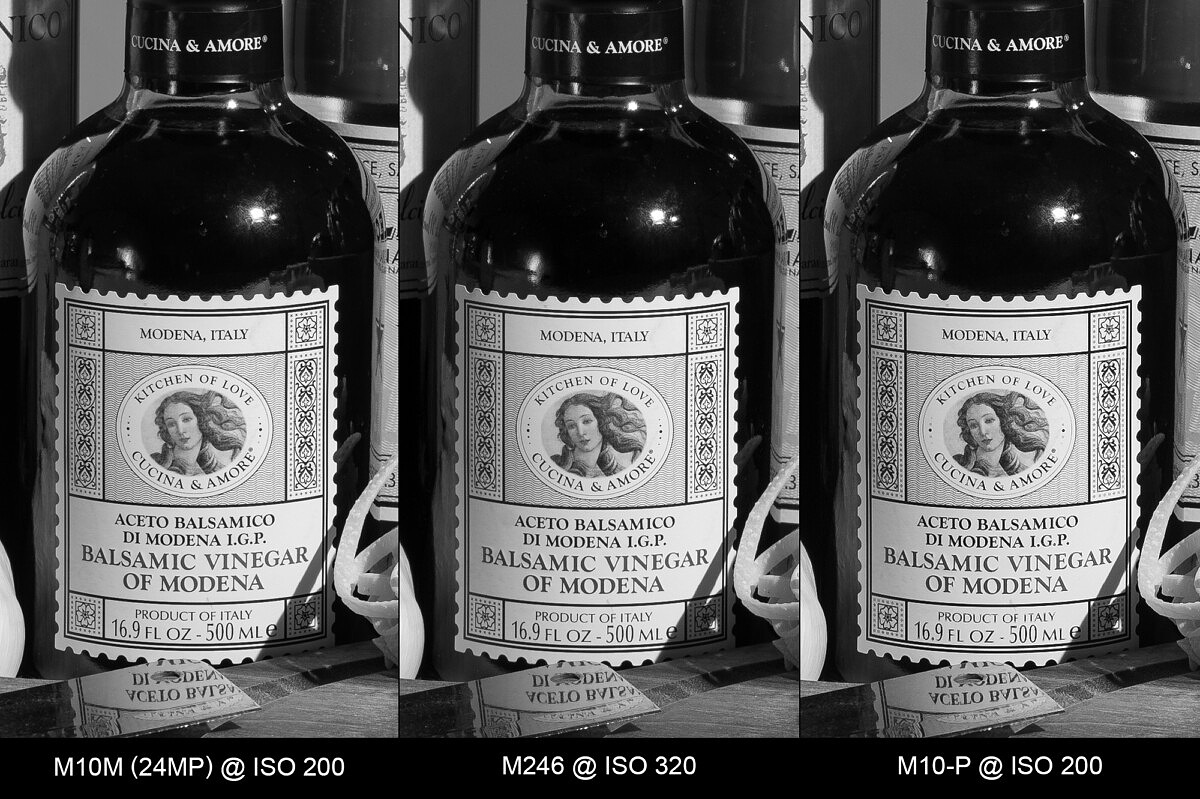
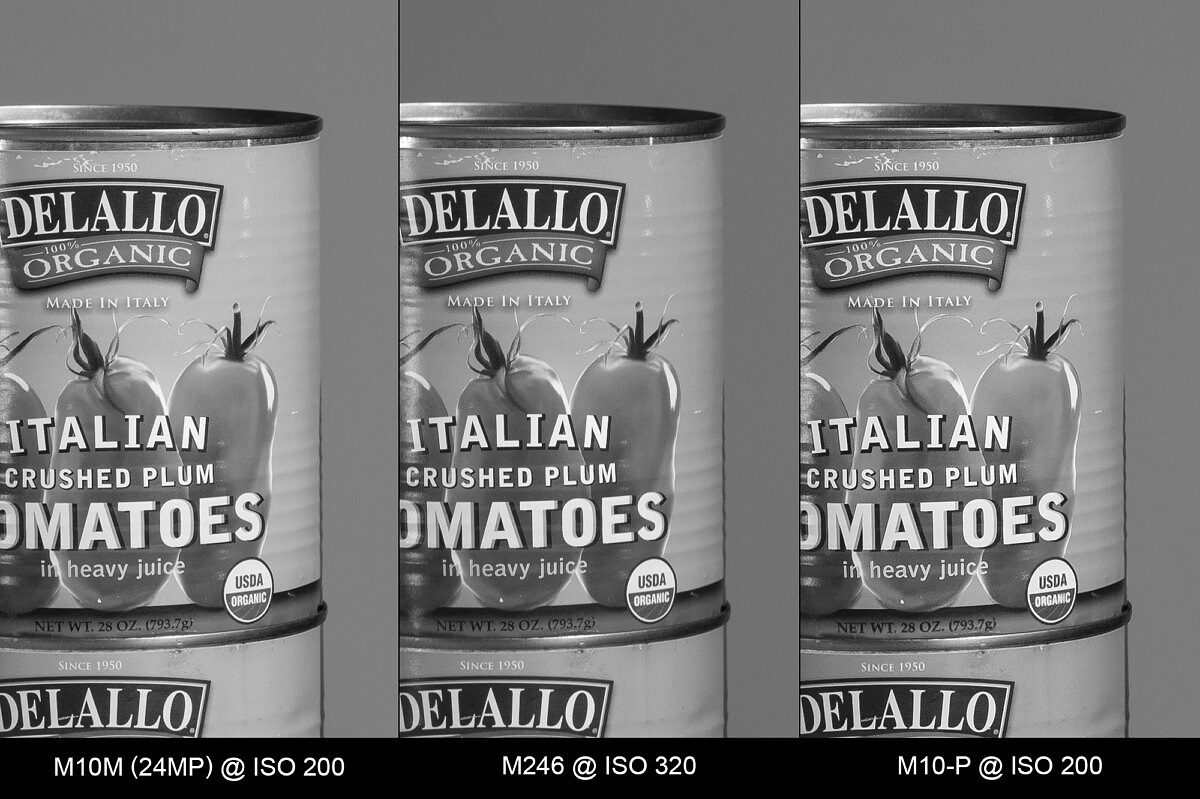
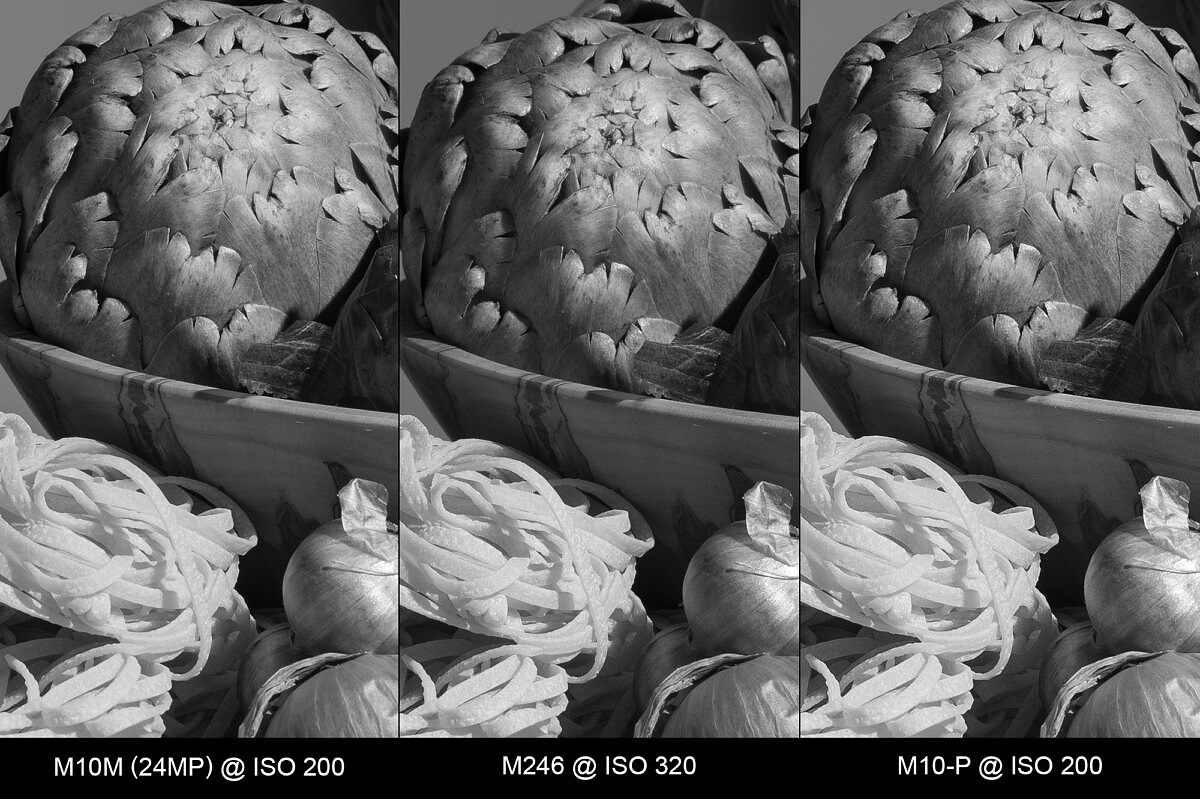
ISO 400
At ISO 400, all are still perfect. Detailed, smoothen.
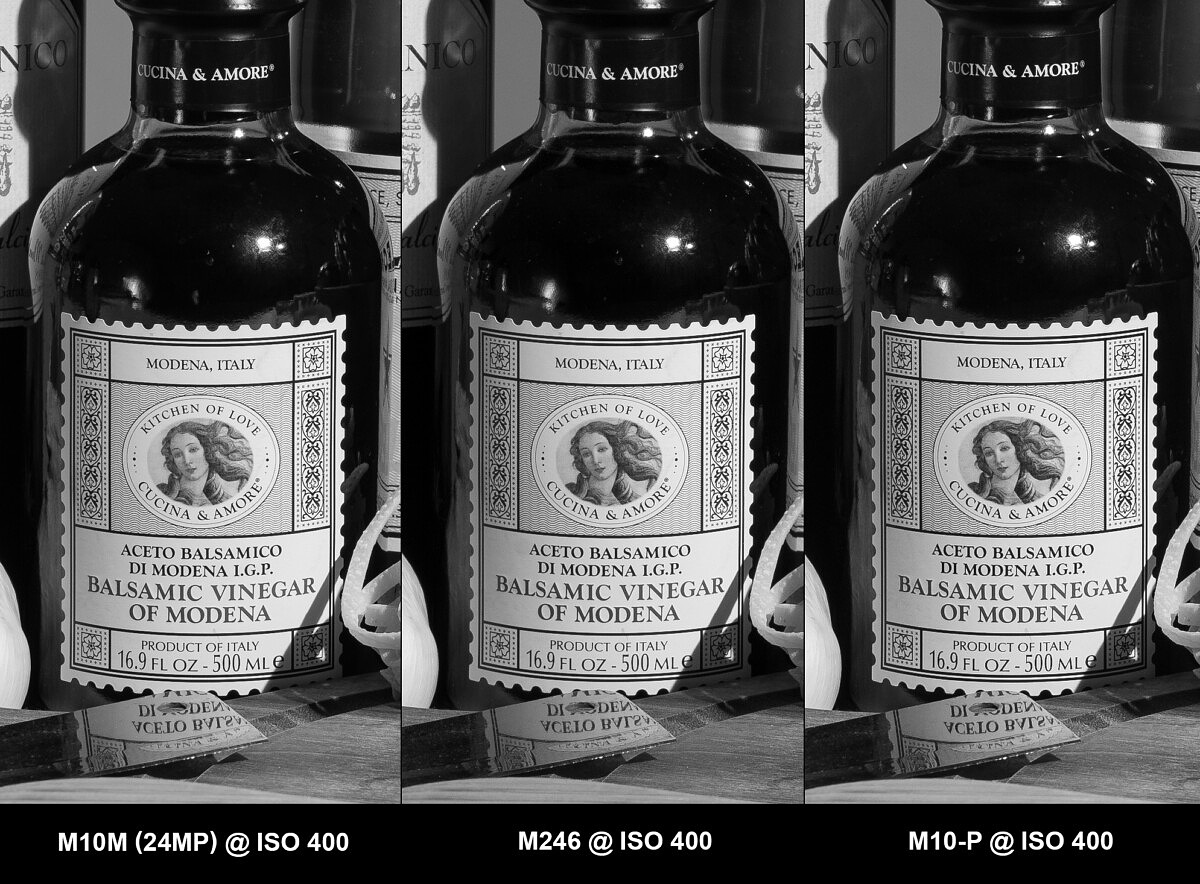
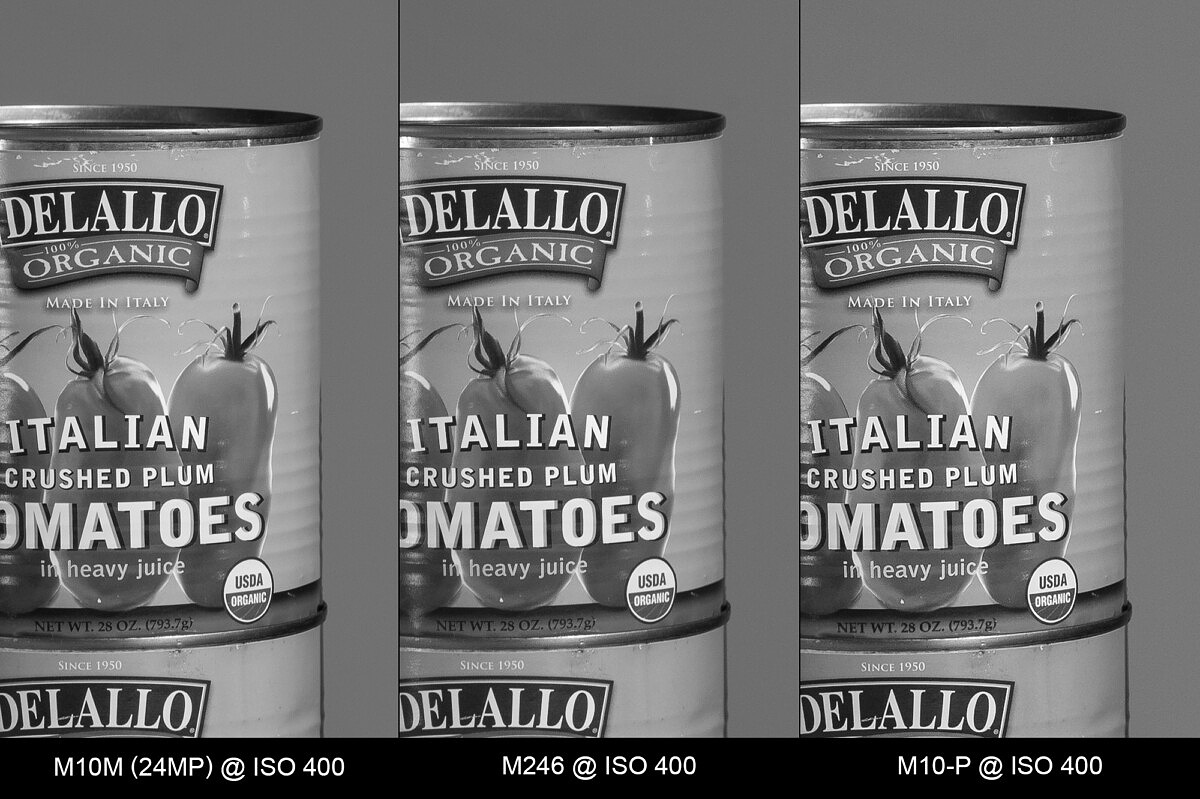
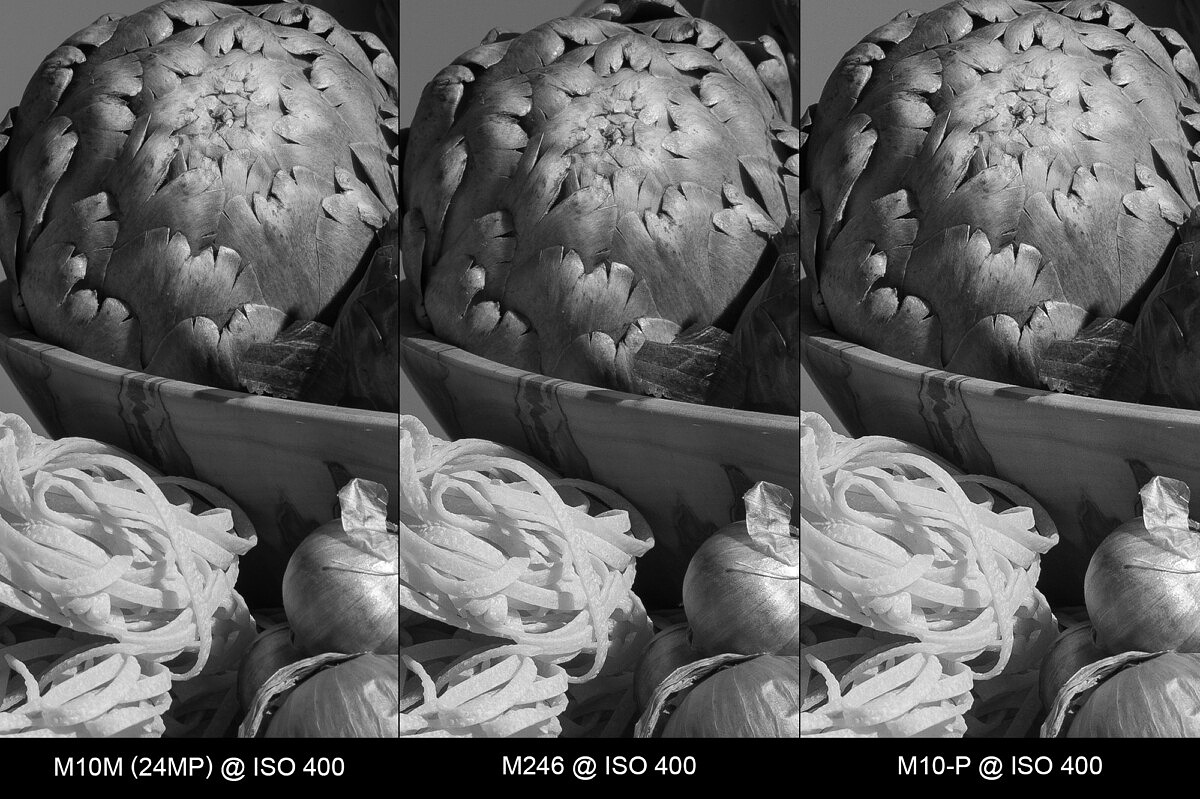
ISO 800
Same story at ISO 800. Almost no discernable loss of quality for whatever of the M cameras.
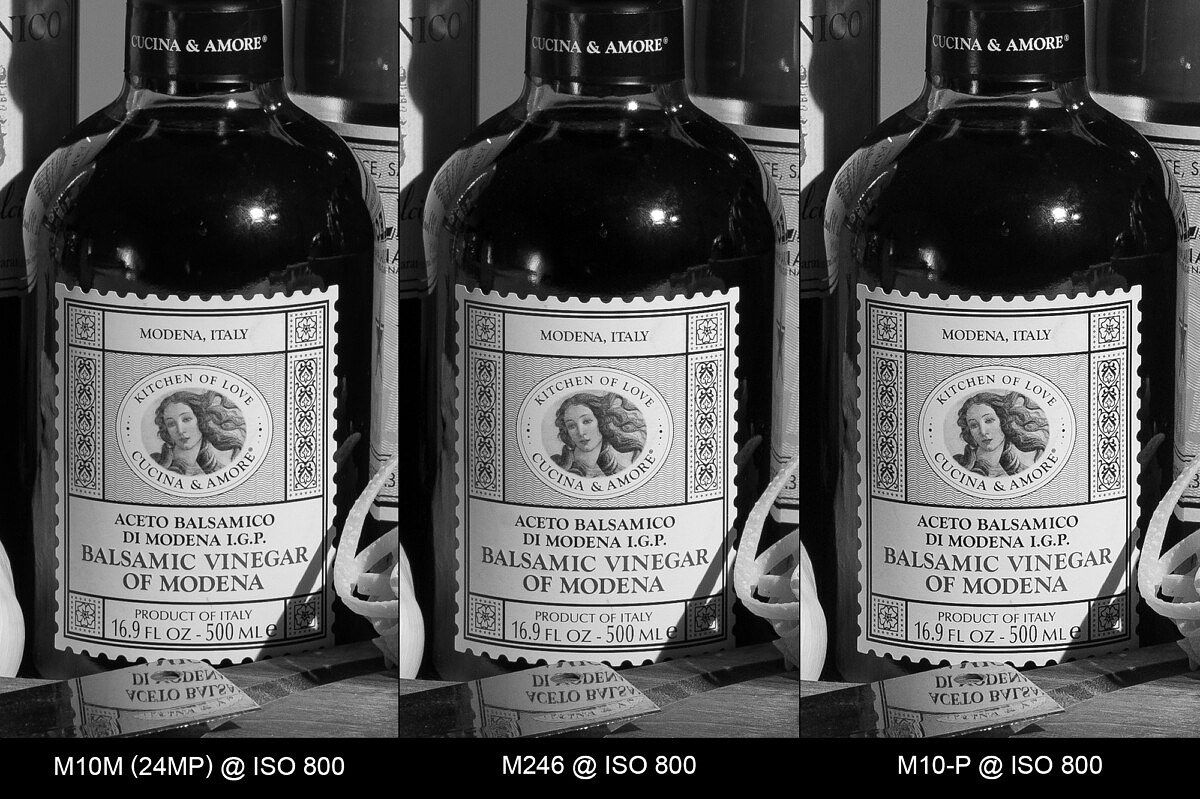
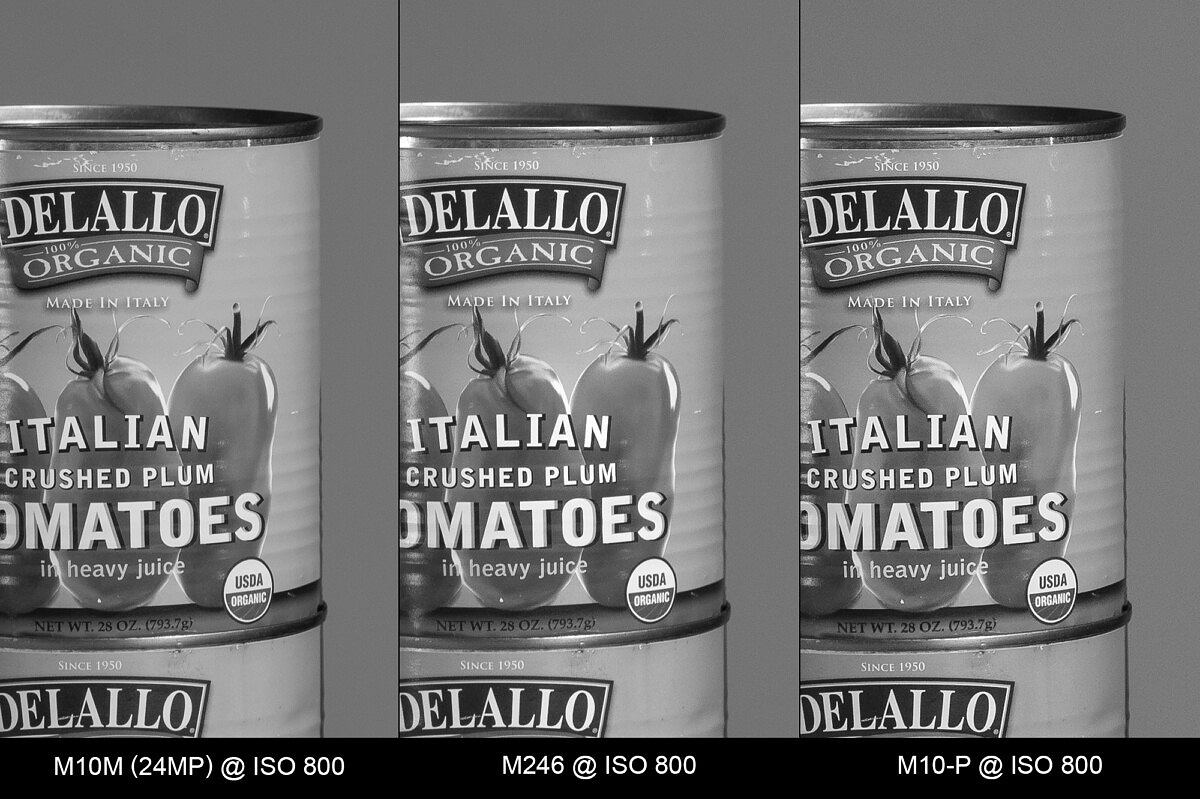
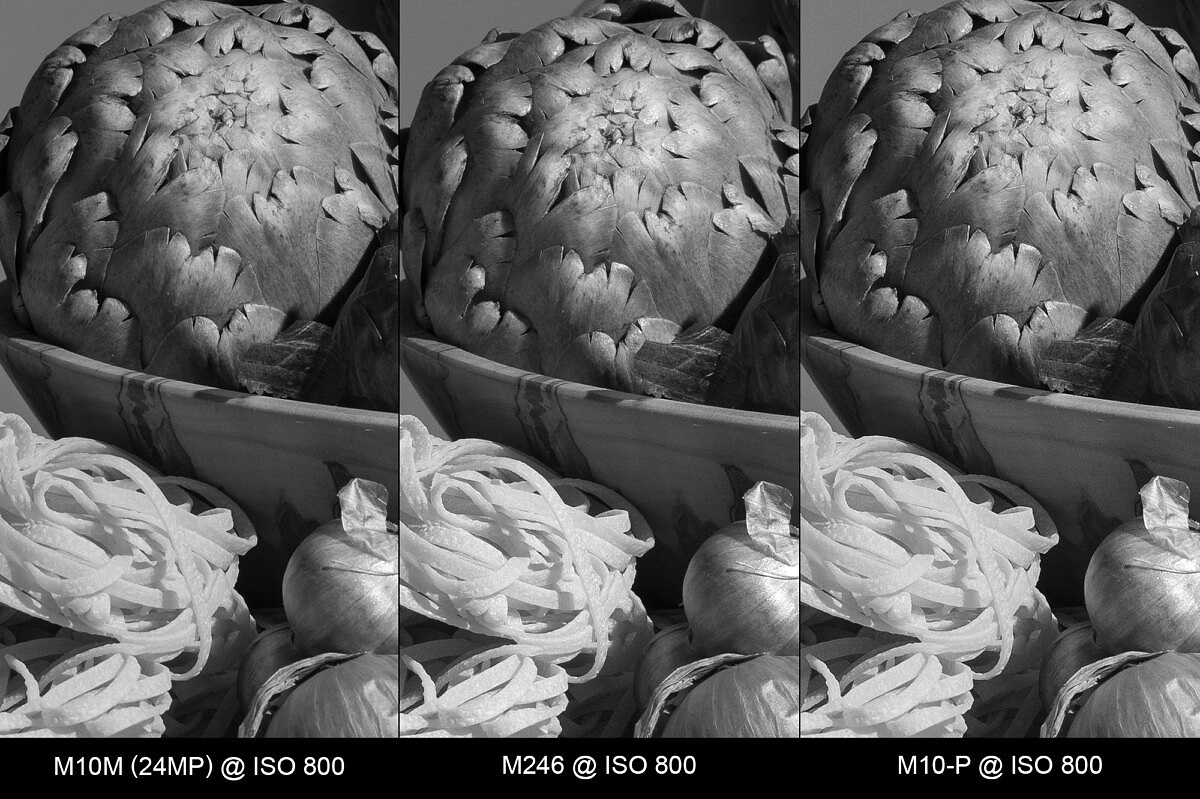
ISO 1600
Just the tiniest amount of noise is starting to be visible in the background. Interestingly, the M246 is the smoothest hither.
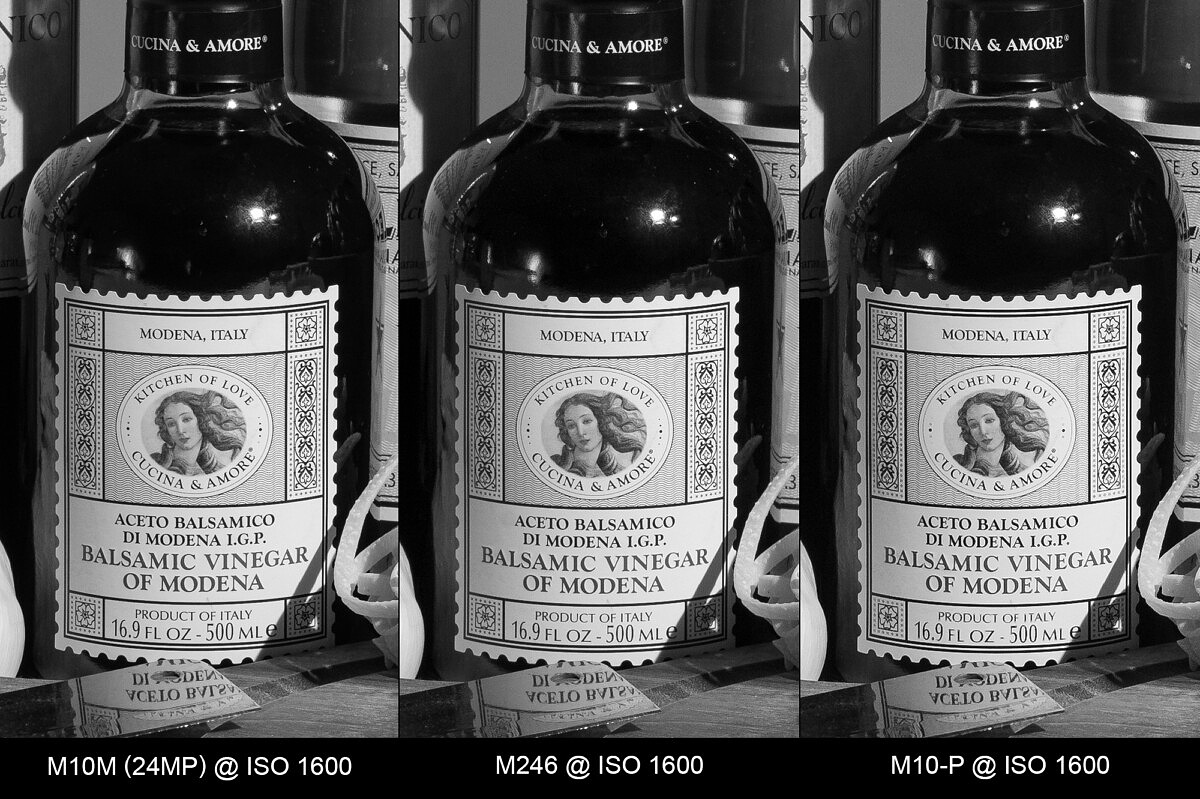
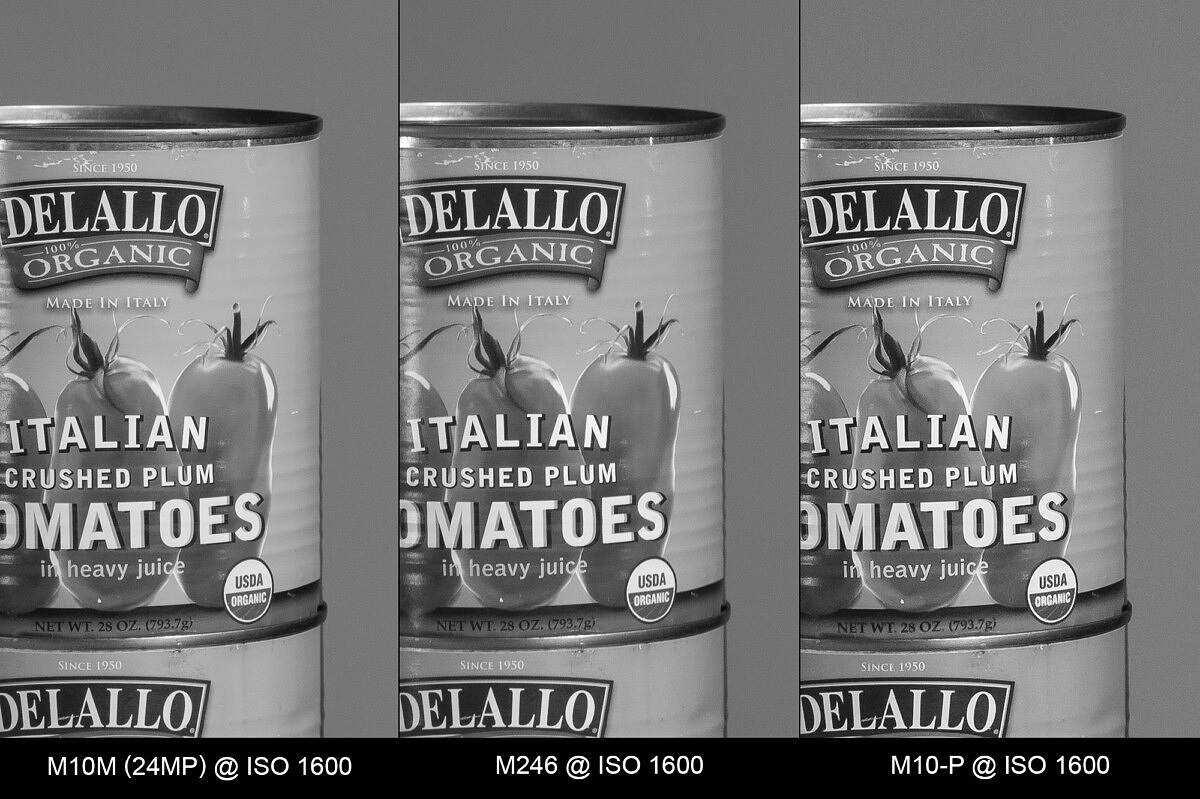
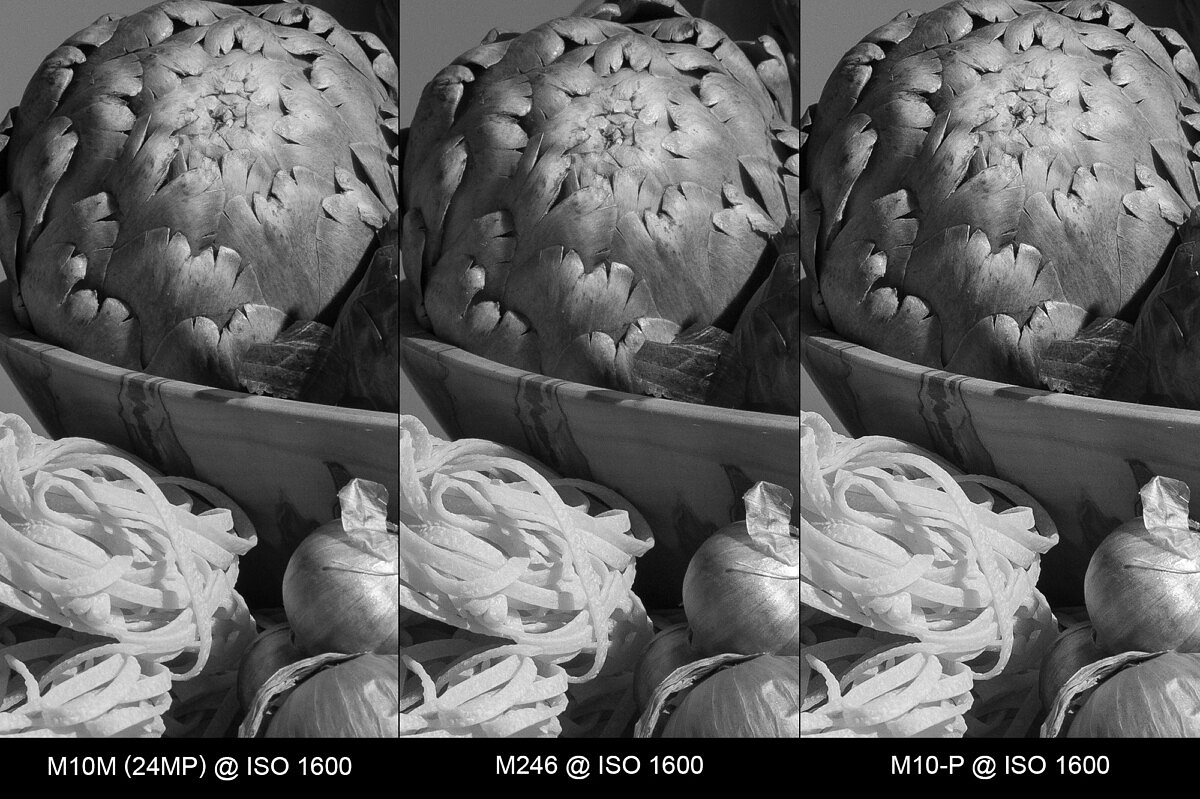
ISO 3200
Ane stop higher and the advantage seems to have shifted to the M10M's favor. Detail resolution and overall crispness looks just a bit improve than on the M246, simply still, the differences are minor.
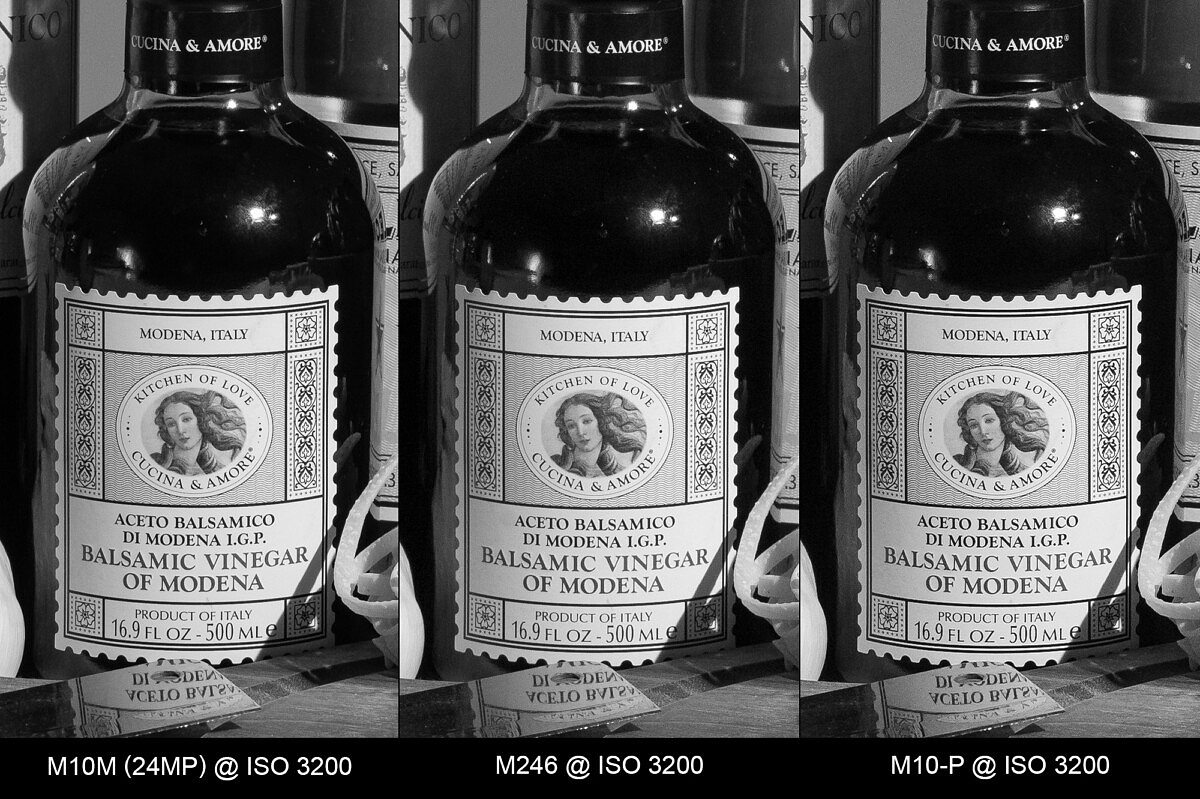

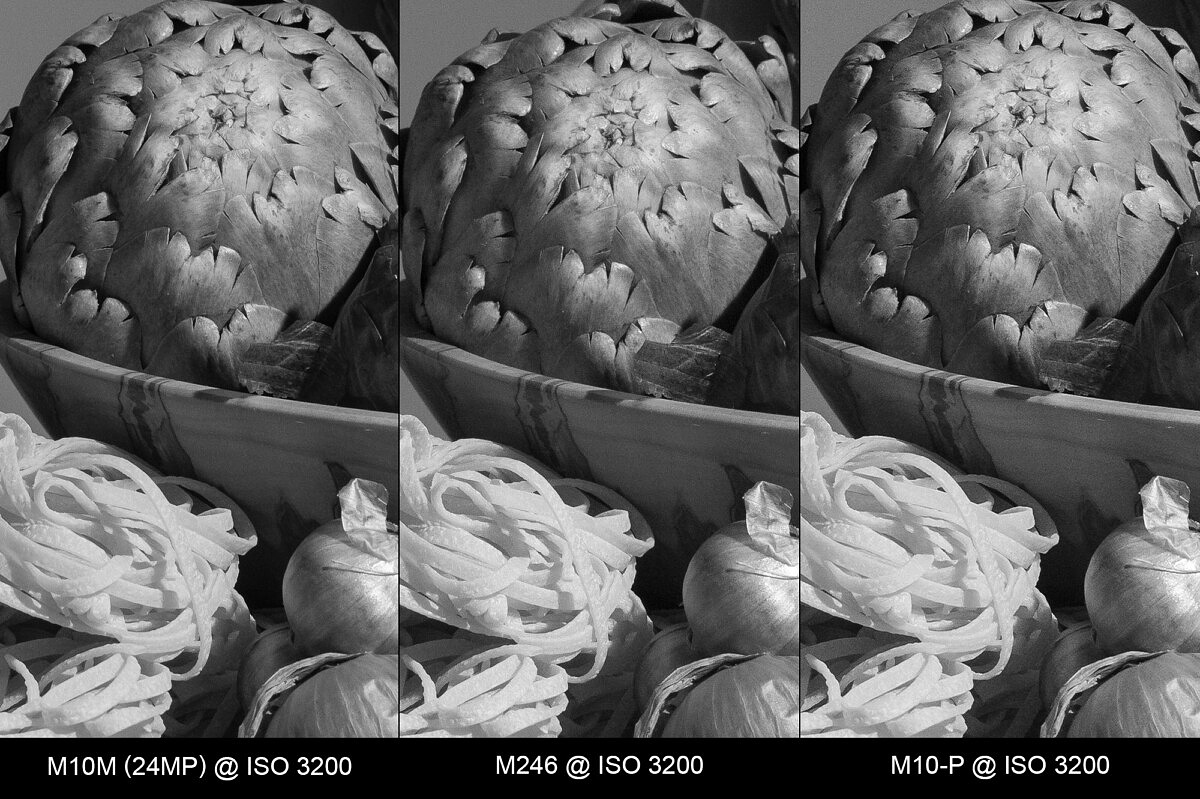
ISO 6400
All the K cameras are doing really well hither. Both Monochroms are nonetheless roughly on par, with the M10M continuing to resolve more detail. The M10-P is just starting to fall off from the other two.
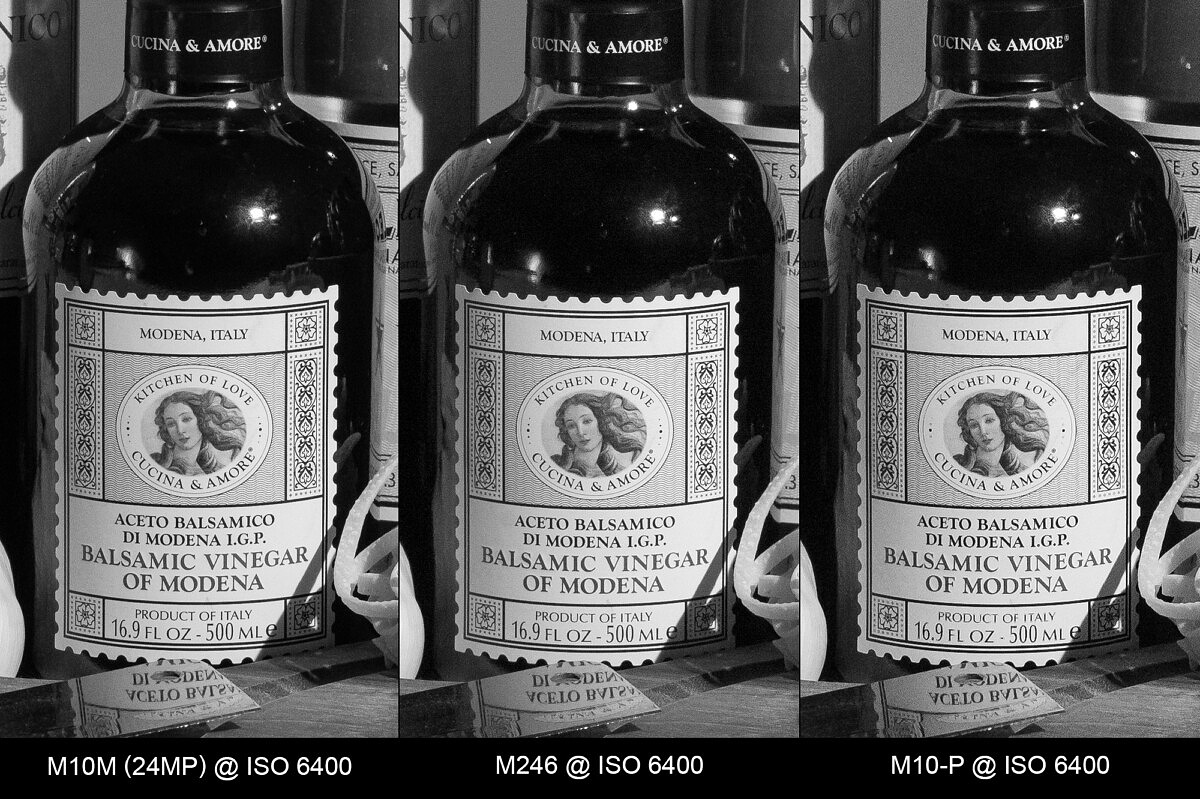
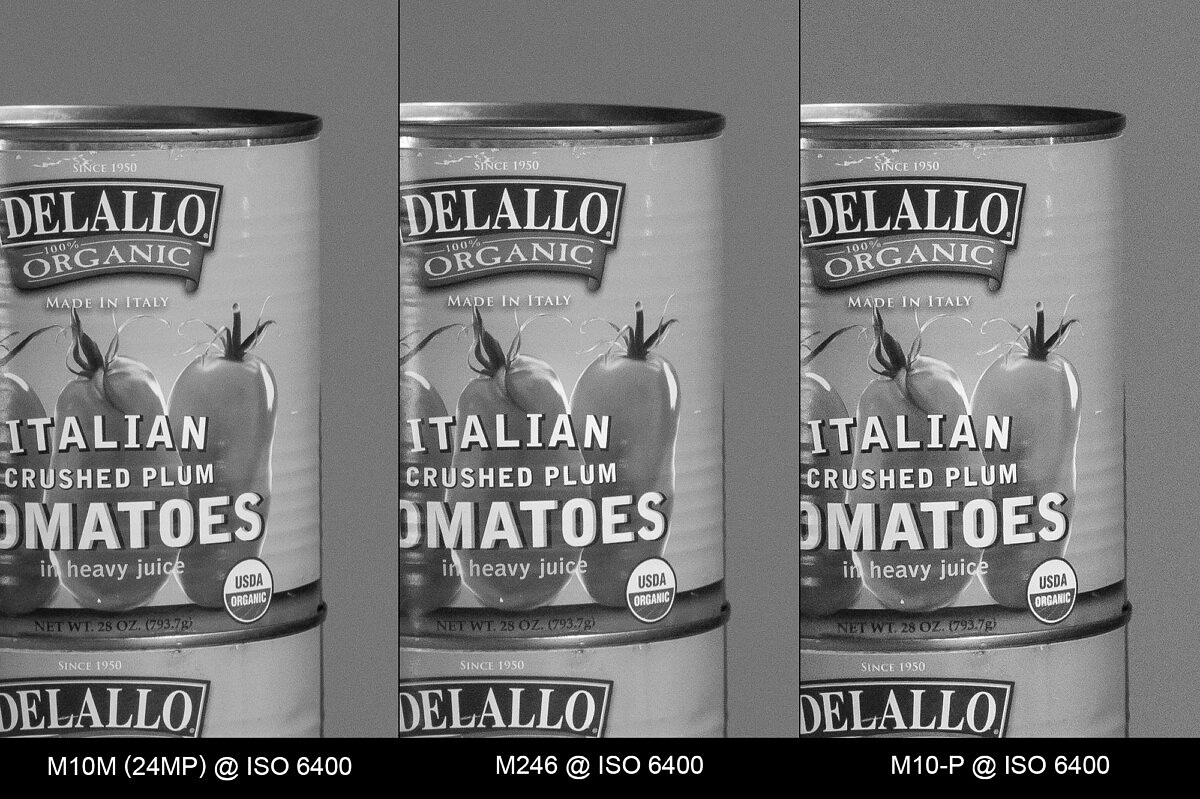
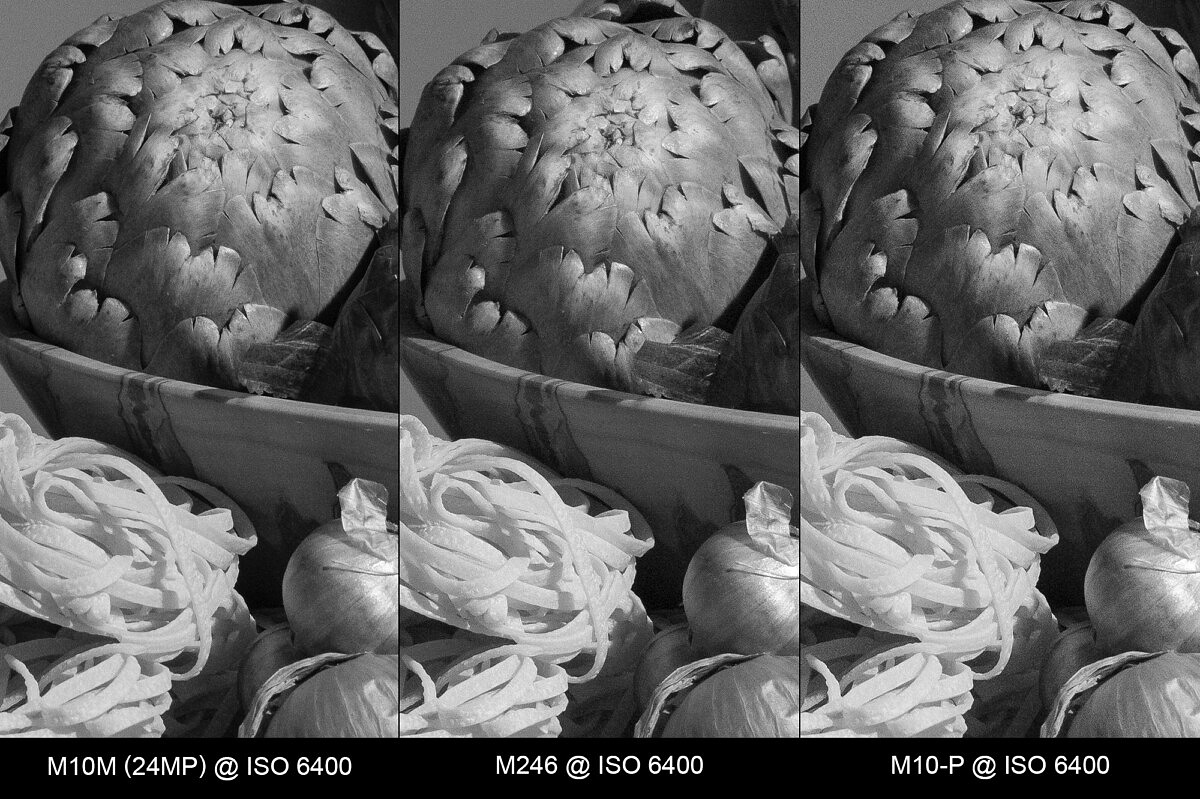
ISO 8000
Let'due south tedious things down a little. Instead of whole stops, we'll evaluate at i/three stop increments. The prototype quality volition dethrone much quicker now, so it's practiced to actually go a feel for the limits on each camera.
At ISO 8000, noise is tightly packed for all cameras, just more visible on the M10-P. The M10M is very slightly in the lead.
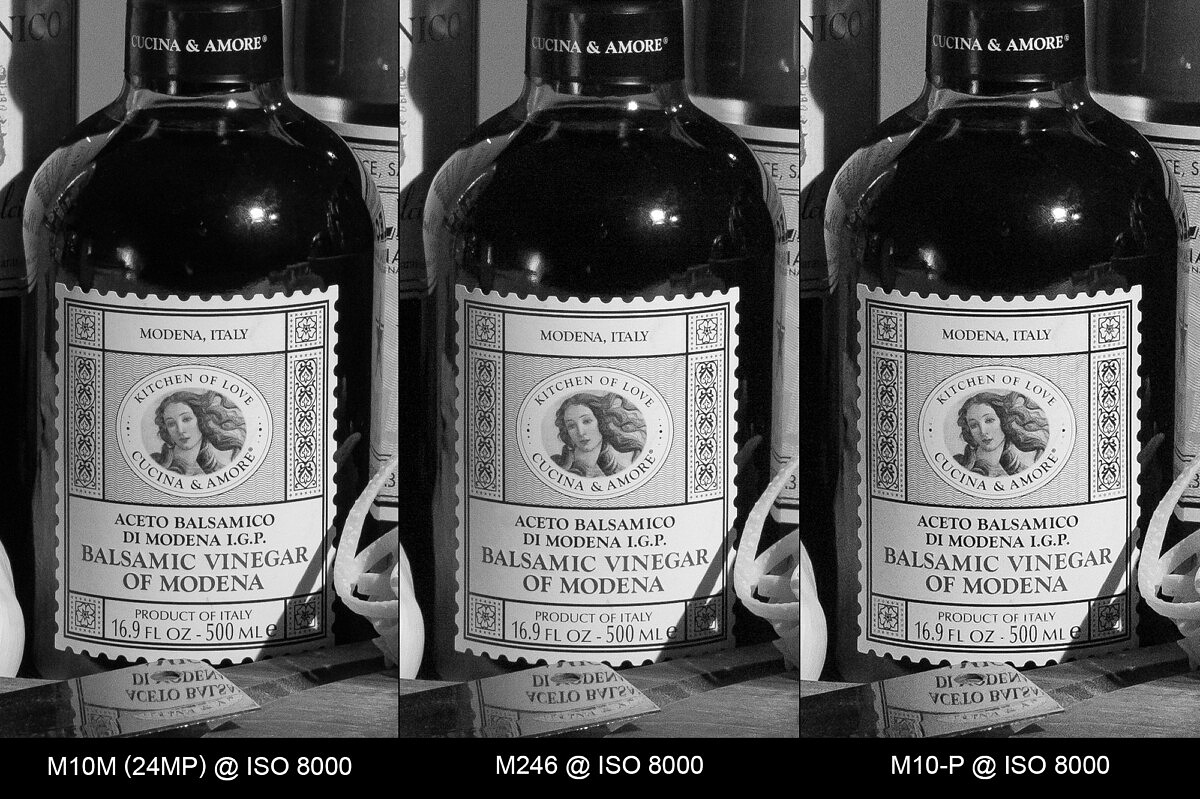
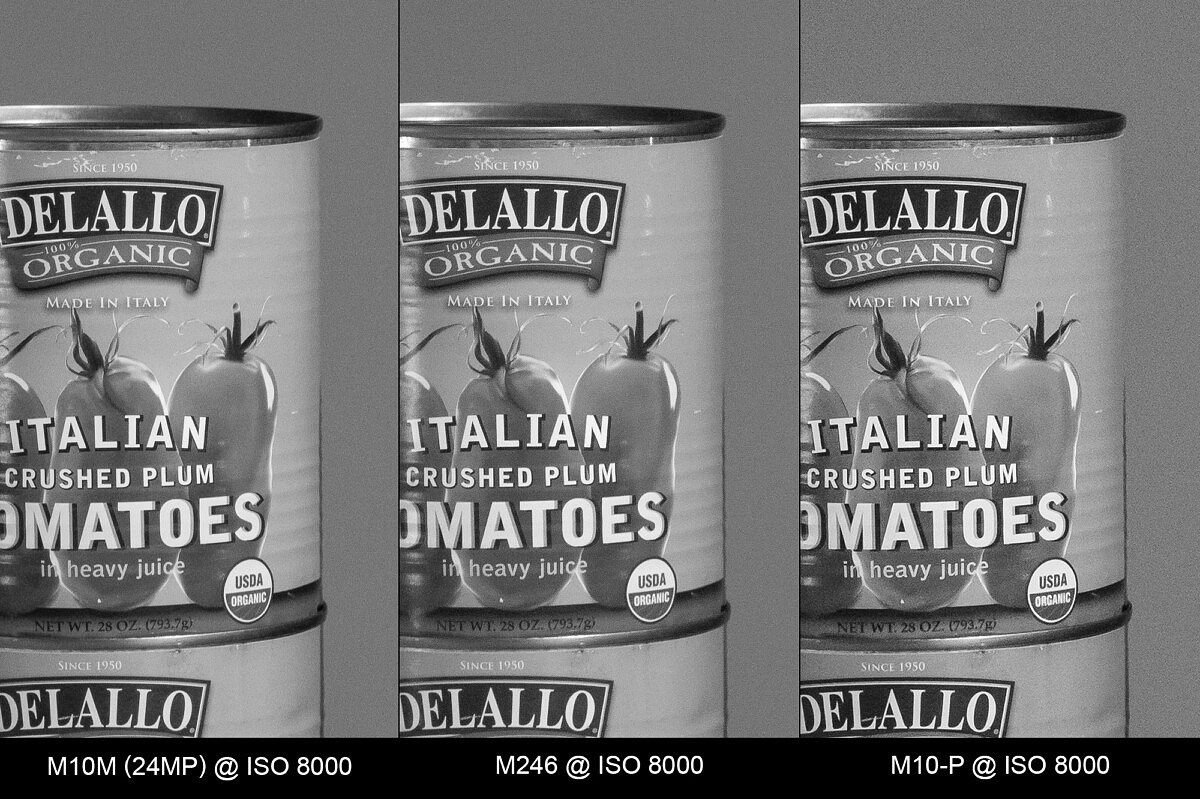
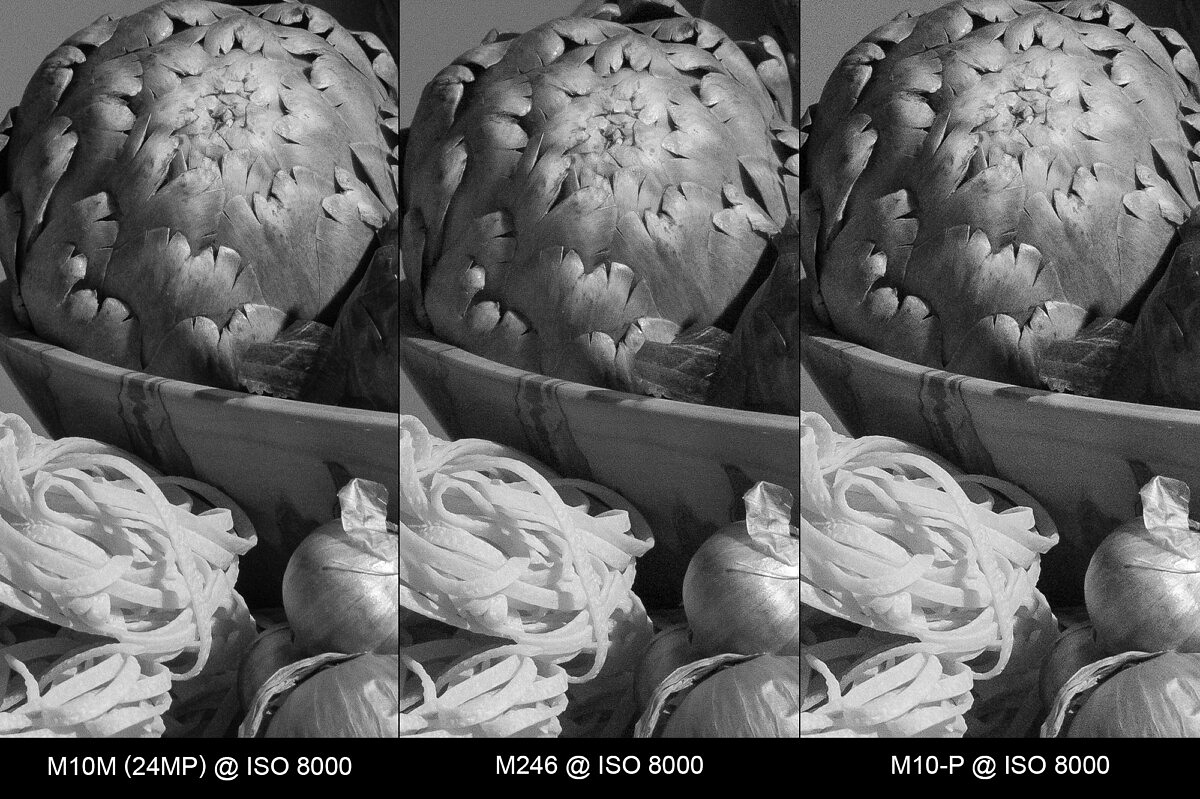
ISO 10000
The M246 appears to overtake the M10M with slightly less noise, only at the expense of some detail. And while the M10-P is picking up incrementally more noise, details are still precipitous.
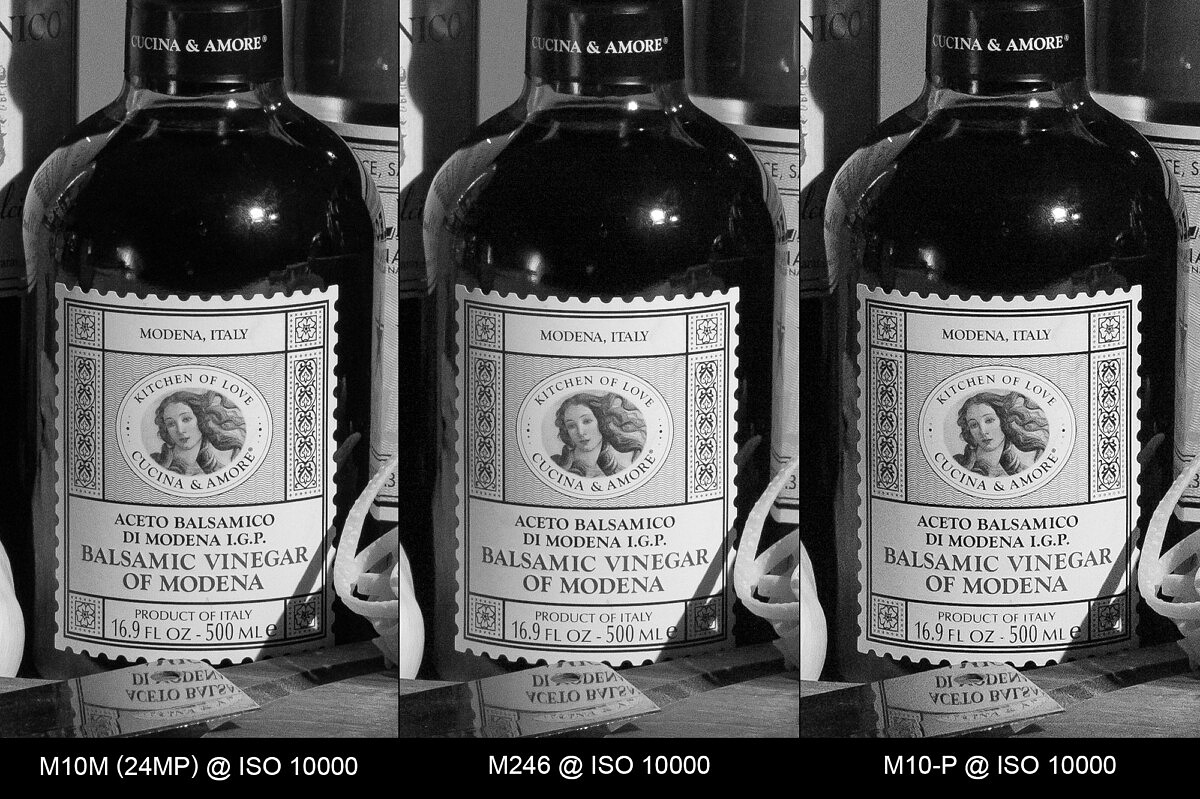
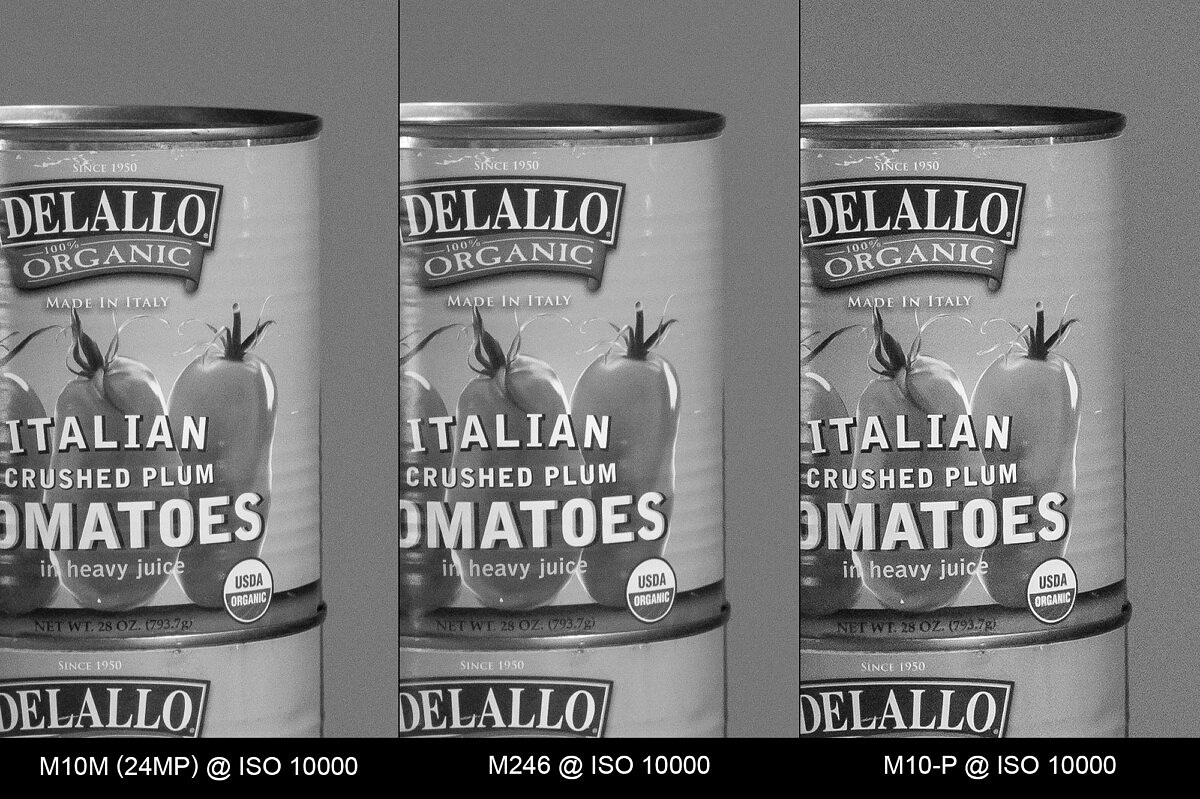
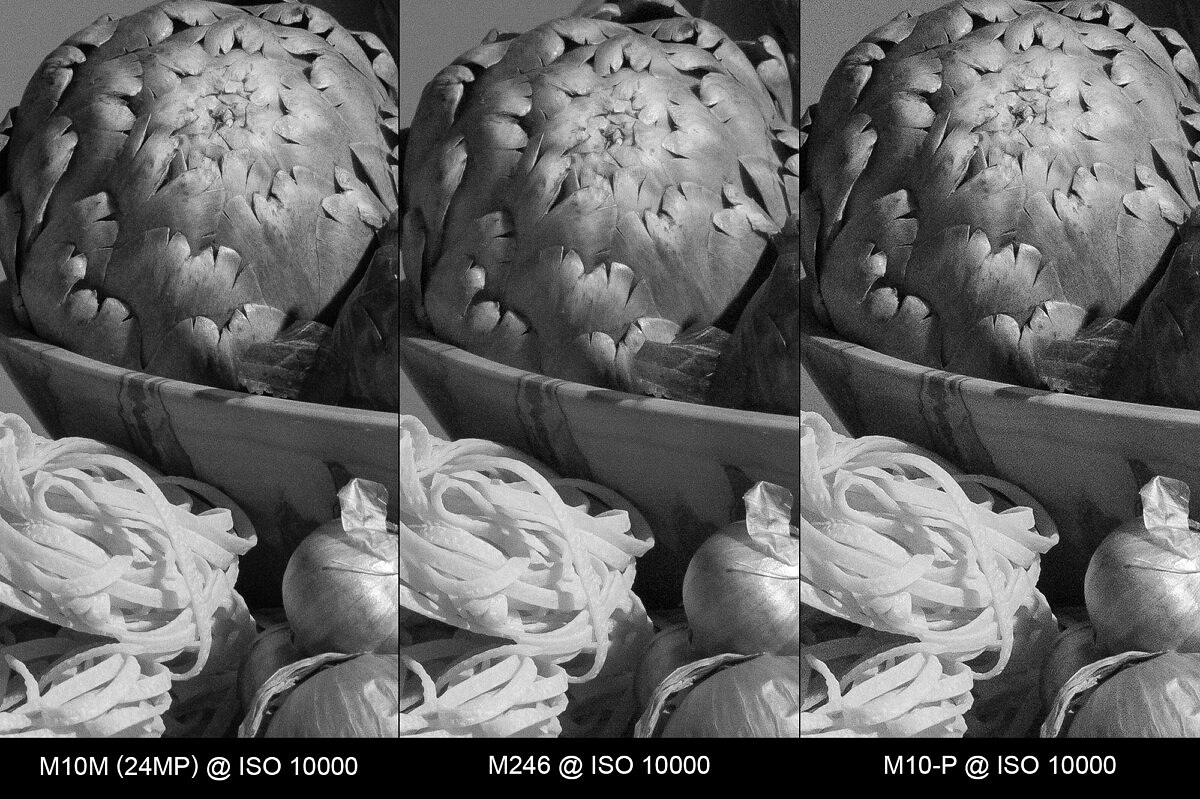
ISO 12500
Near the same story as ISO 10000, only the M246 seems even better. Could the older M246 actually be besting the newer M10M?
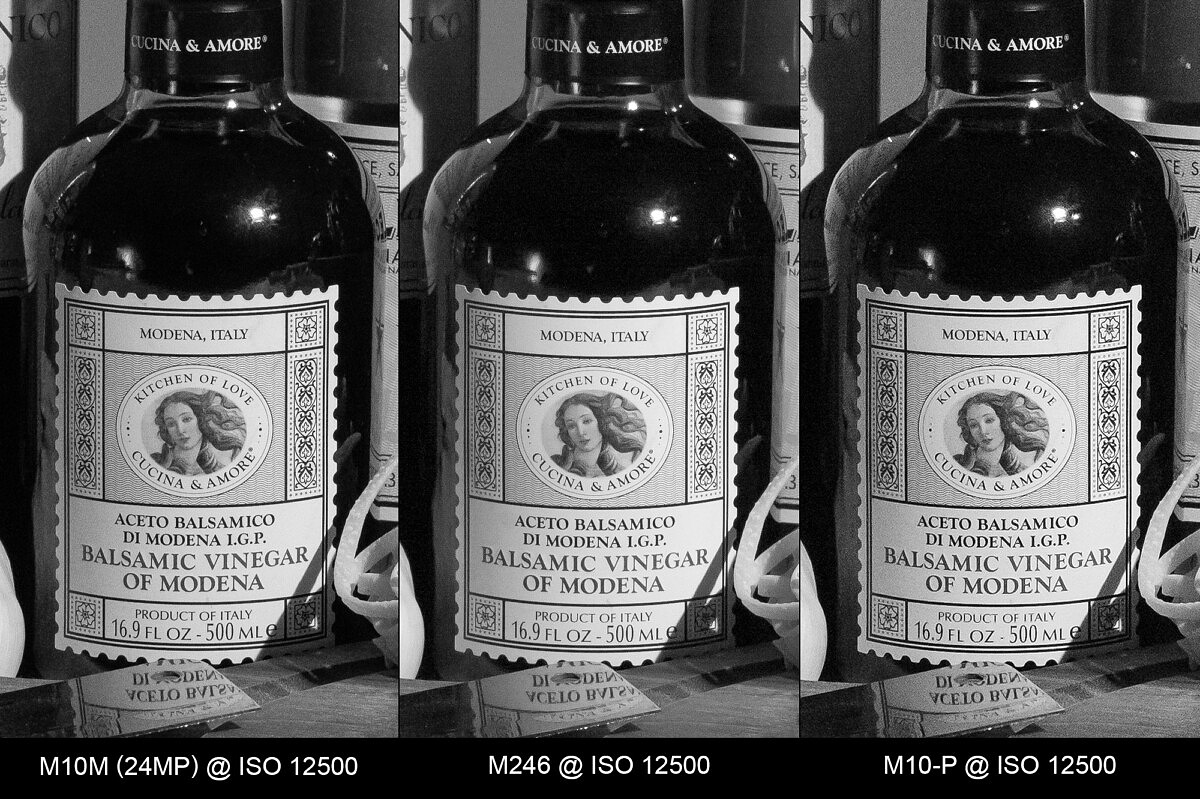
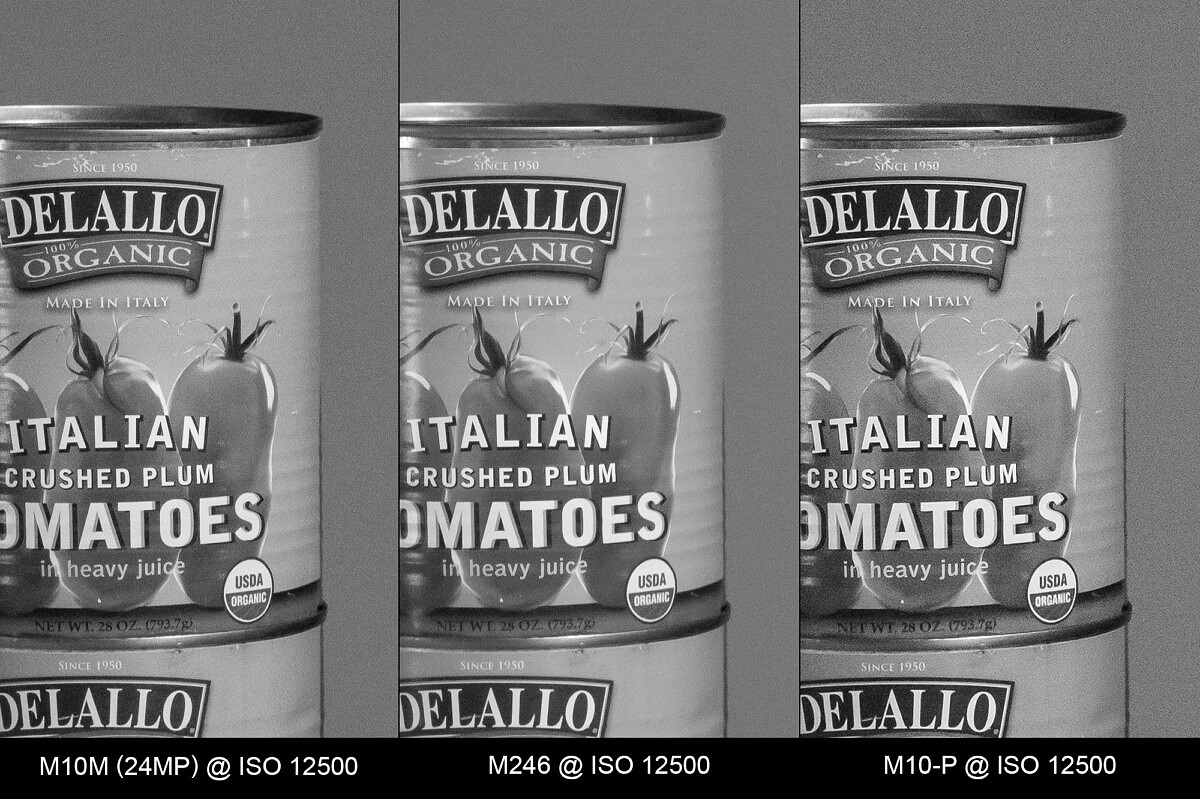
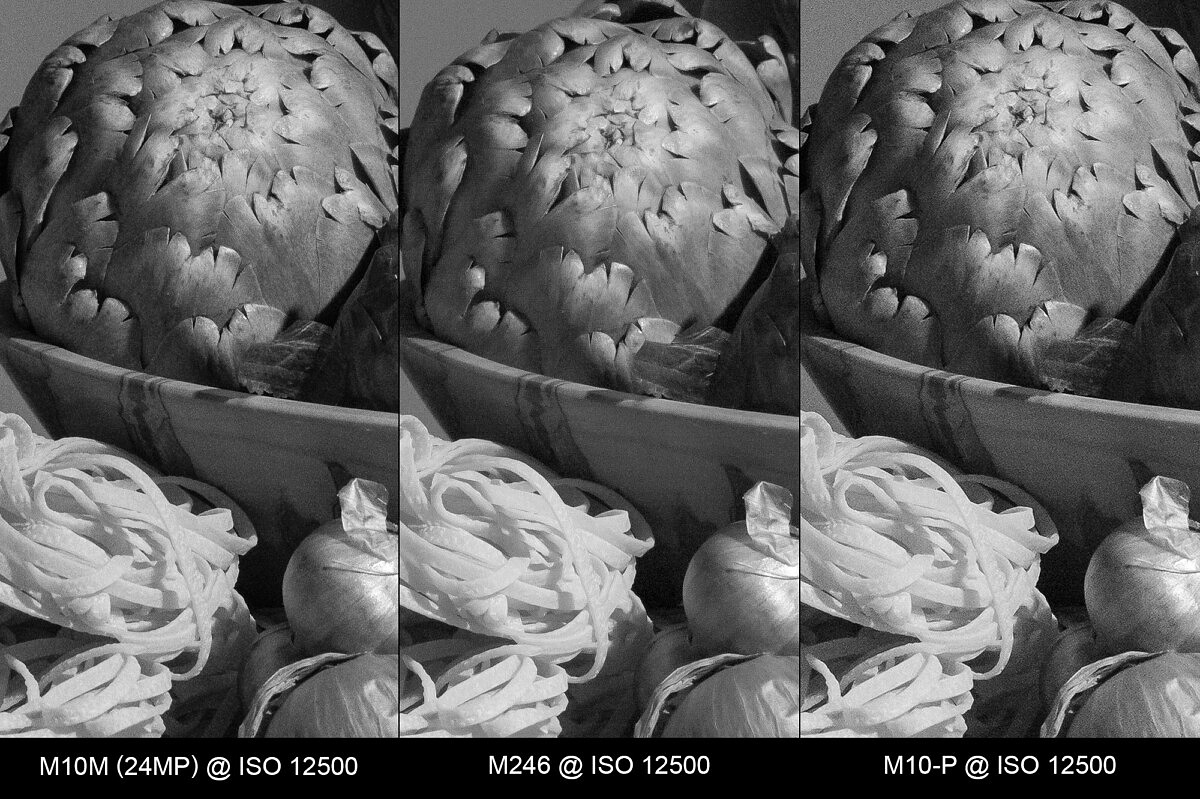
ISO 16000
Unfortunately, the M246 has no i/3 stop increments between ISO 12500 and 25000, and then for 16000, we'll compare the M10M and M10-P to the M246 at ISO 12500.
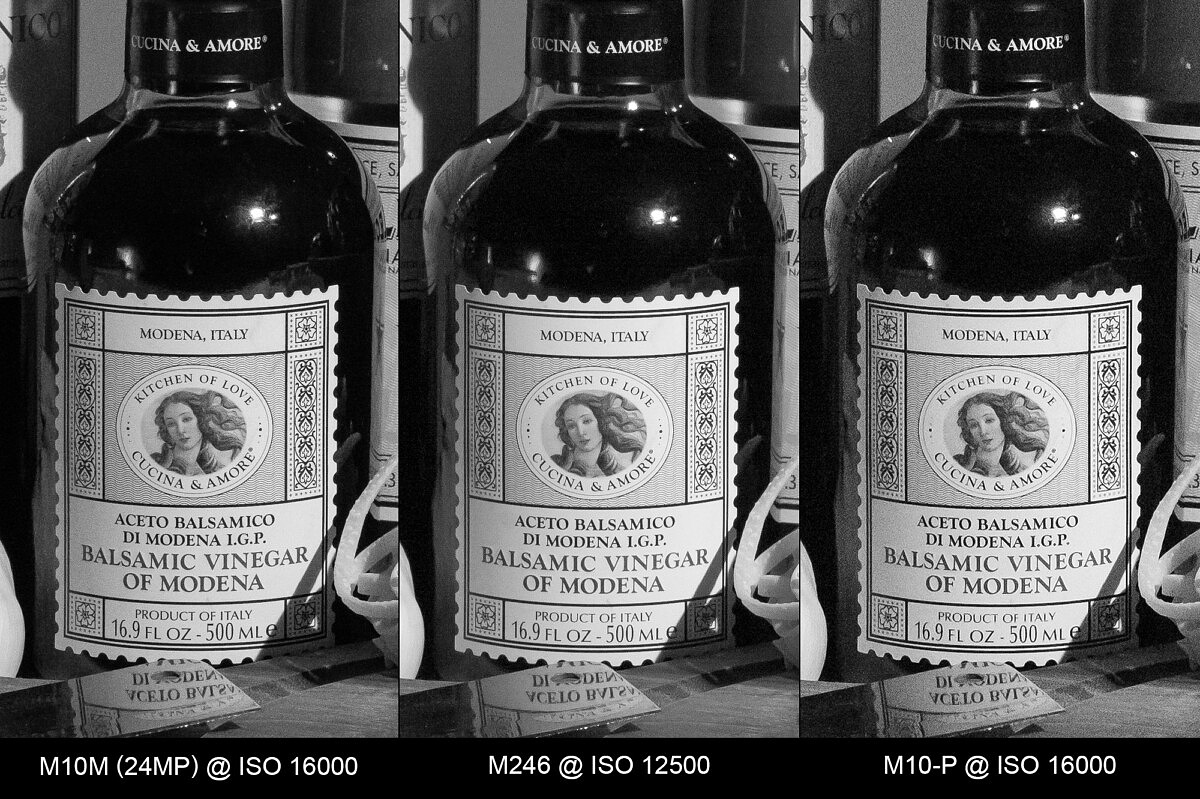
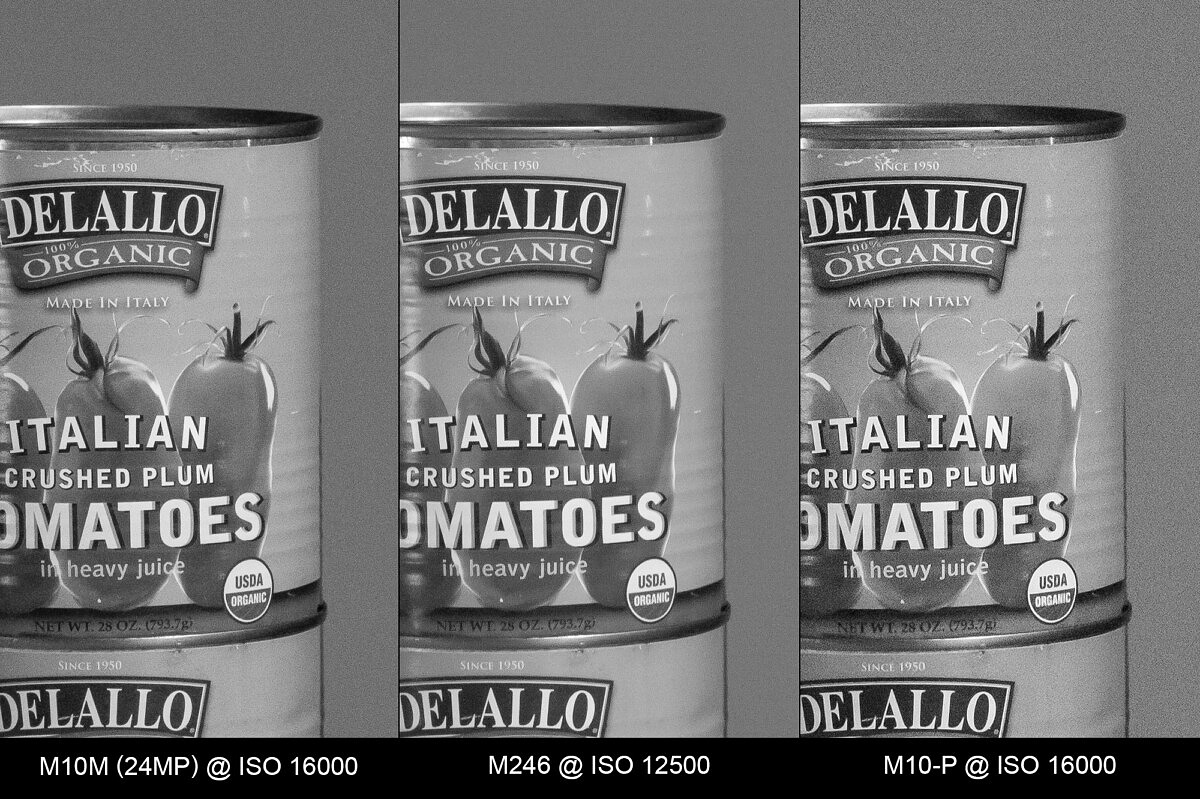
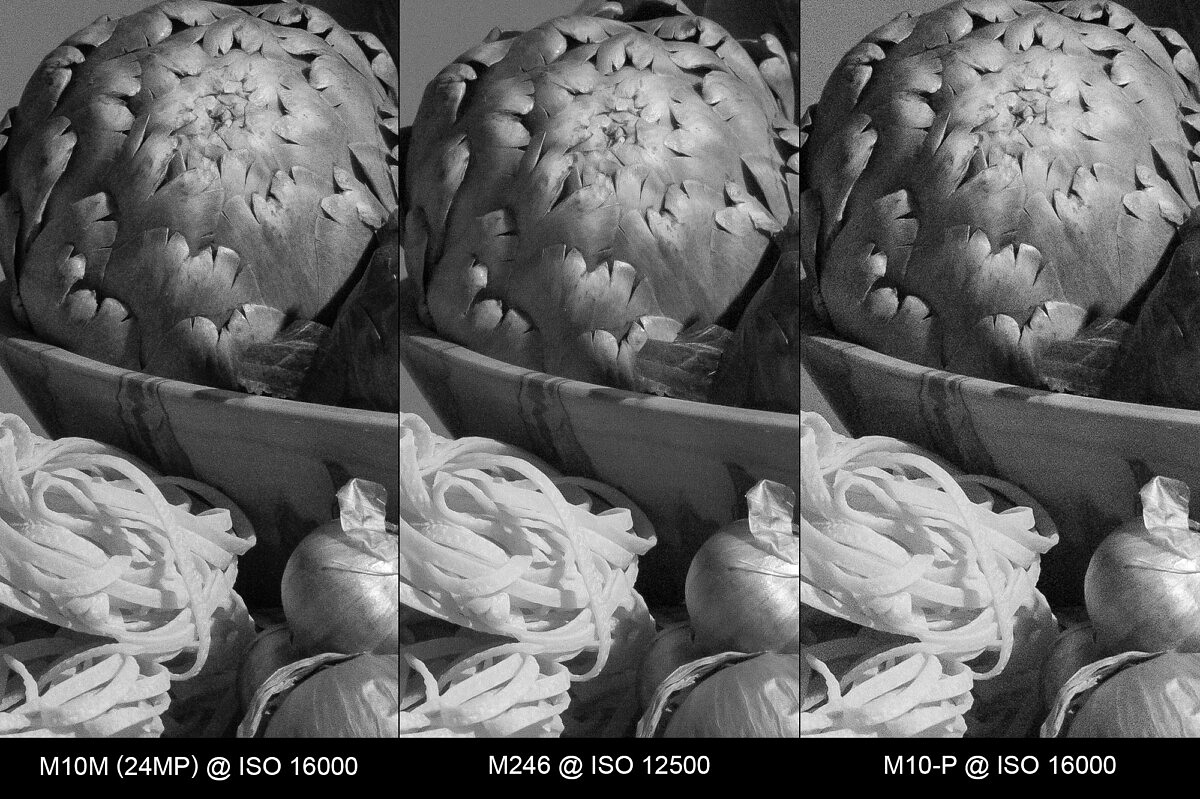
ISO 20000
Just as in the last match-upwards, at ISO 20000, we take to compare to the M246 at ISO 12500. The M10M seems to be holding steady, merely the M10-P seems to be displaying more noise.
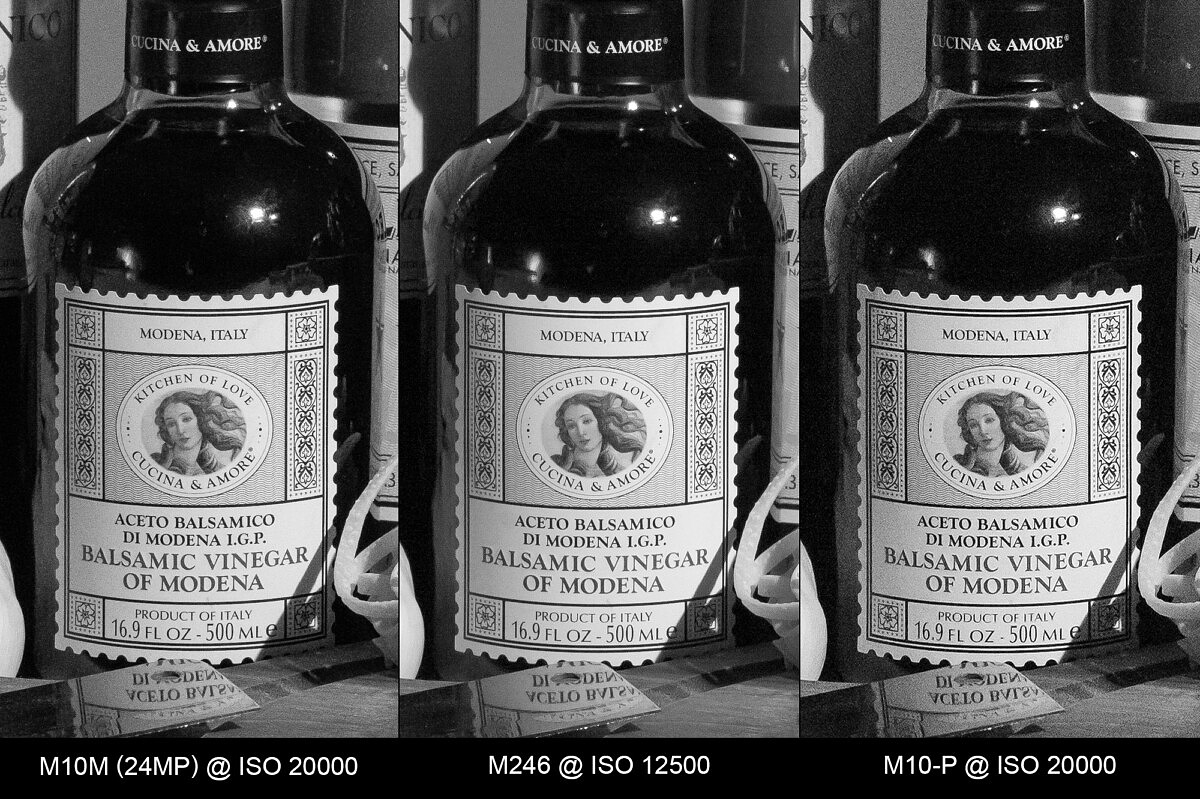
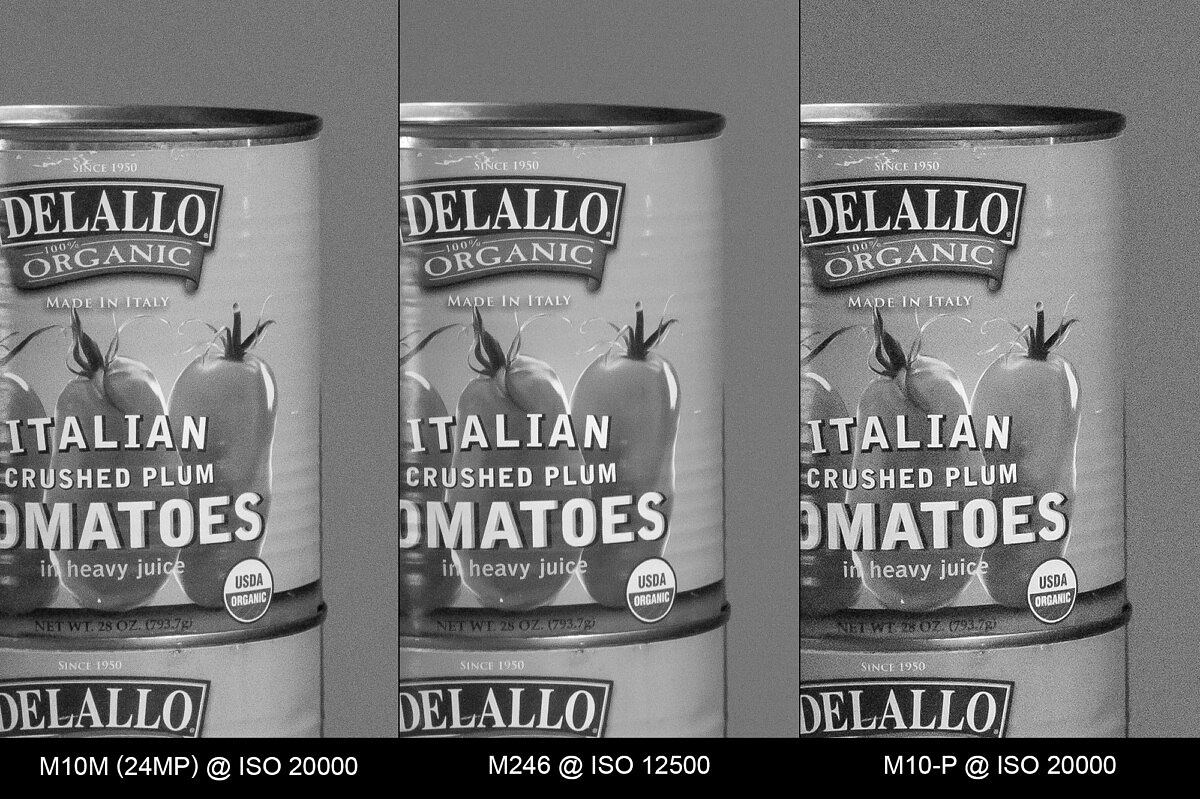
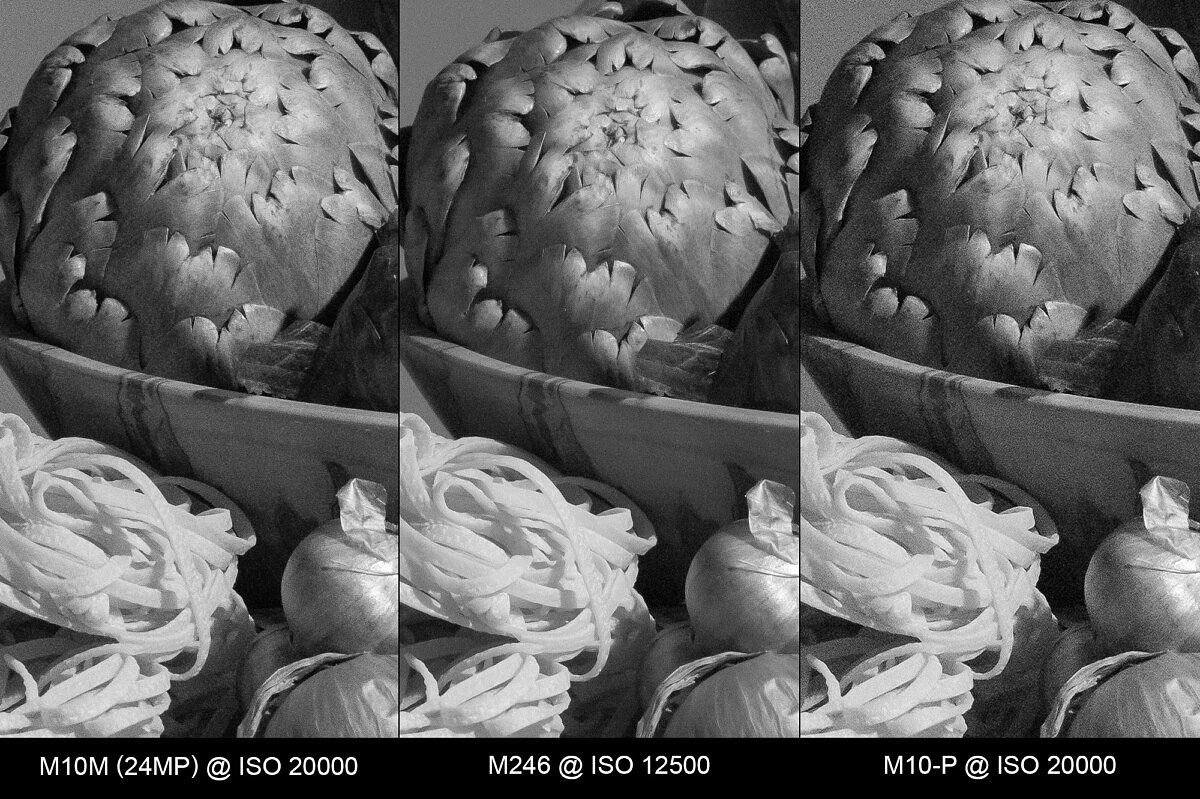
ISO 25000
We've hit the top of the ISO range on the M246, just yet accept one more stop on the M10-P and two stops more than on the M10 Monochrom. From hither on out, the max 25000 setting will be displayed for the M246. This will aid us see how much improvement the M10 Monochrom actually has.
Now, we're starting to run across some really interesting differences in how these cameras perform near or at their limits. The M246, while still exhibiting a very clean prototype, is doing so at the expense of detail. Image contrast has too dropped, resulting in a dull appearance. The M10-P, on the other mitt, is maintaining dissimilarity and detail, only at the expense of more pronounced noise. The M10M takes the best of both, with low racket and astonishing item clarity.
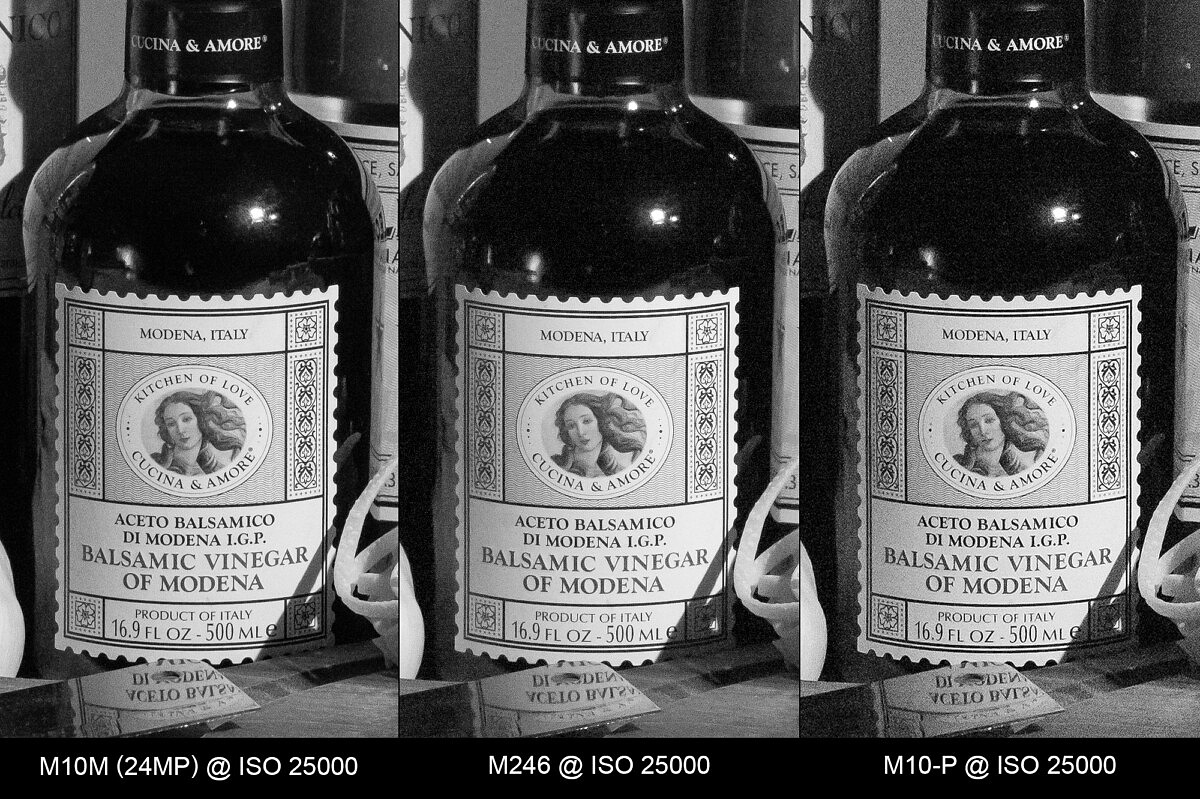
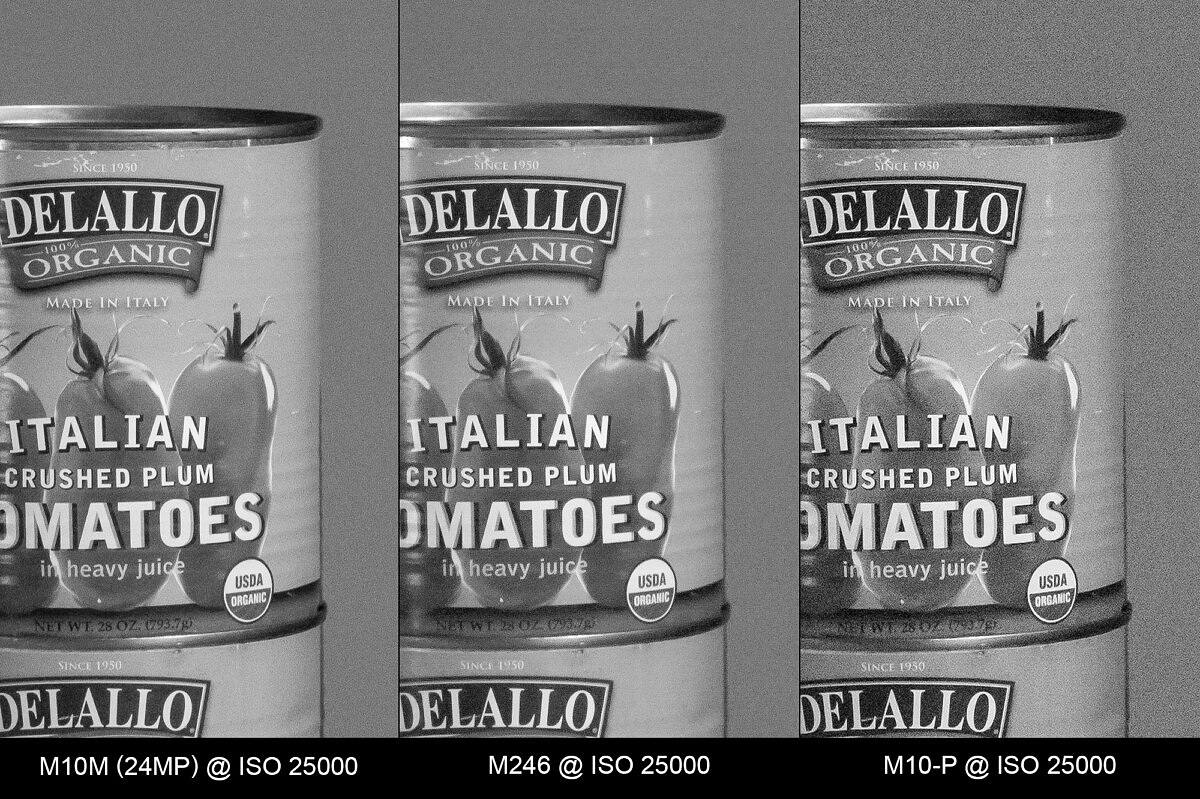
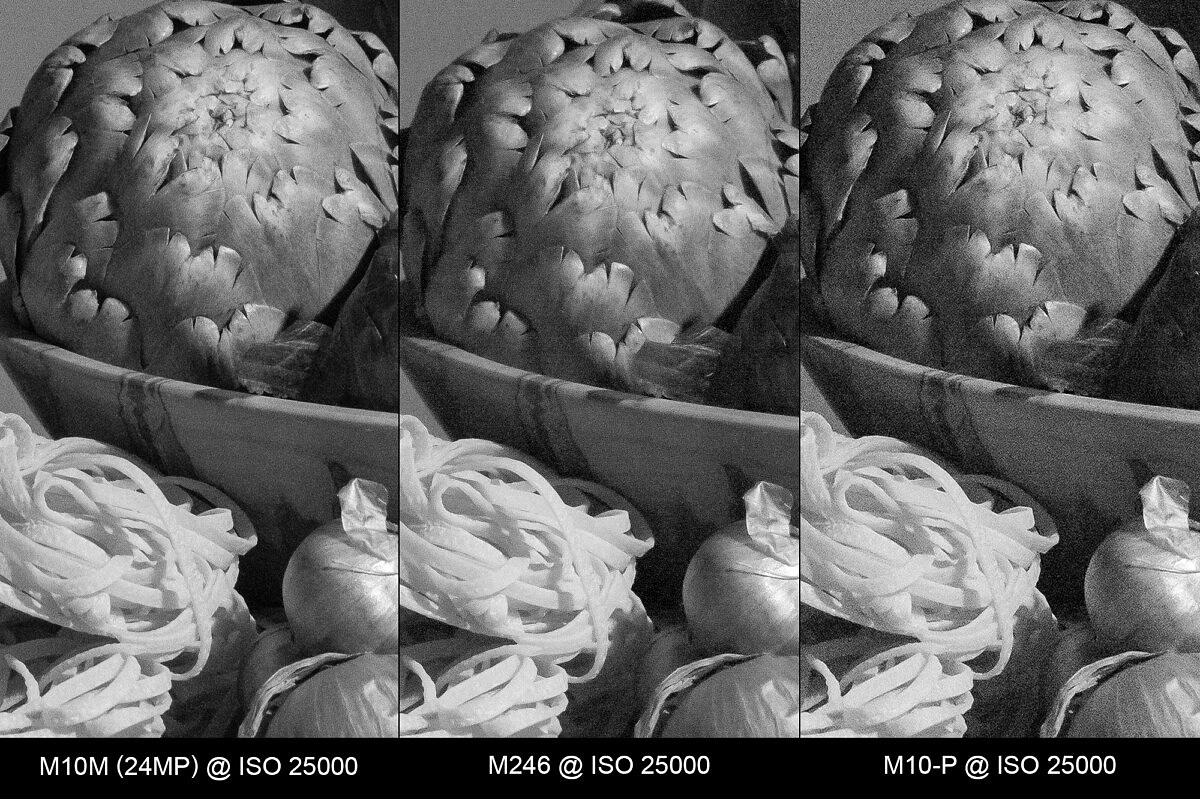
ISO 32000
The M10 Monochrom still looks slap-up at ISO 32000, even compared to the M246 at ISO 25000. The M10-P seems to have more left only is getting very noisy compared to its Monochrom cousins.
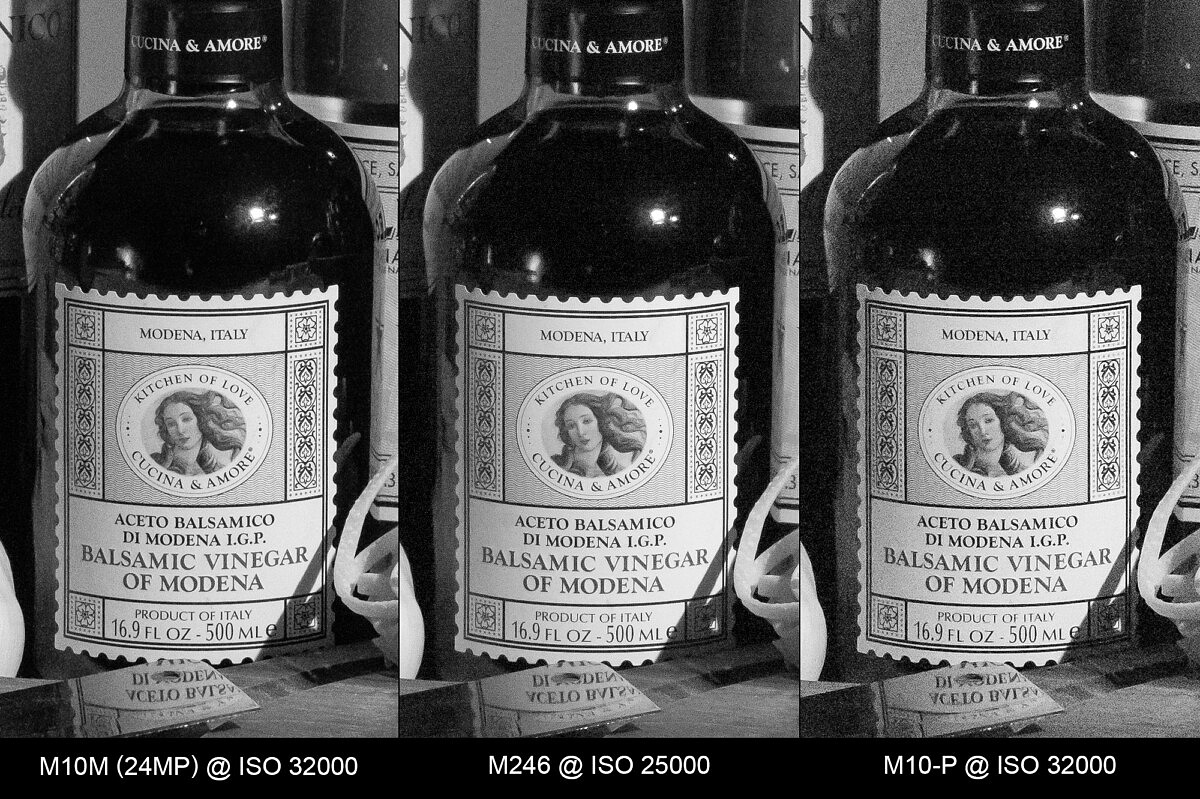
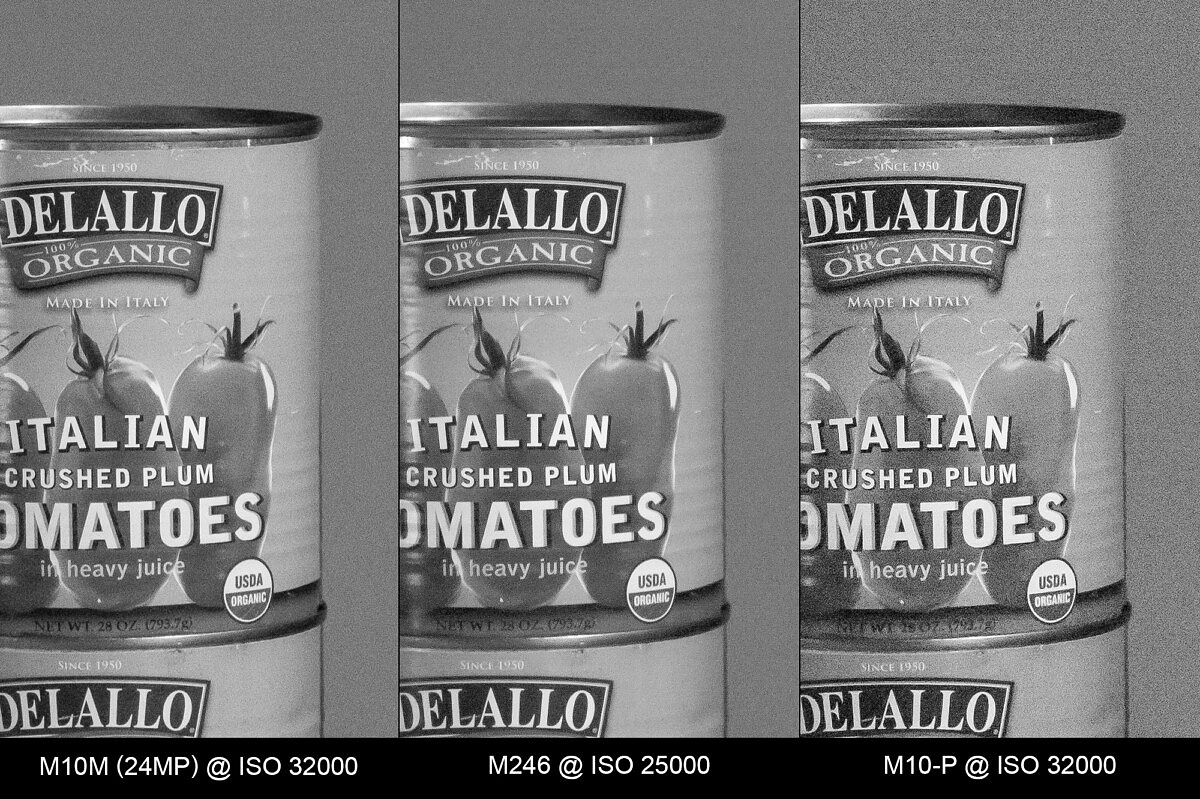
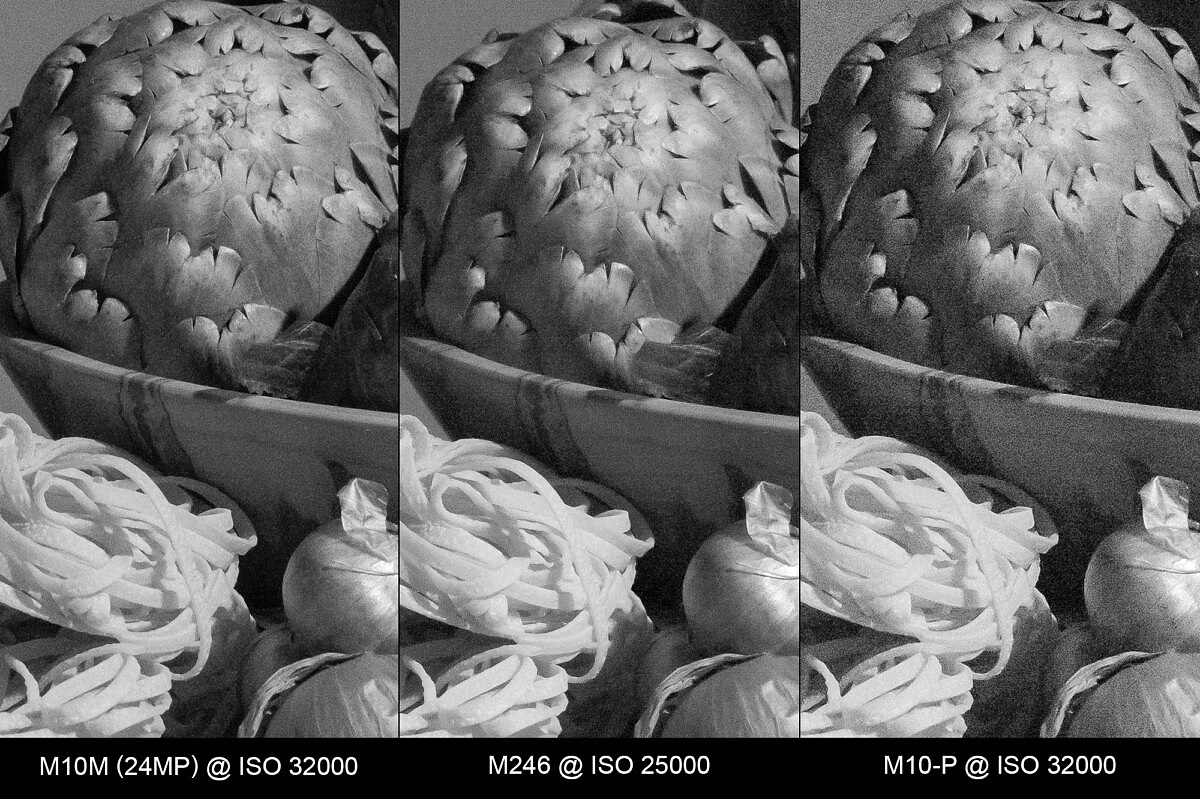
ISO 40000
Now, nosotros're finally starting to run into the M10M pick up some dissonance, but particular resolution is however excellent, better than the M246 at ISO 25000. Noise is now quite meaning on the M10-P.
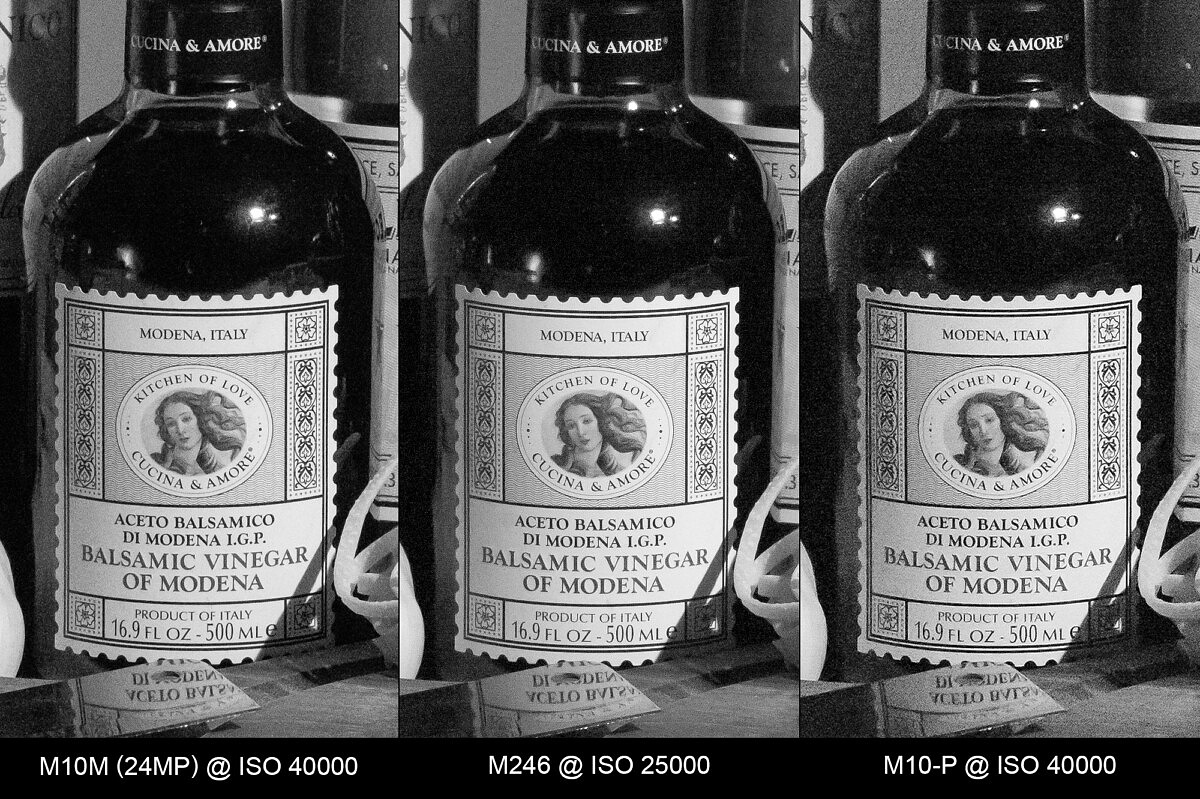
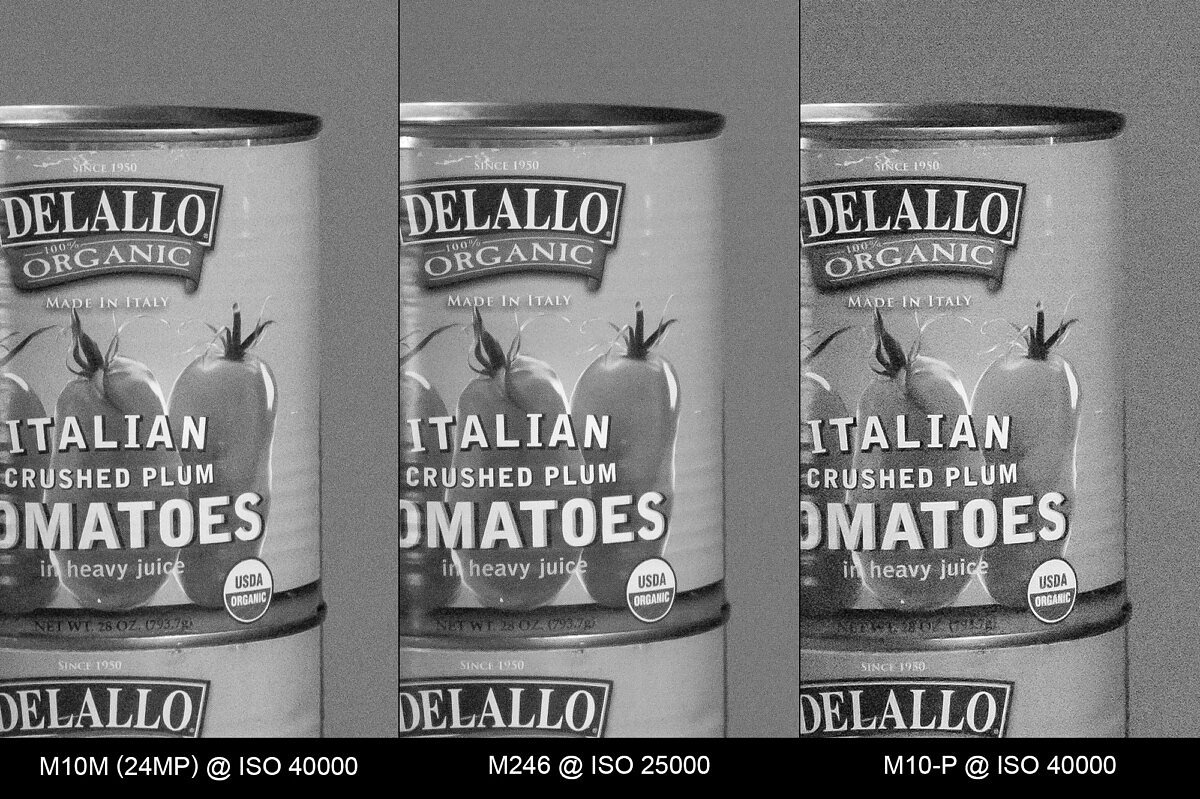
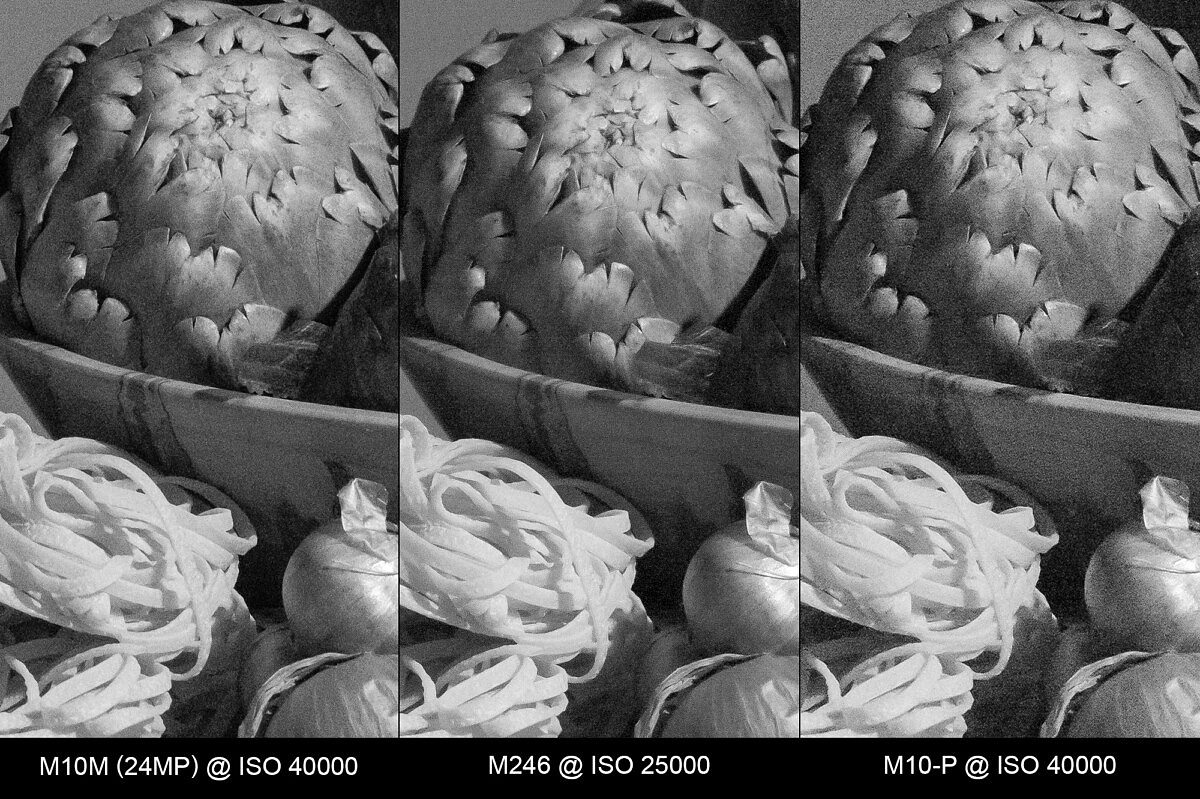
ISO 50000
At ISO 50000, nosotros've hit the upper limit on the M10-P. The M246 is a full cease behind at ISO 25000 and the M10M notwithstanding has another stop in the tank. Really impressive showing by the M10M as the noise:item ratio seems to hold fairly steady.
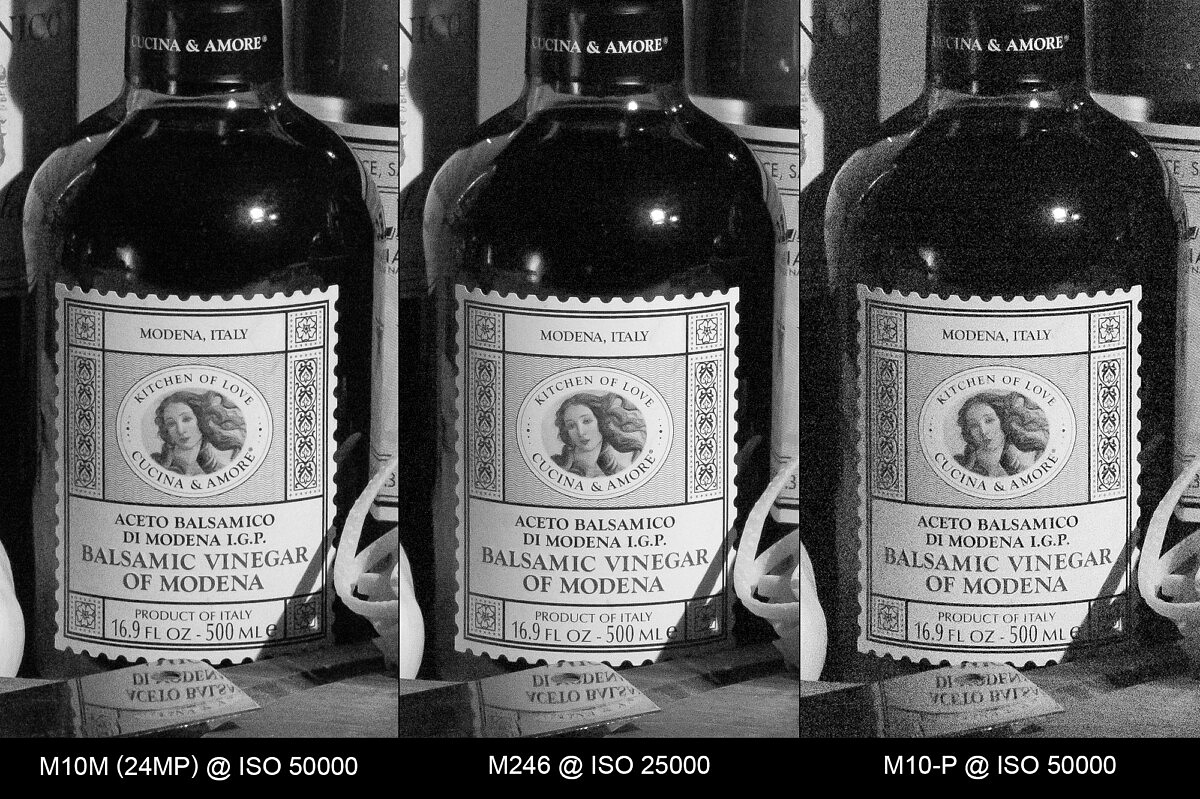
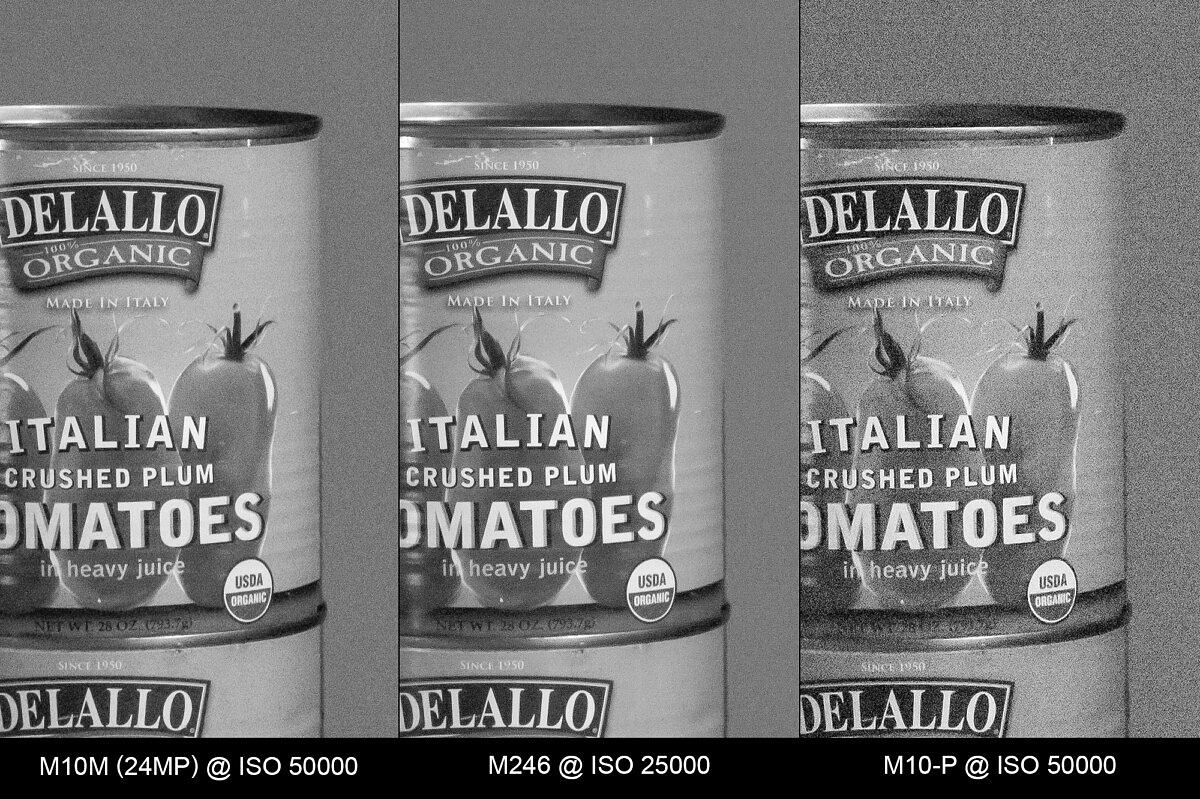
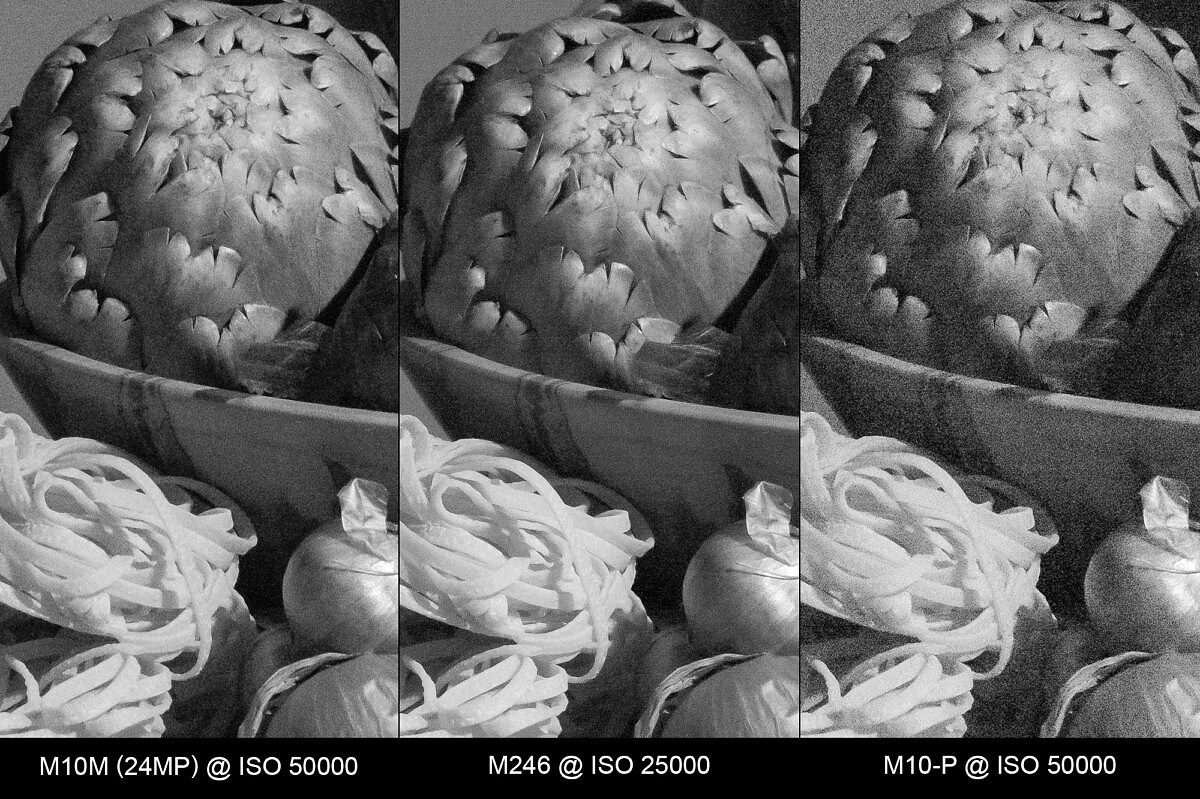
ISO 64000
At ISO 64000, nosotros've ventured past the native ISO ranges of both the M10-P and the M246, just the M10M keeps on going strong.
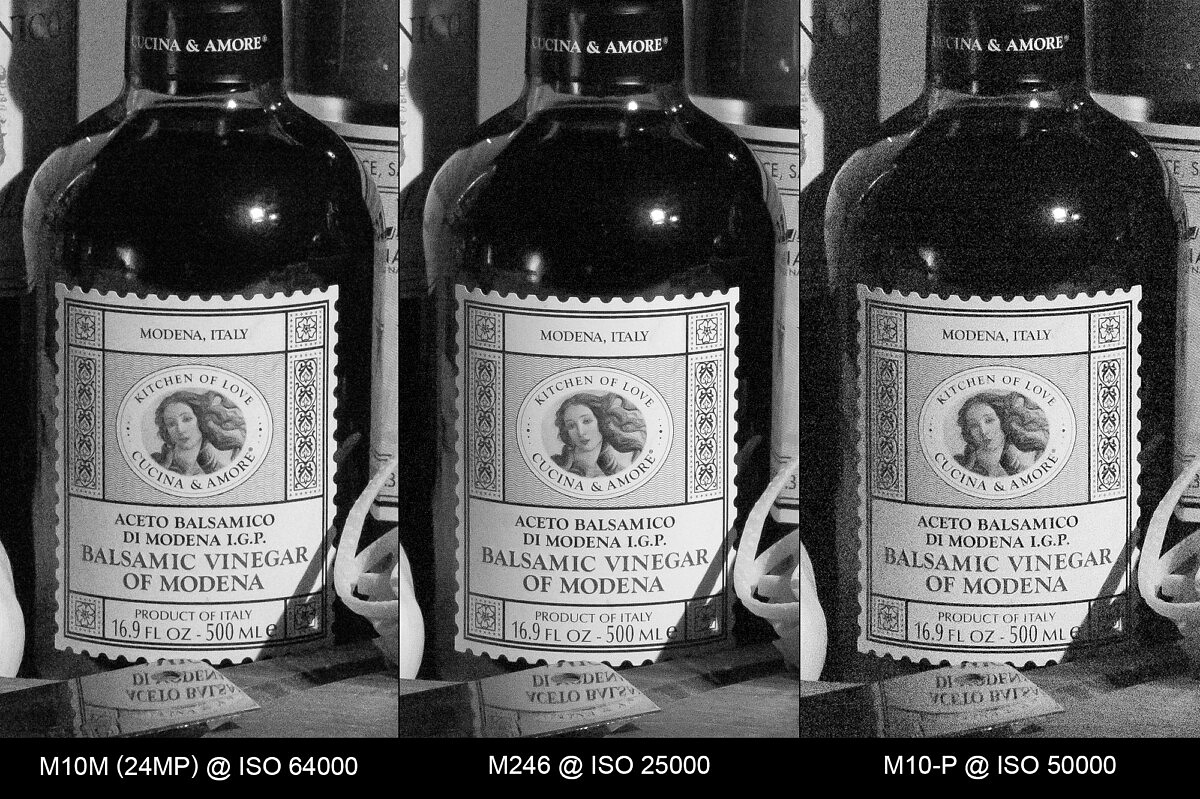
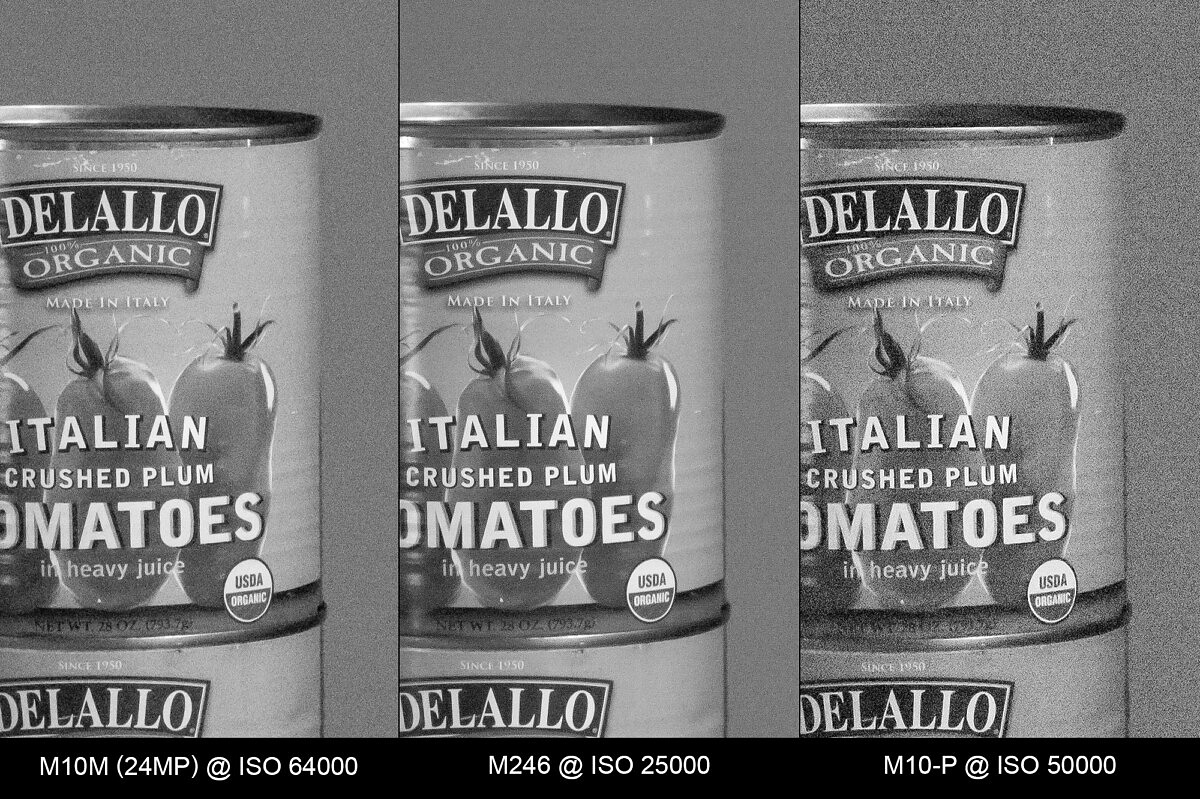
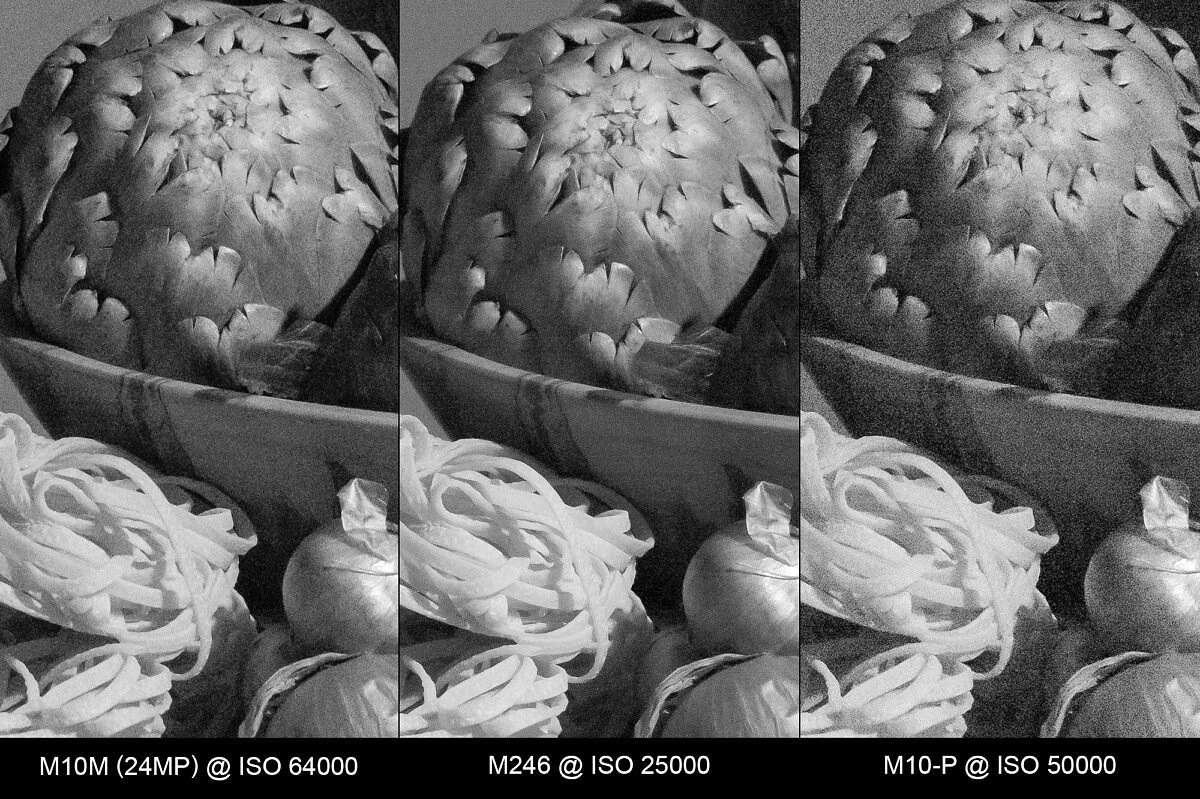
ISO 80000
The M10M image is picking upwardly more noise and losing some midtone and shadow particular, merely high frequency info is still retained.
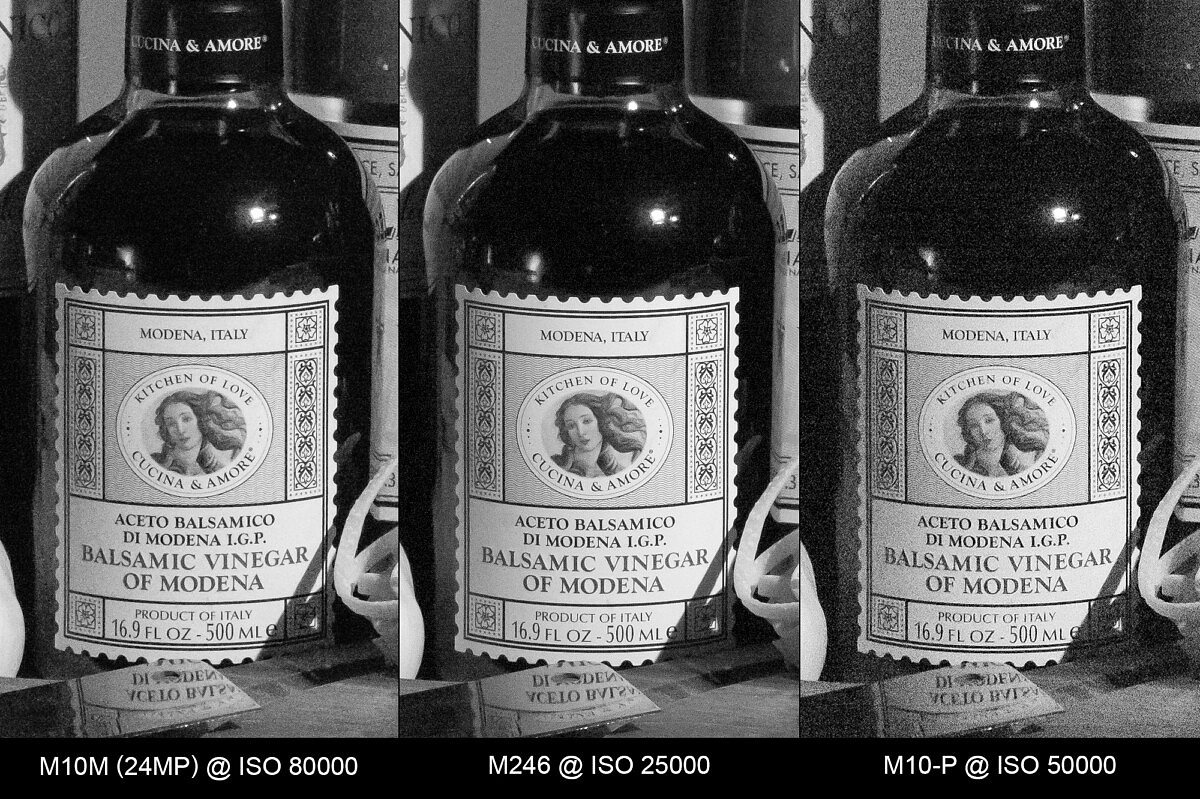
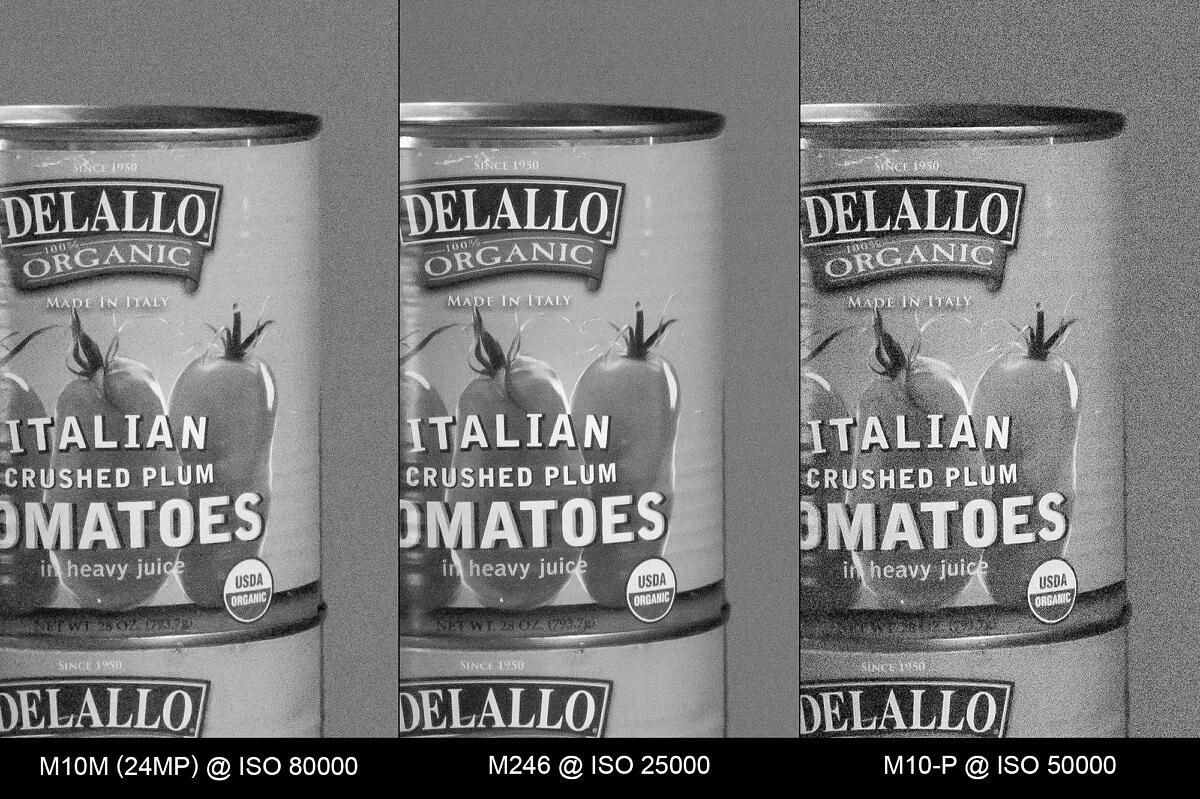
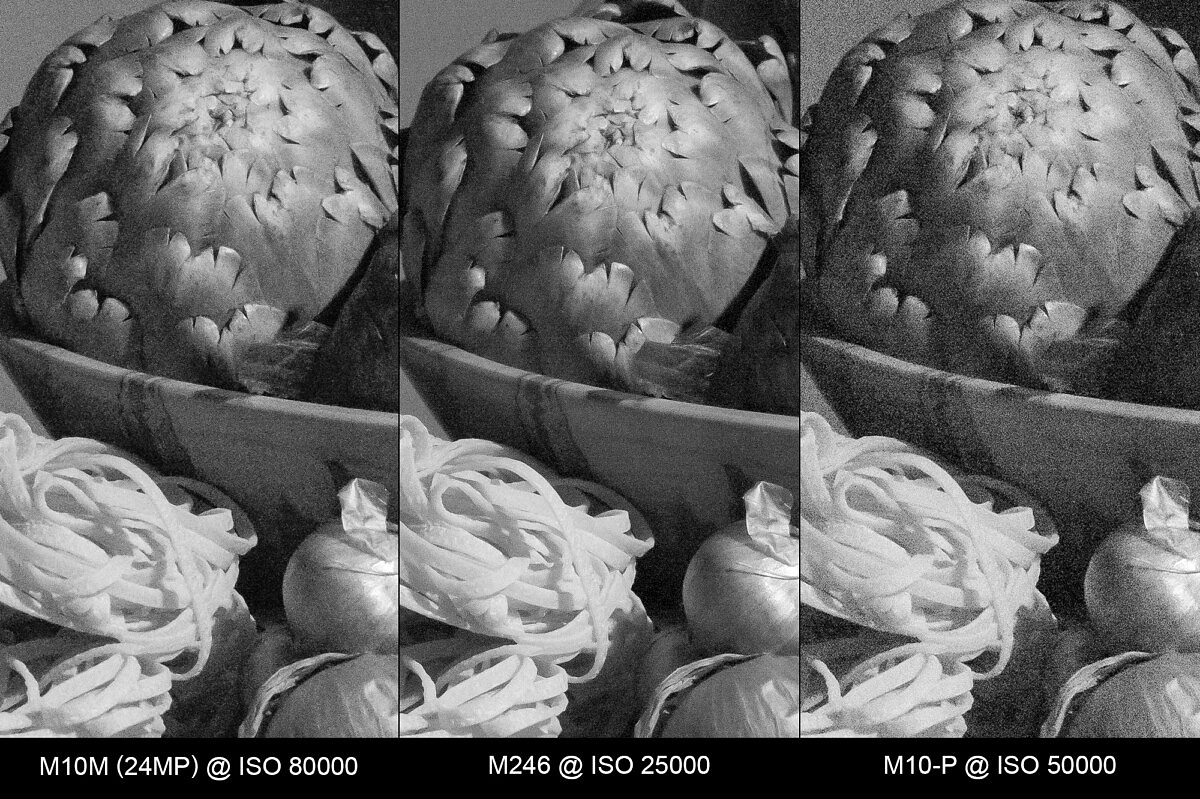
ISO 100000
At 100000, the M10M is at the meridian of its ISO range, a total stop faster than the M10-P and two stops more than than the M246. Information technology's noisy, but the pattern is tightly packed and uniform. There's nevertheless usable item and ISO 100000 looks amend than 50000 on the M10-P.
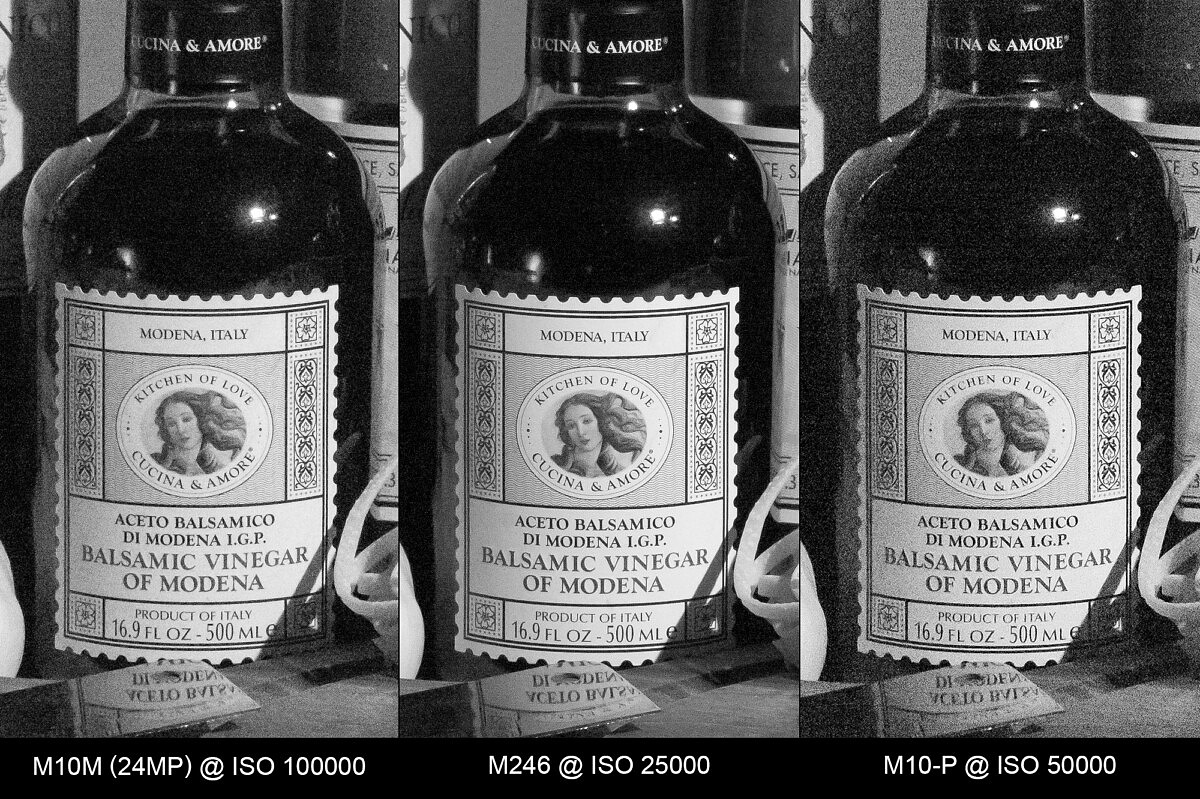
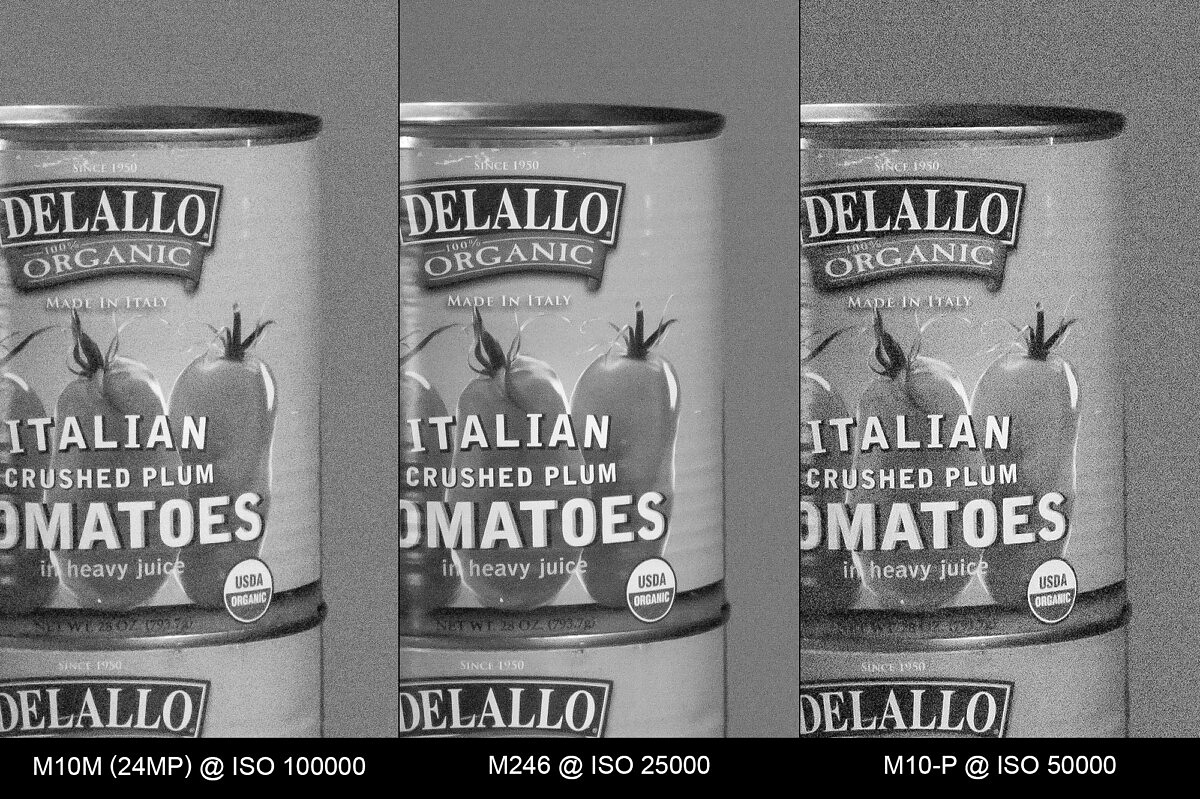
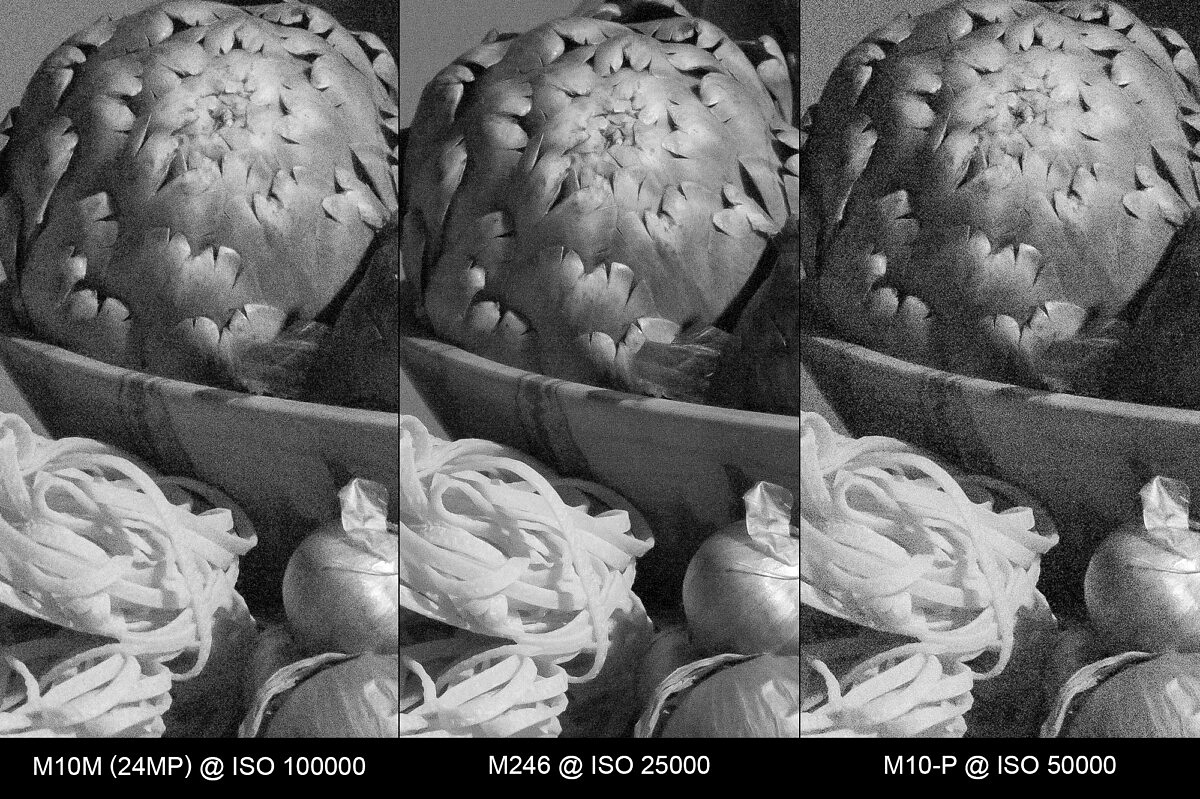
All-time of Loftier ISO Settings
For this bonus set, I've combined the three cameras at the ISO values I felt displayed the greatest amount of detail earlier exhibiting noticeable noise. The M10-P isn't besides far behind the M246 at ISO 10000 versus ISO 12500. Only the M10M shows its capability at ISO 32000. The M10M does prove more noise in the background, but a bit more noise reduction in Lightroom could piece of work very well here.
Basically, what nosotros're seeing is a 1.5 finish advantage of the M10M, just this is a bit of an oversimplification. The M10M maintains similar epitome quality across an even wider range of ISO values, almost plateauing in one case hitting ISO 10000.
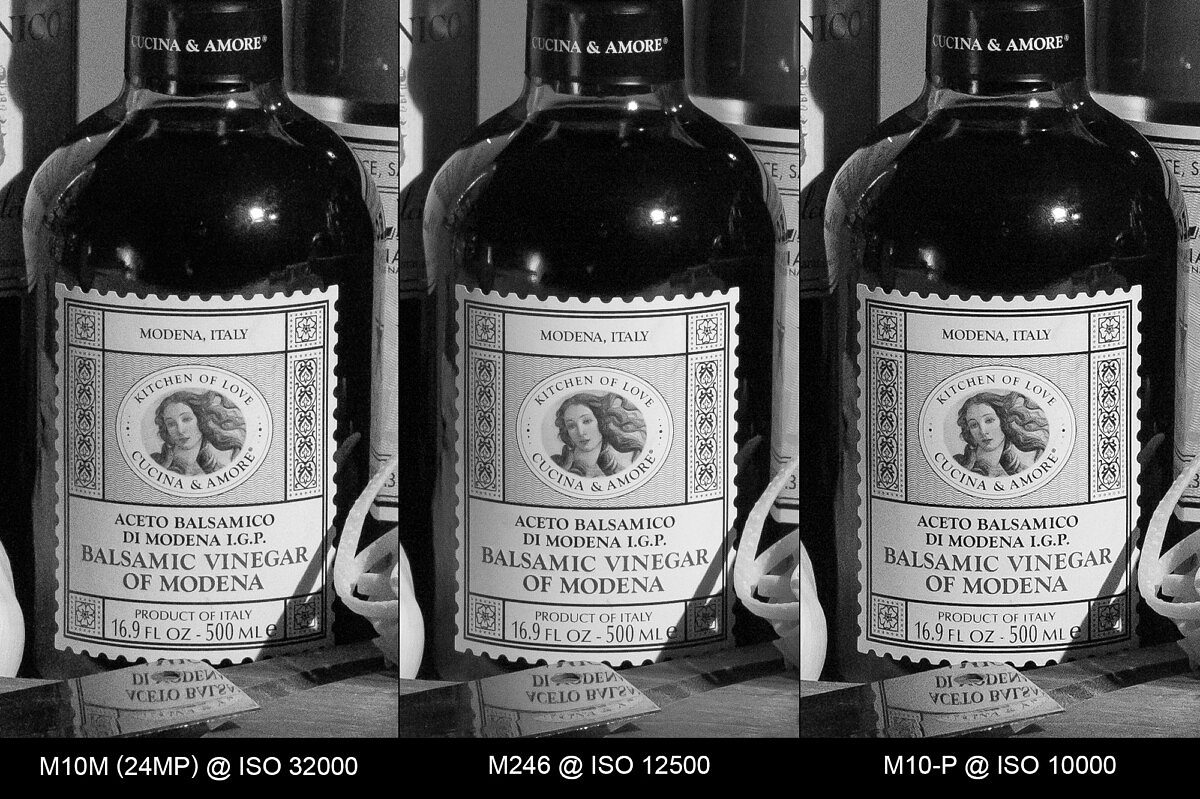
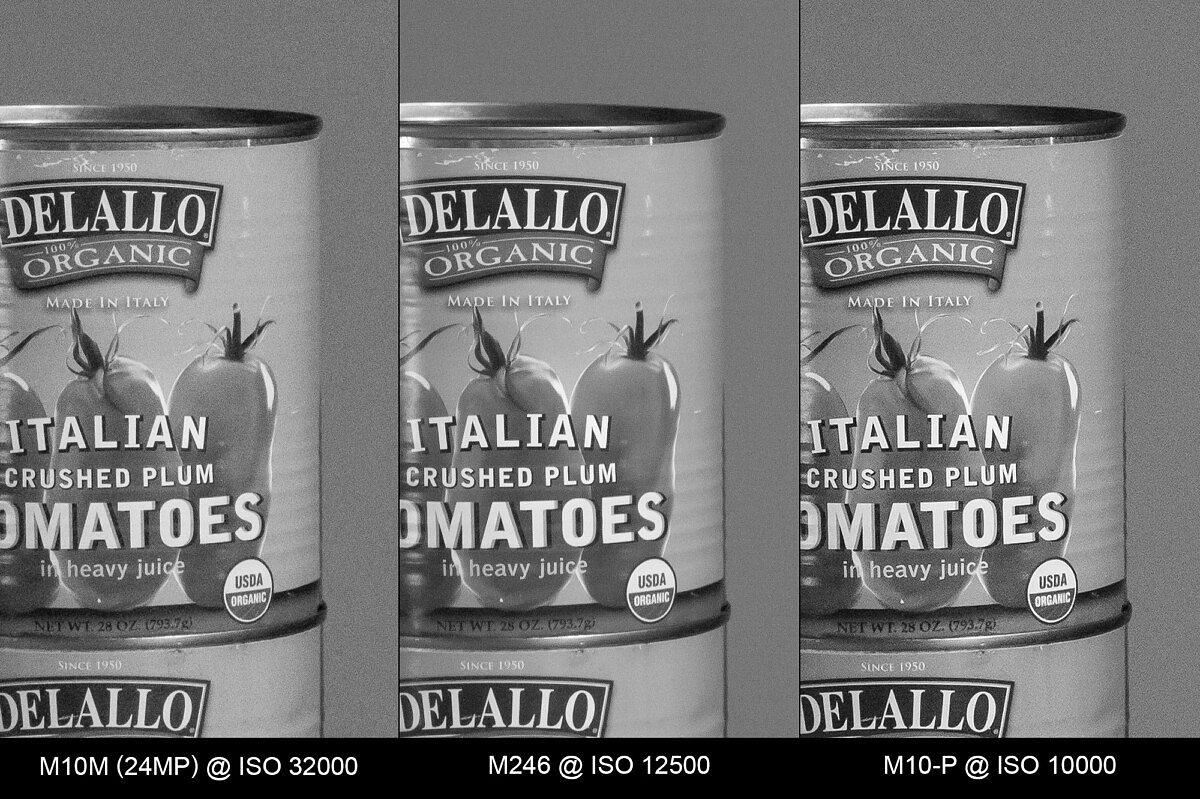
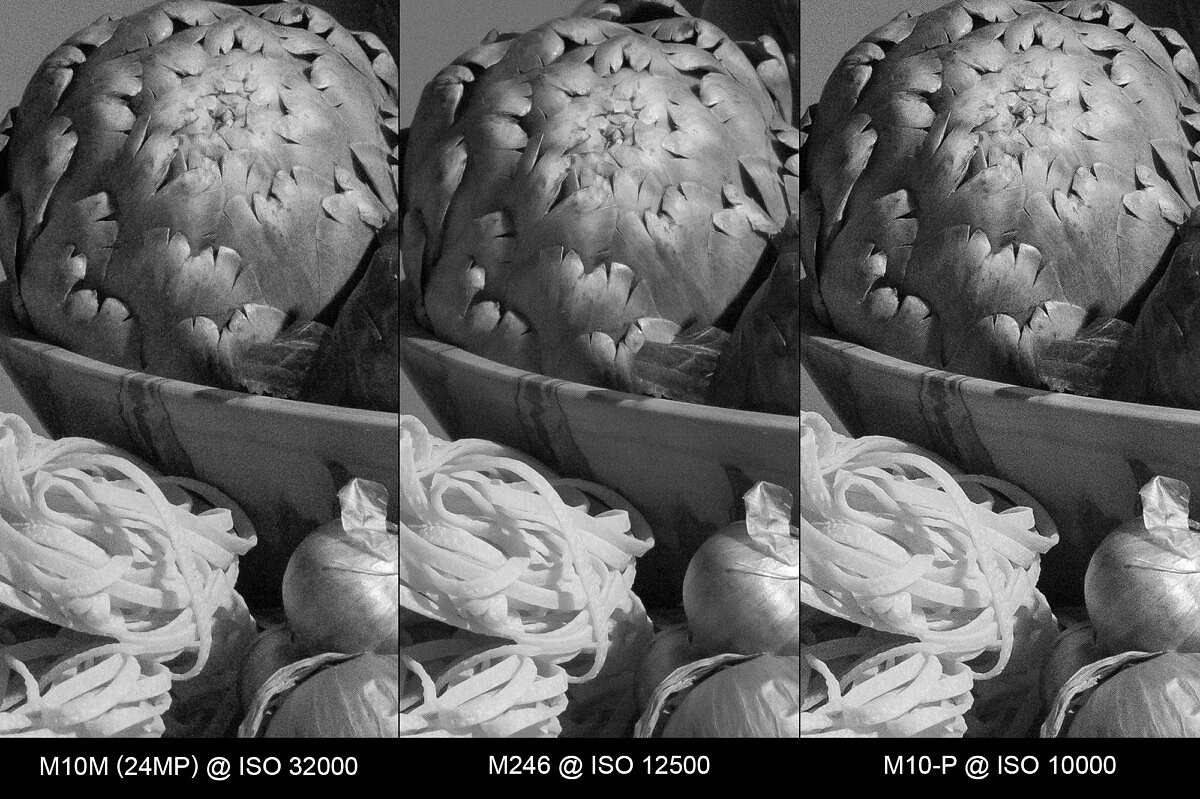
Native Resolution Comparison: M10M vs M246
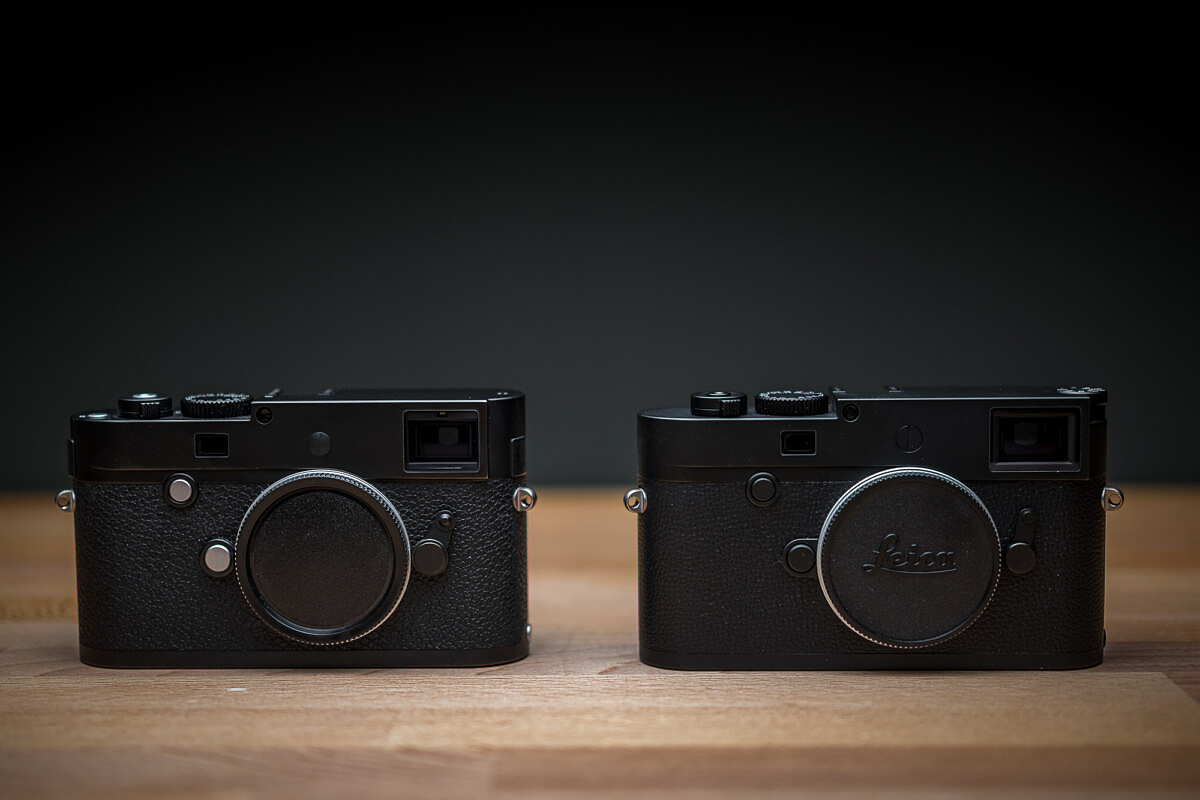
If y'all establish flaws in my logic for downsampling the M10 Monochrom, or simply wanted to see the actual resolution increase over the M Monochrom (Typ 246), I've got you covered with this side by side comparison set. Only for the sake of slightly minimizing the corporeality of images in one postal service, I've express these comparisons but to the central balsamic vinegar bottle and pasta.
Hither, I decided to include the respective base ISO results from each of these ii Monochrom cameras, ISO 320 for the M246 and ISO 160 for the M10M. Honestly, there is no visual difference from the earlier method.
Having already covered the basic analysis above, I'll simply get out these hither for you to draw your own conclusions. Suffice it to say, while both cameras resolve an incredible corporeality of detail and textural nuance, the M10M'south large pixel reward serves it well hither. You can easily see the added detail throughout the whole test range.
Base ISO (160 vs. 320)
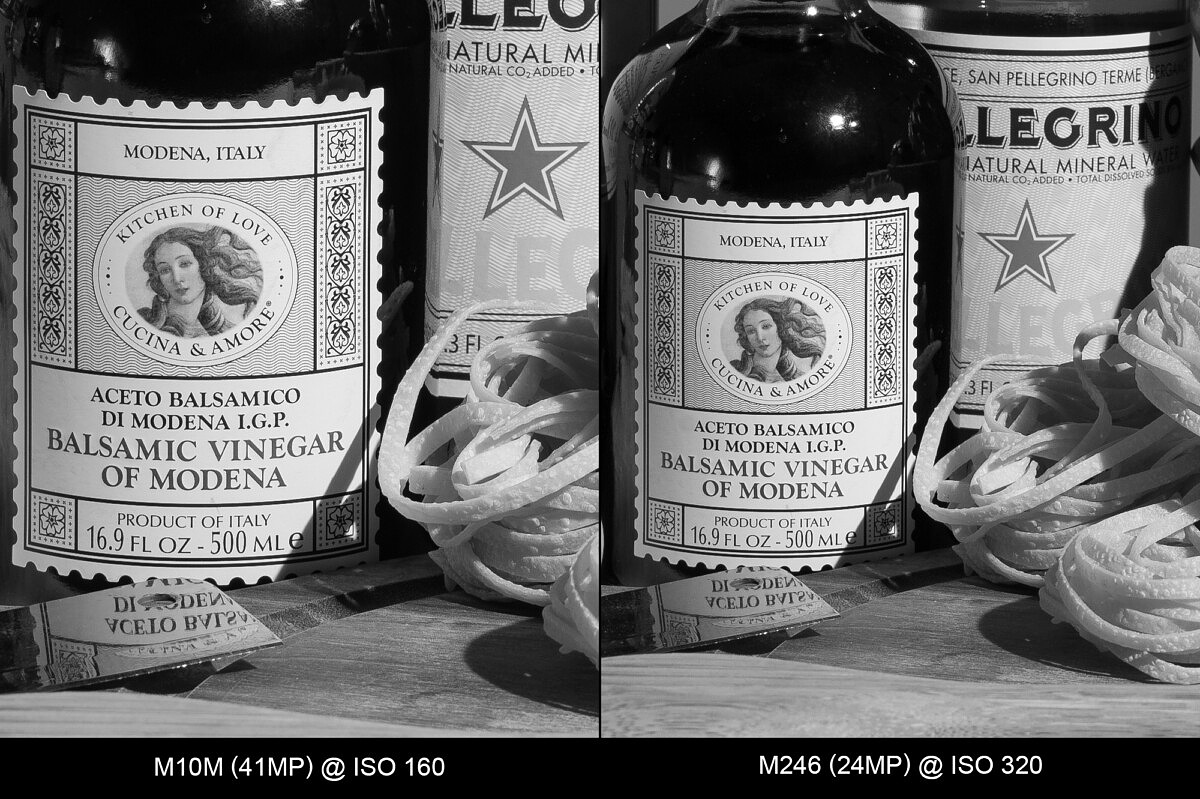
ISO 400
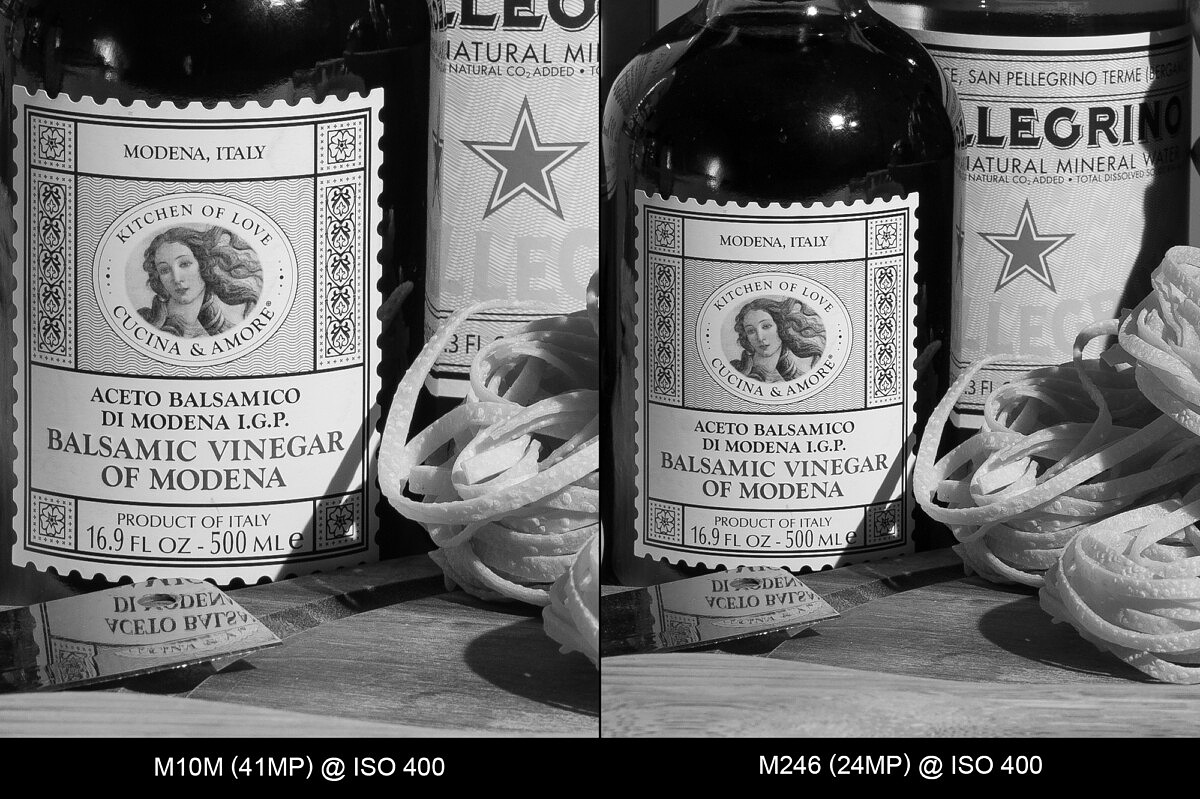
ISO 800
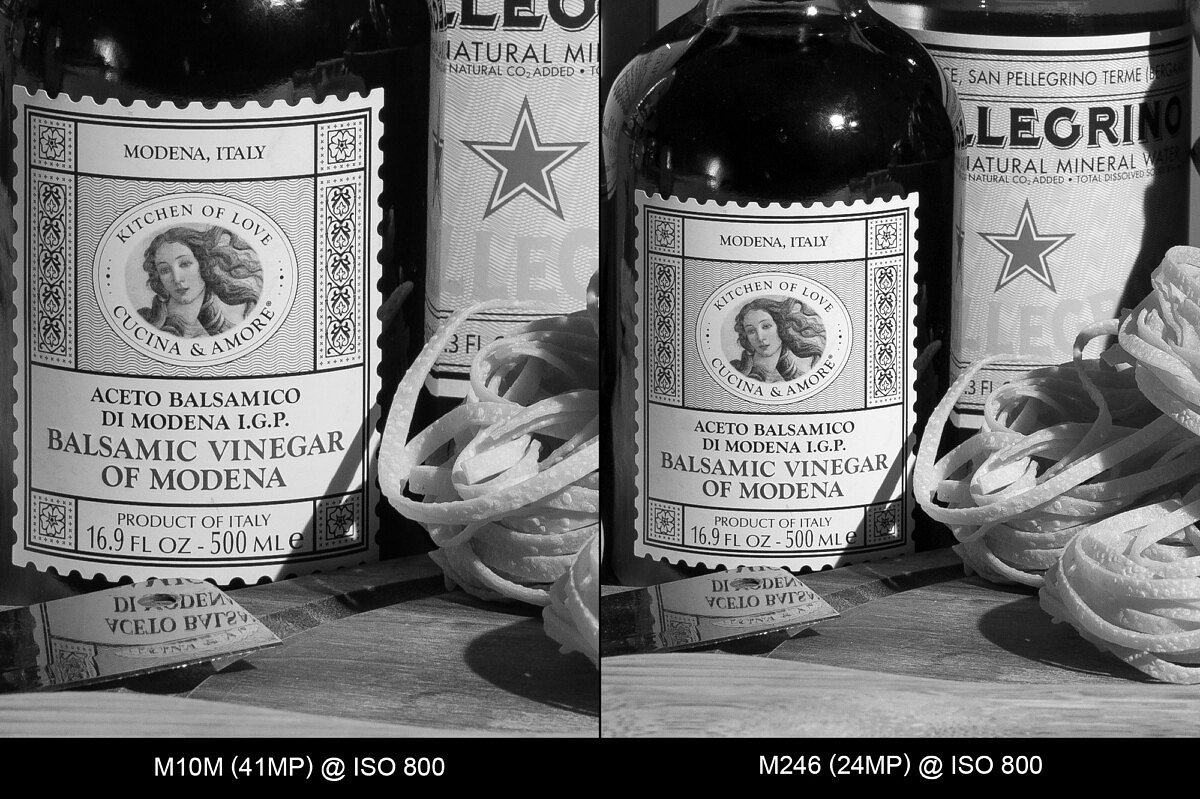
ISO 1600
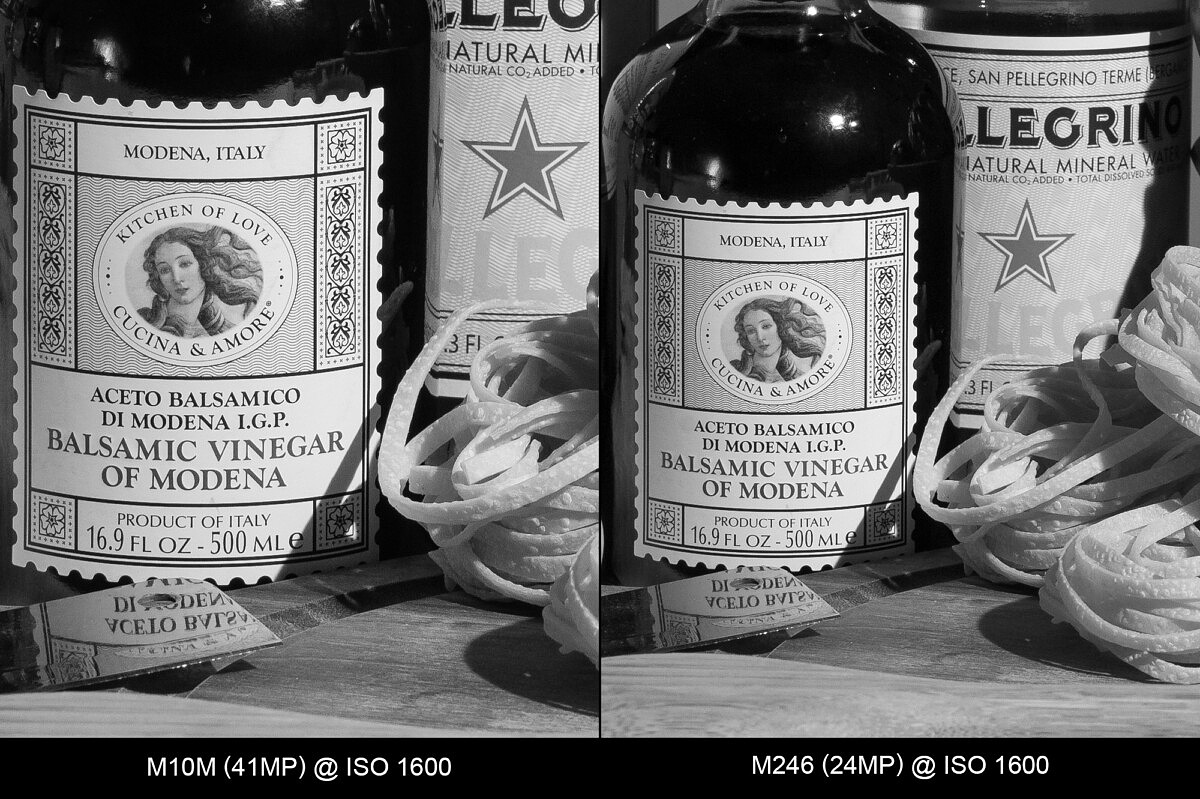
ISO 3200
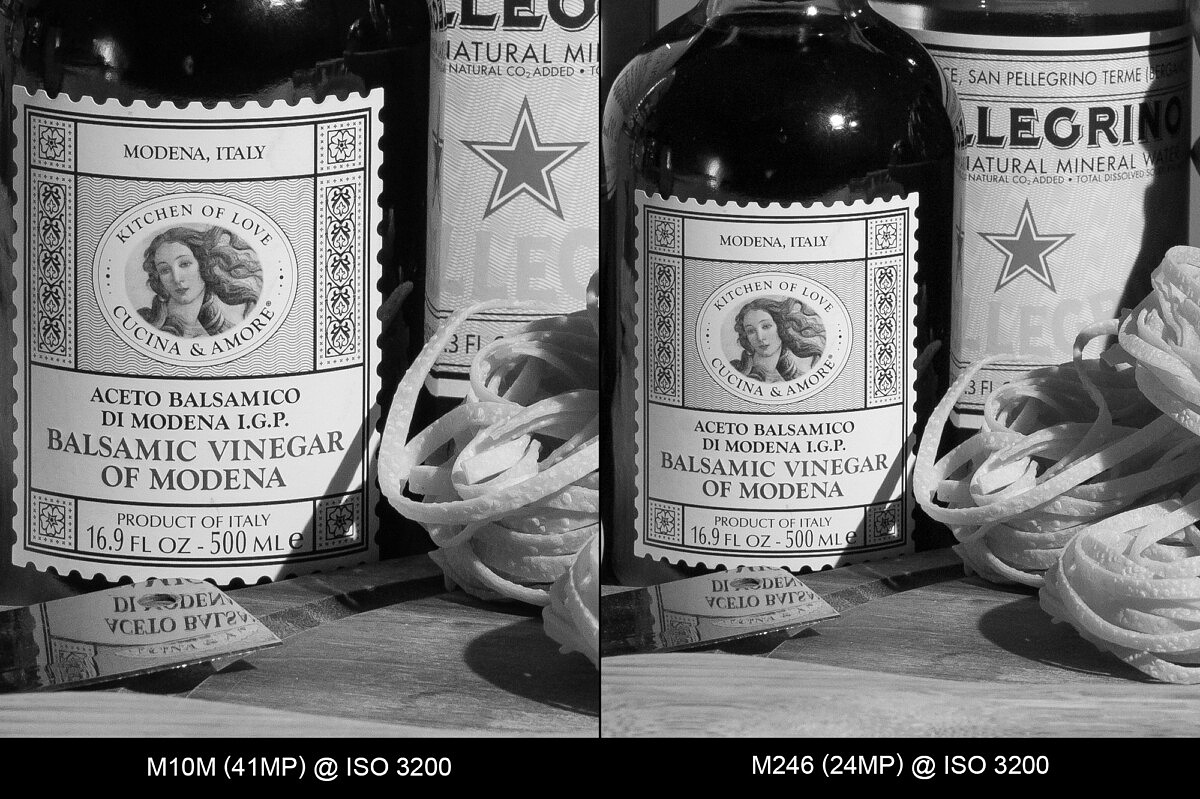
ISO 6400
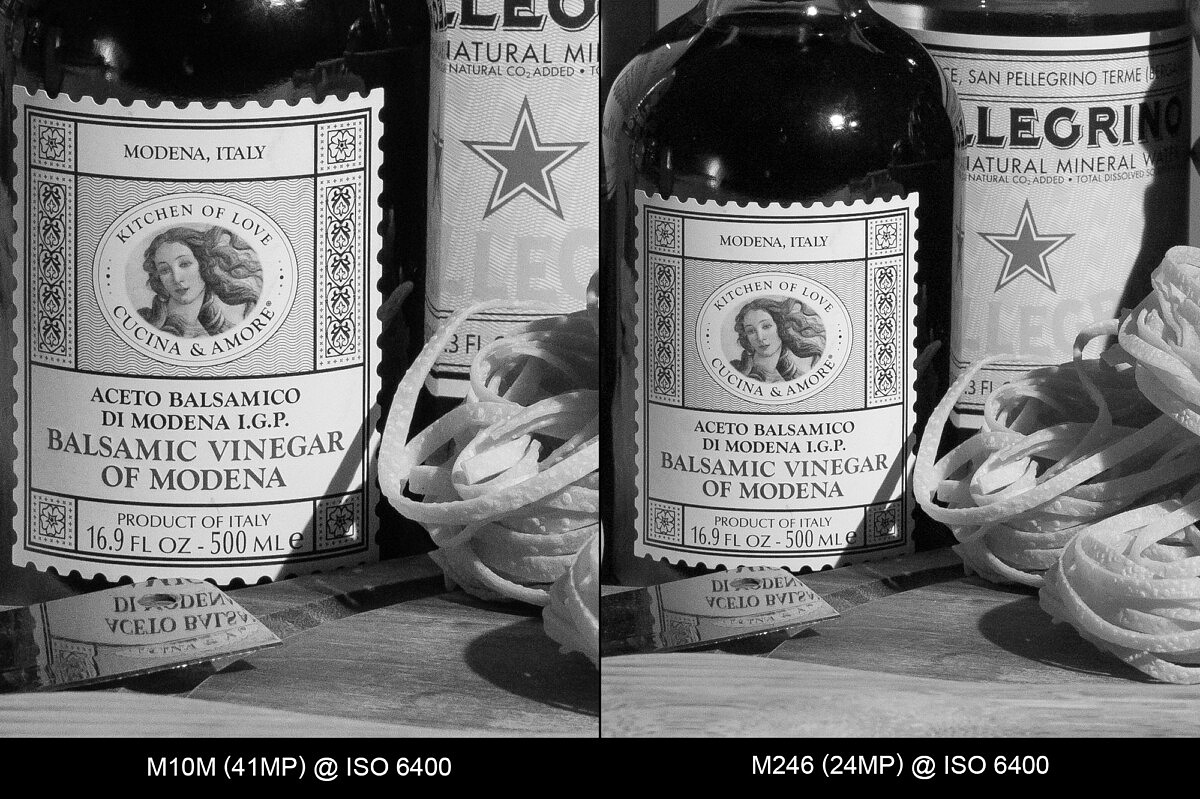
ISO 8000
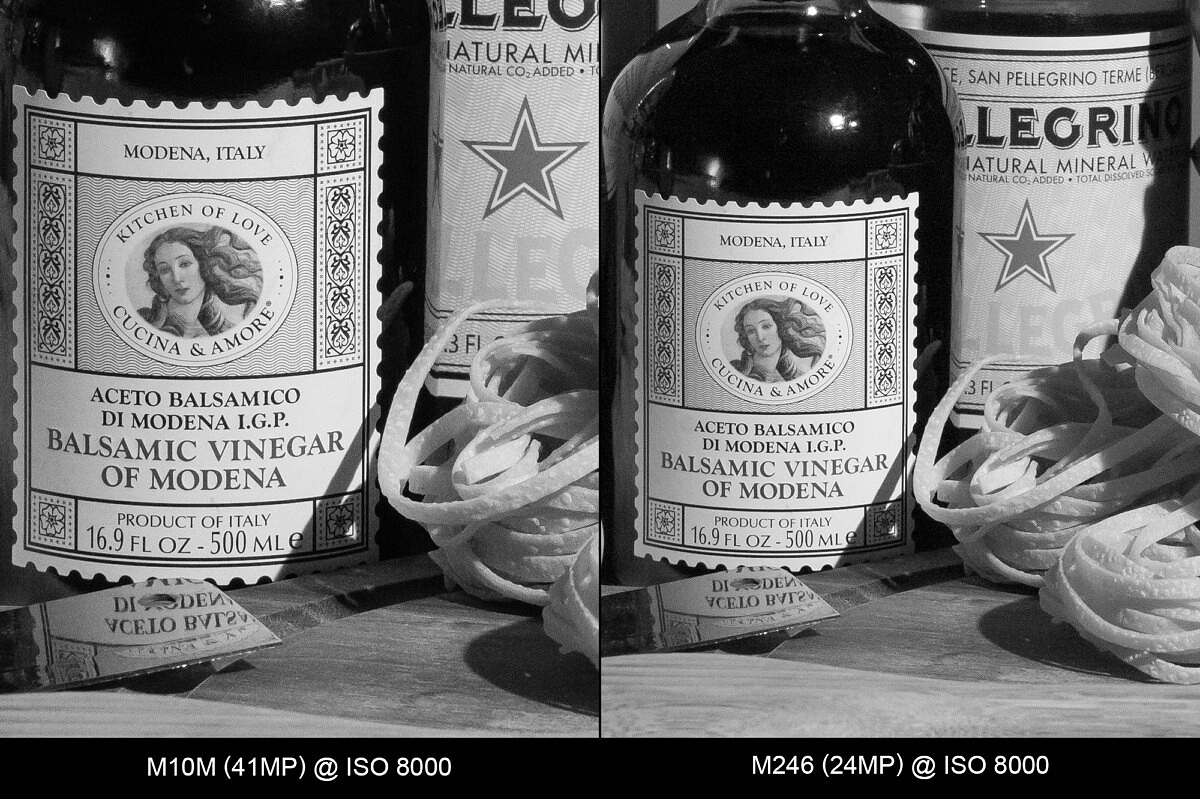
ISO 10000
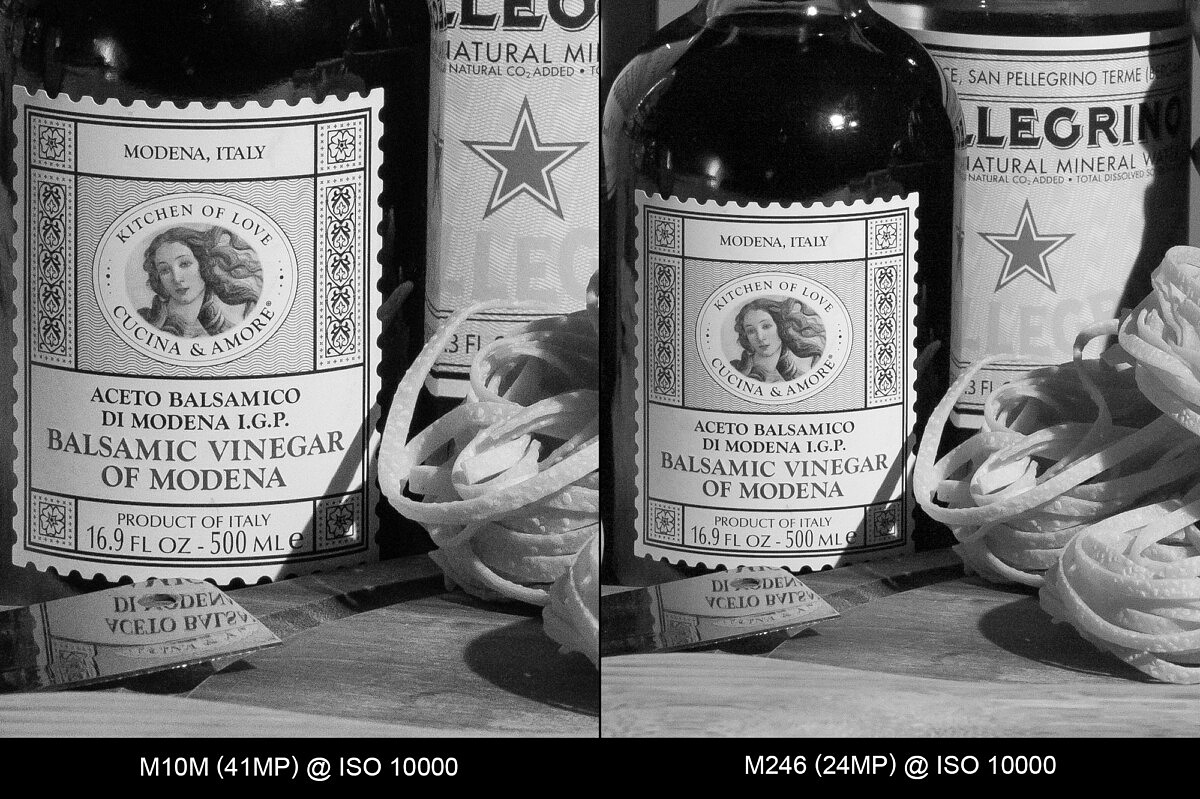
ISO 12500
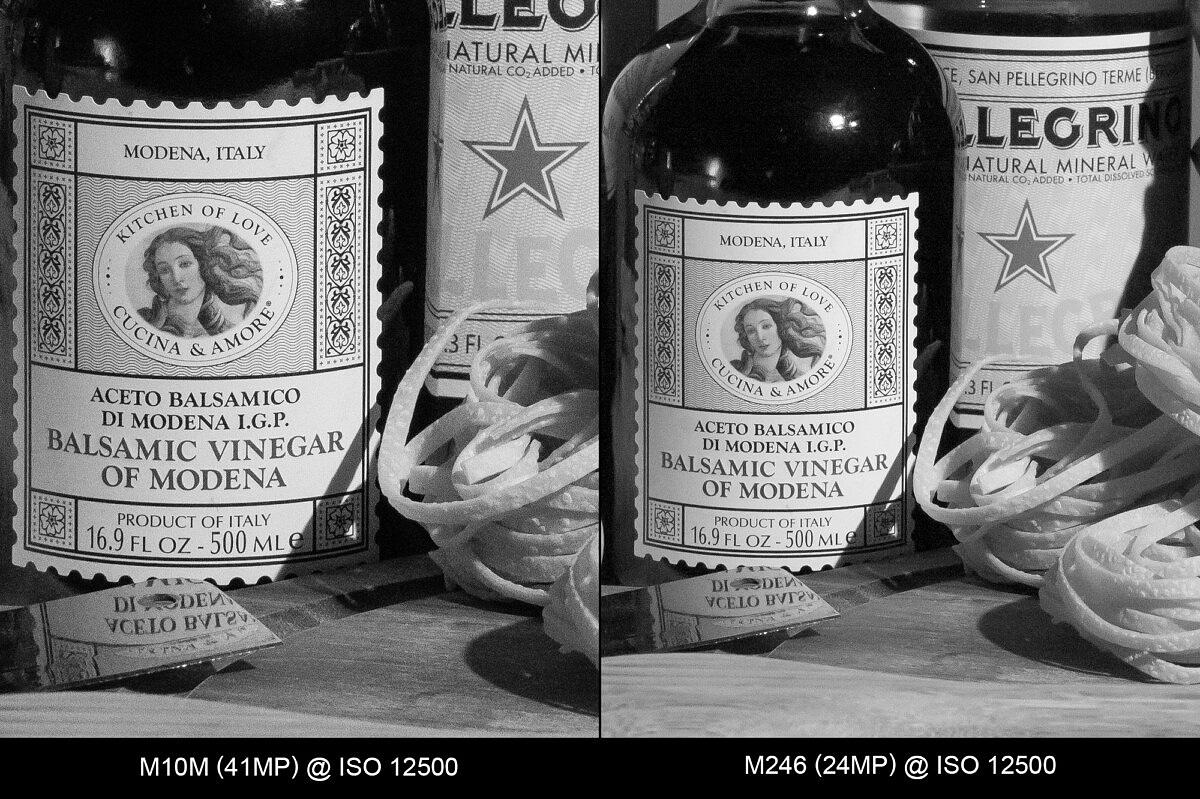
ISO 16000 vs. 12500
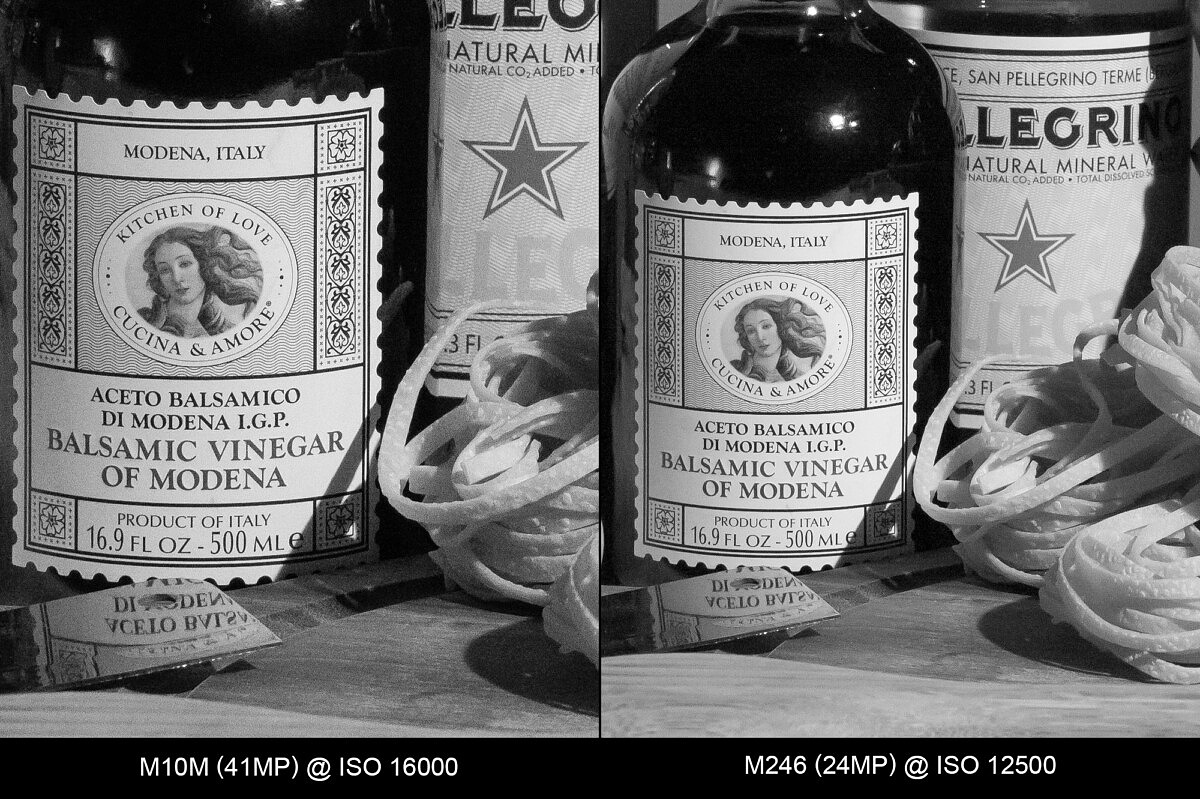
ISO 20000 vs. 12500
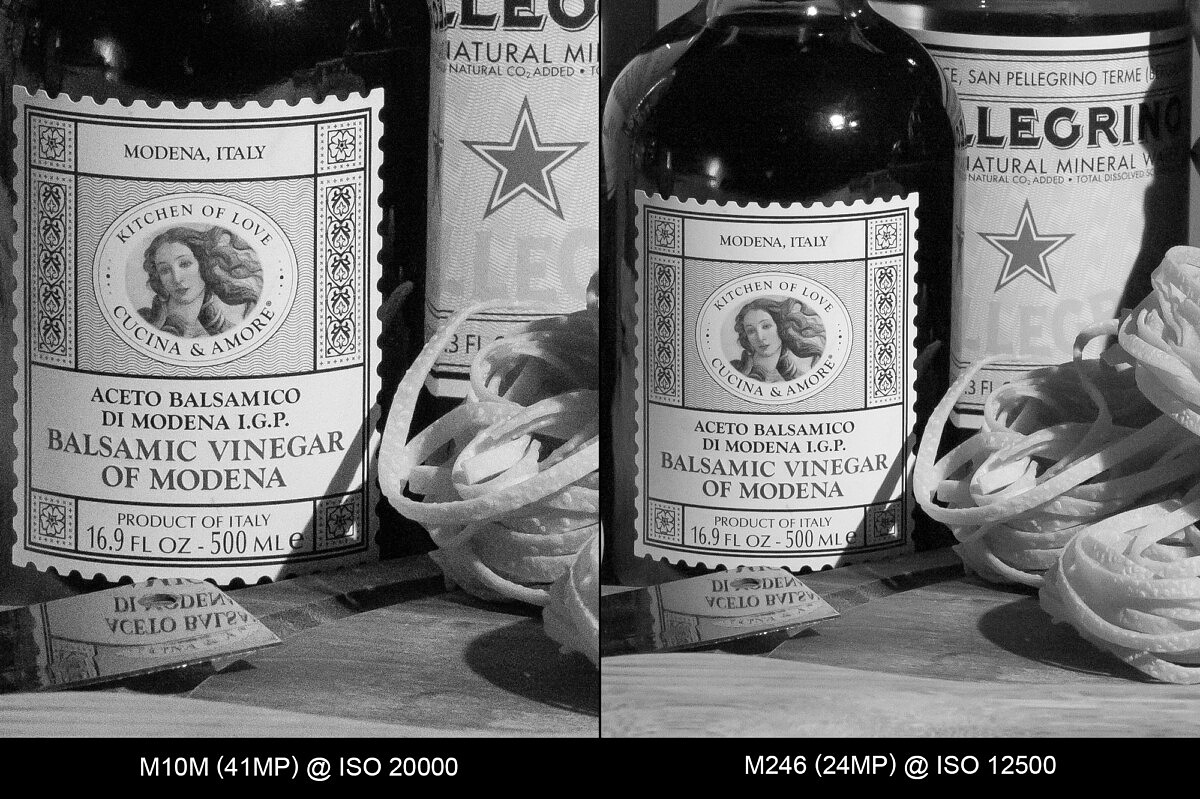
ISO 25000
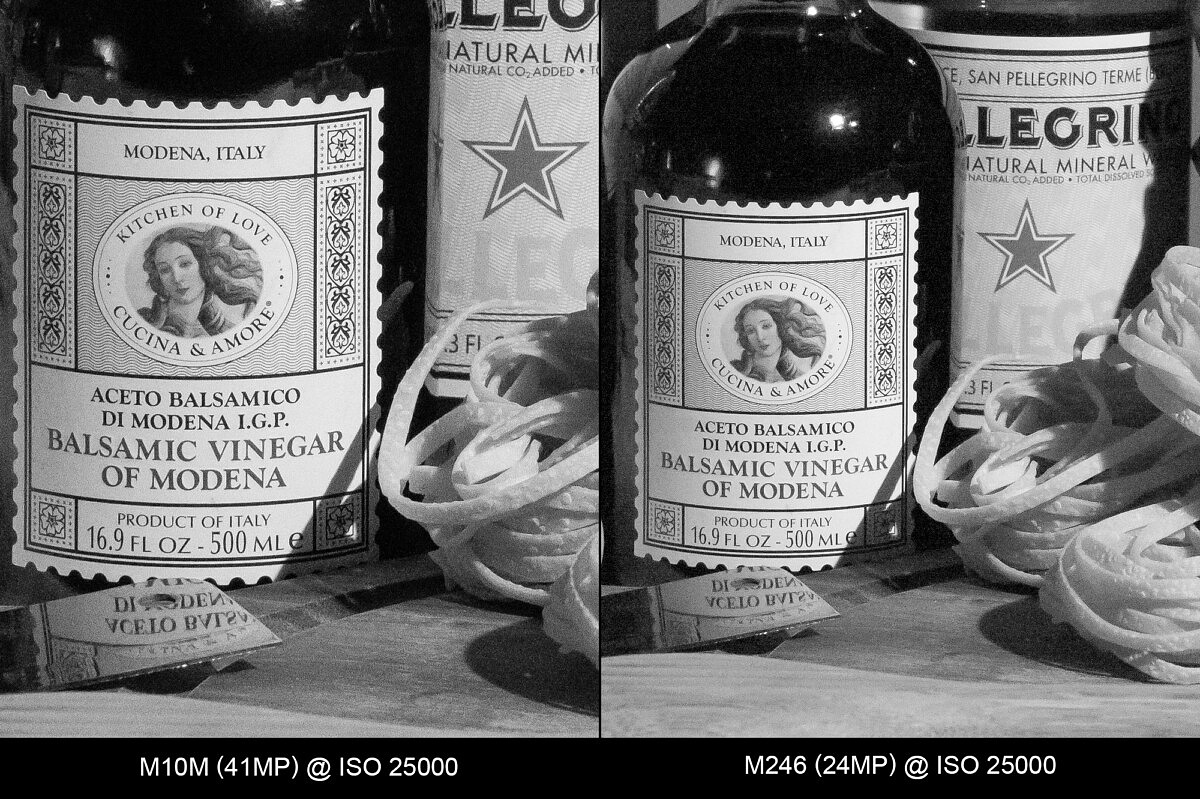
ISO 32000 vs 25000
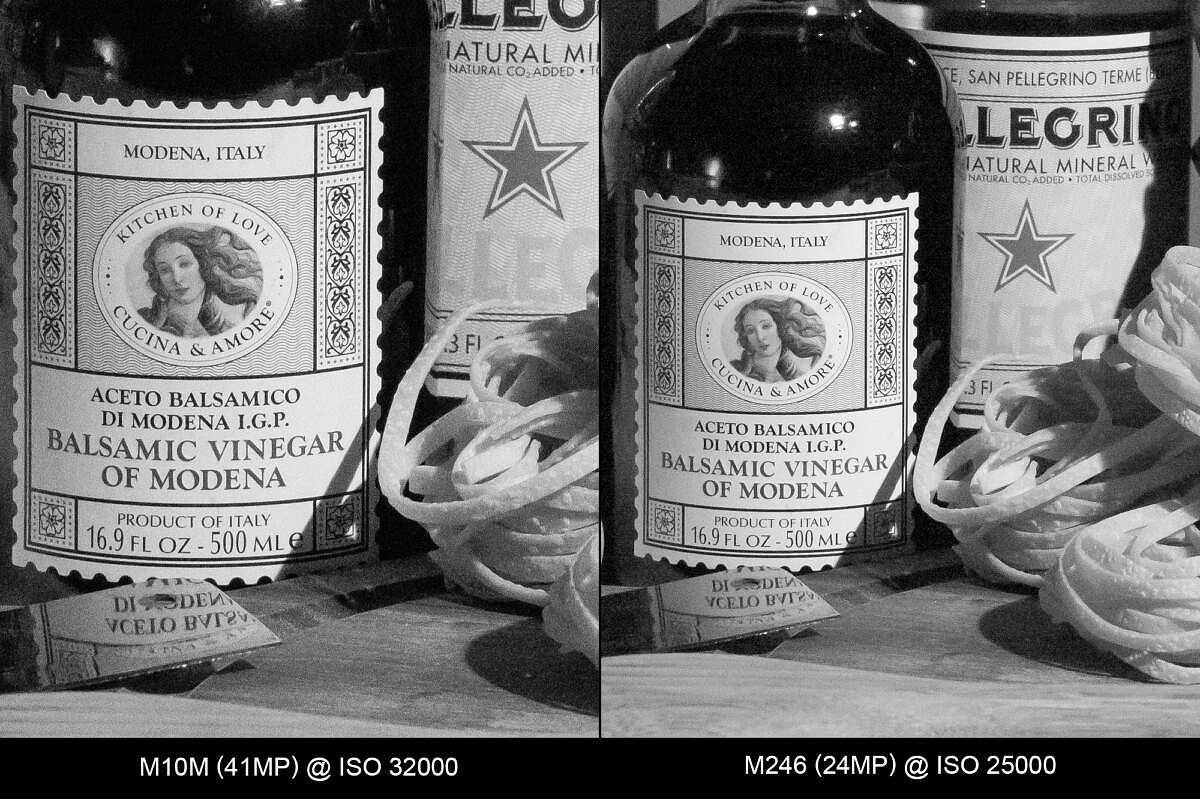
ISO 40000 vs. 25000
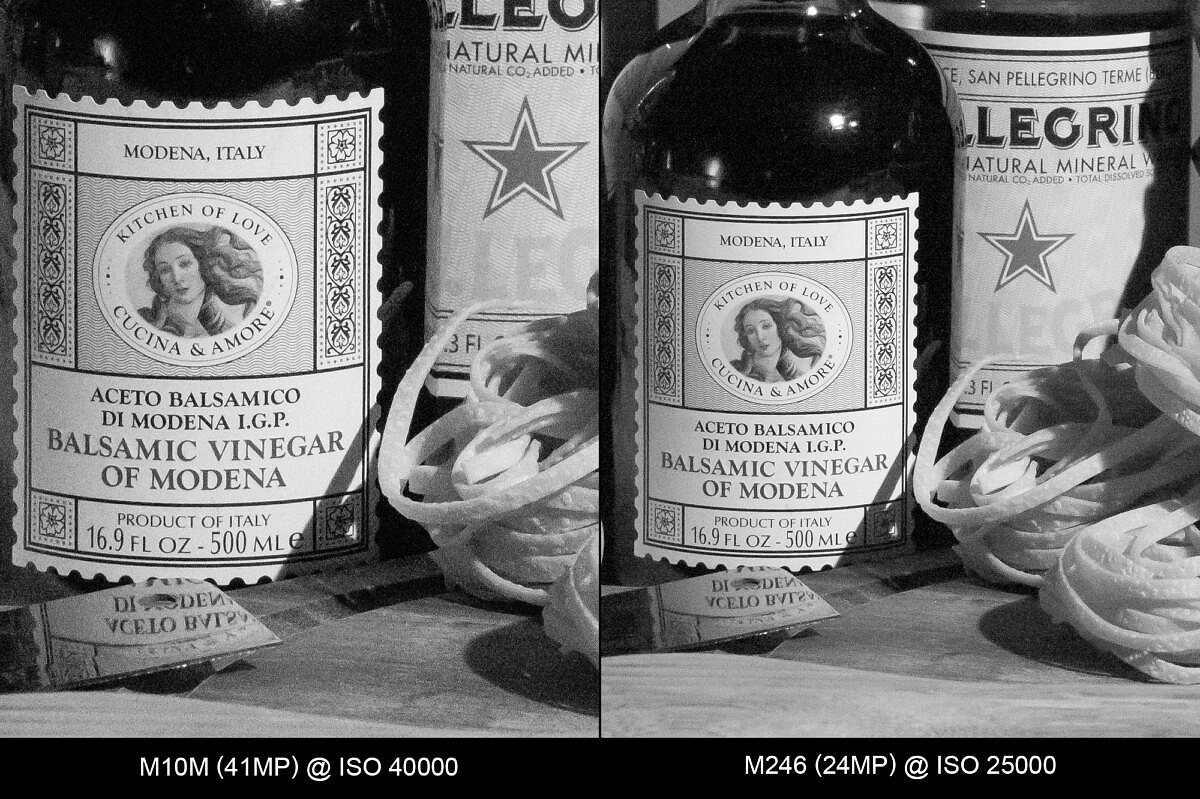
ISO 50000 vs. 25000
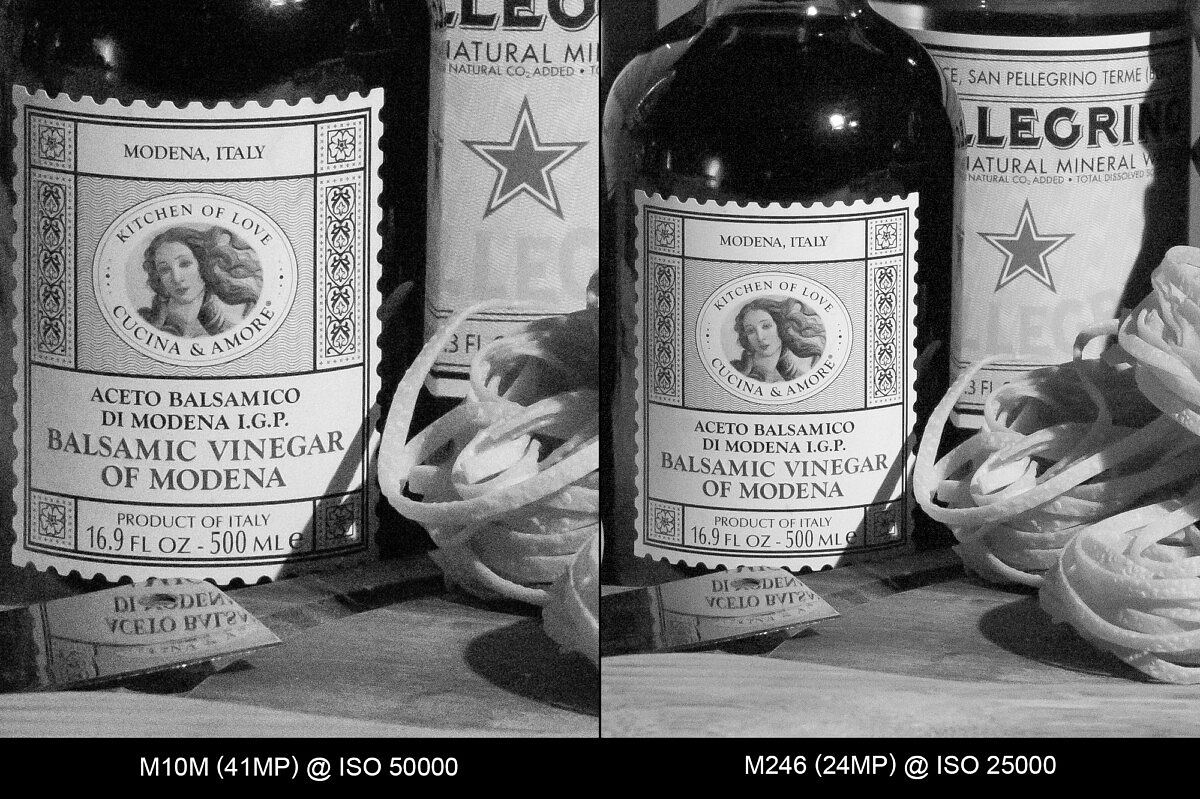
ISO 64000 vs. 25000
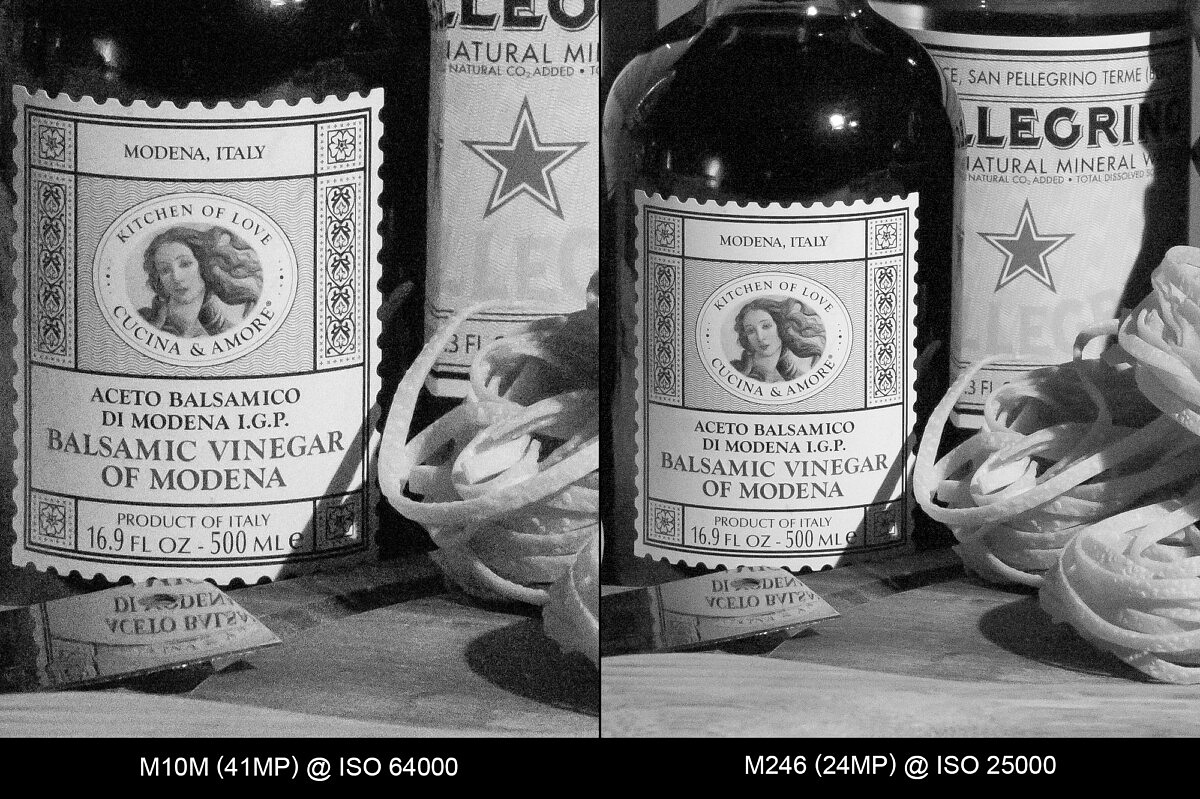
ISO 80000 vs. 25000
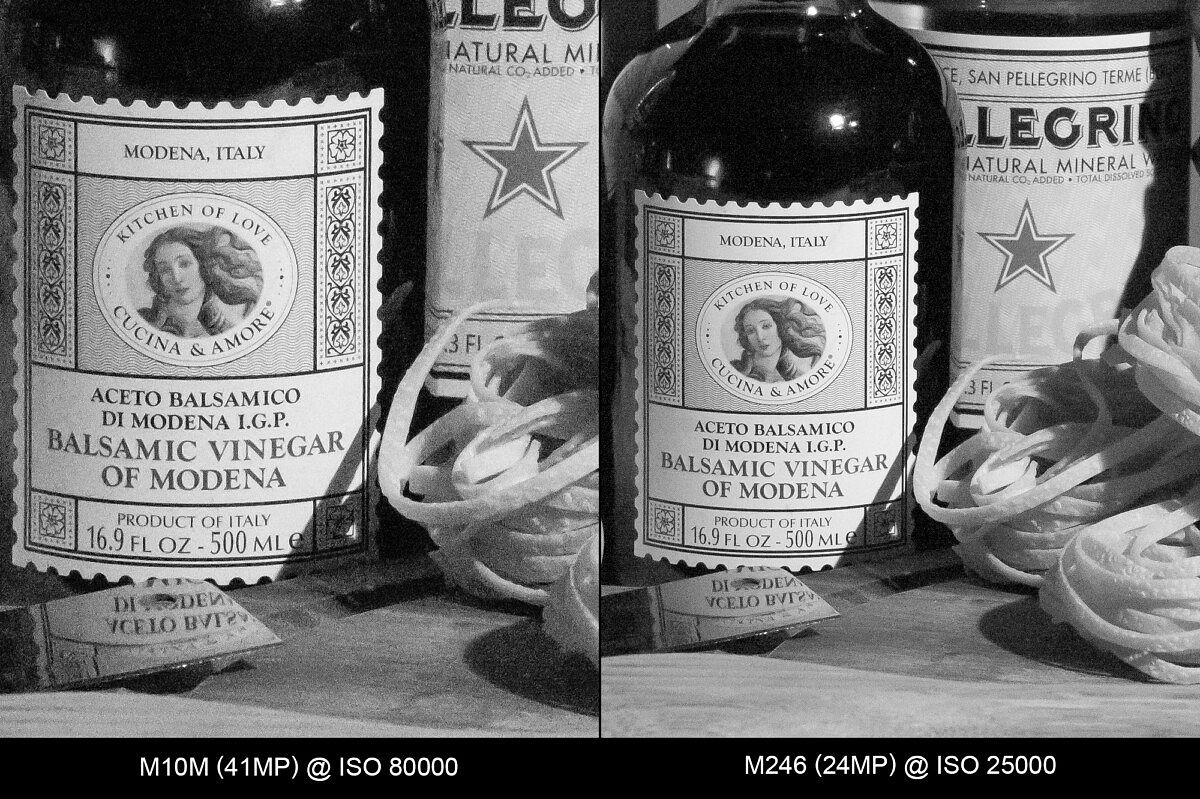
ISO 100000 vs. 25000
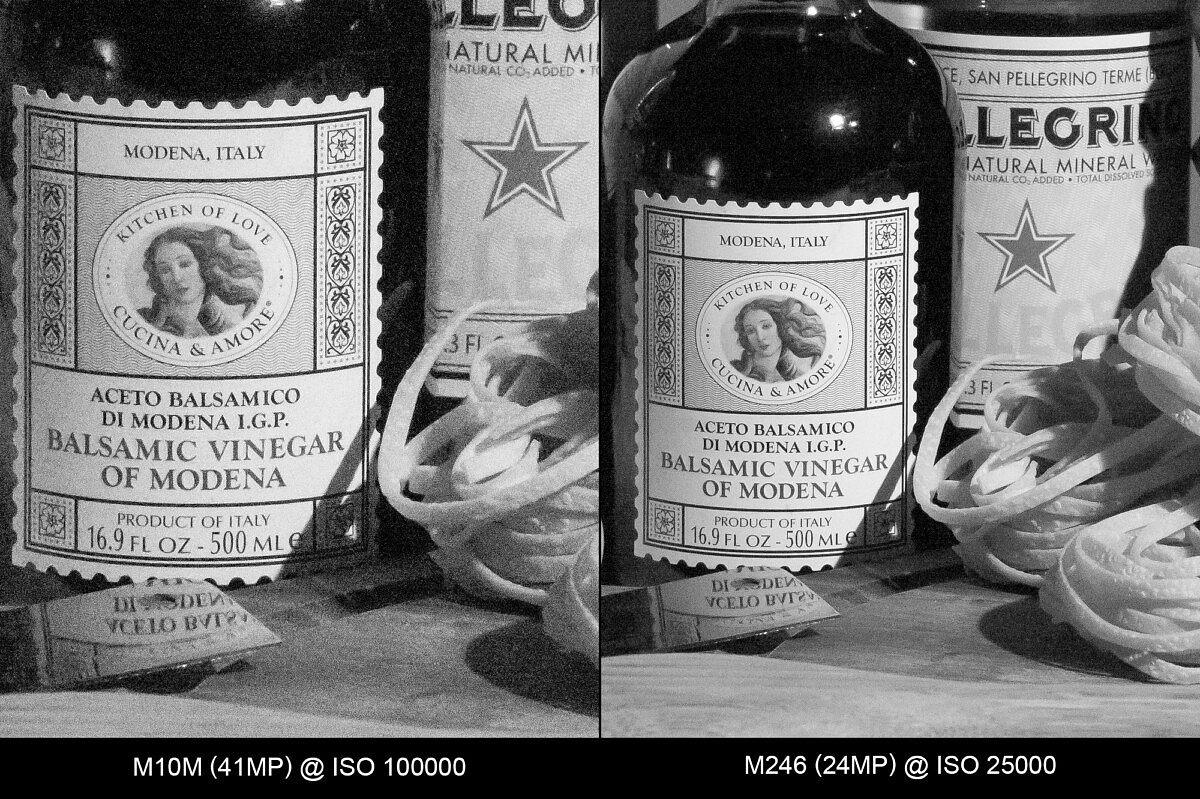
Native Resolution Comparison: M10M vs SL2
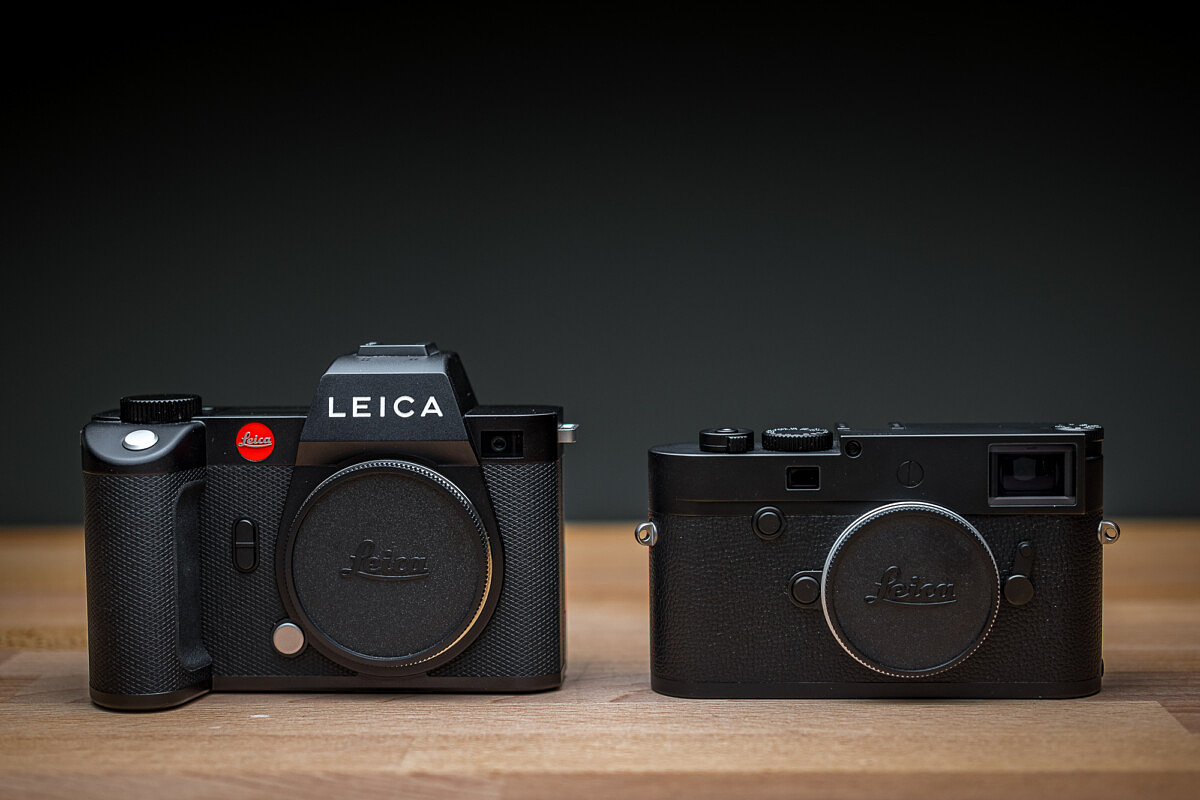
For our last comparison, I've matched upward the 47 megapixel SL2 with the 41 megapixel M10 Monochrom. Both are displayed at their native resolution at 100%. As I outlined in the introduction, the SL2 images were converted to blackness and white using Lightroom's default Adobe Monochrome profile, with minimal Basic Tone edits and small tweaks in the Black & White Mix palette to improve approximate the tonal response of the M10M.
What surprises me the about here is only how much of an obvious resolution jump we see just with six additional megapixels. I would have figured the existent-globe departure to exist less noticeable.
ISO 200
Both the M10 Monochrom and the SL2 offer up incredible resolution and textural item at low ISO. For pure detail the SL2 has the border here as nosotros would expect given the pixel advantage.
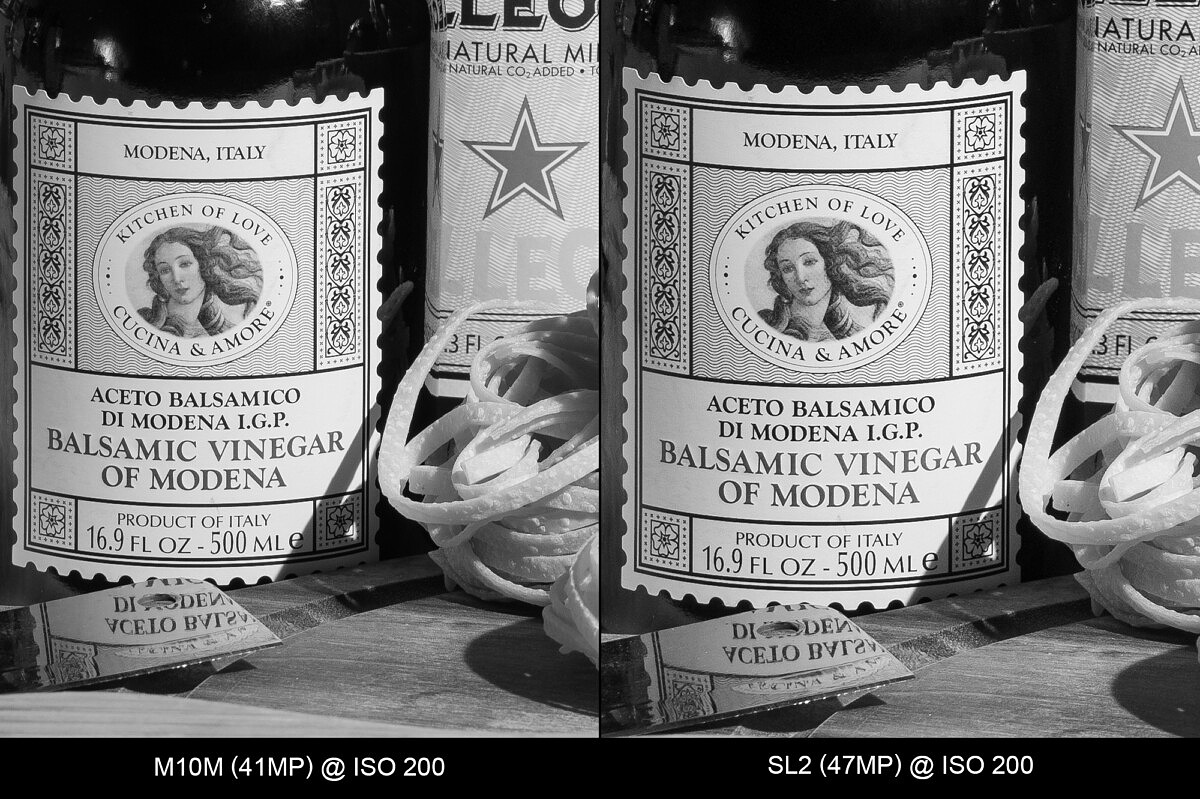
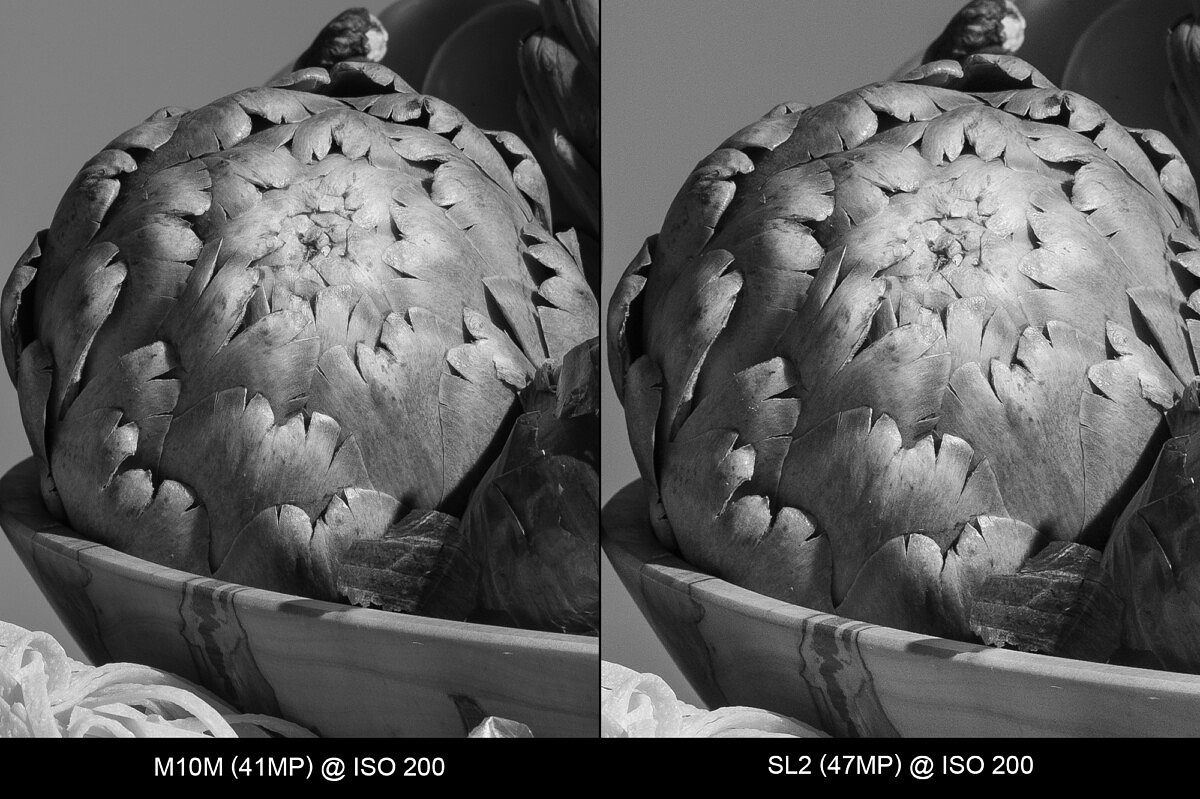
ISO 400
As expected, not much changes at ISO 400. Interestingly, the M10M is completely noise-costless, while the SL2 shows very tightly patterned noise. This takes away aught from the image, and I suppose I could accept used more aggressive noise reduction for the SL2, but shows the advantage of no per-channel gain for the M10 Monochrom.
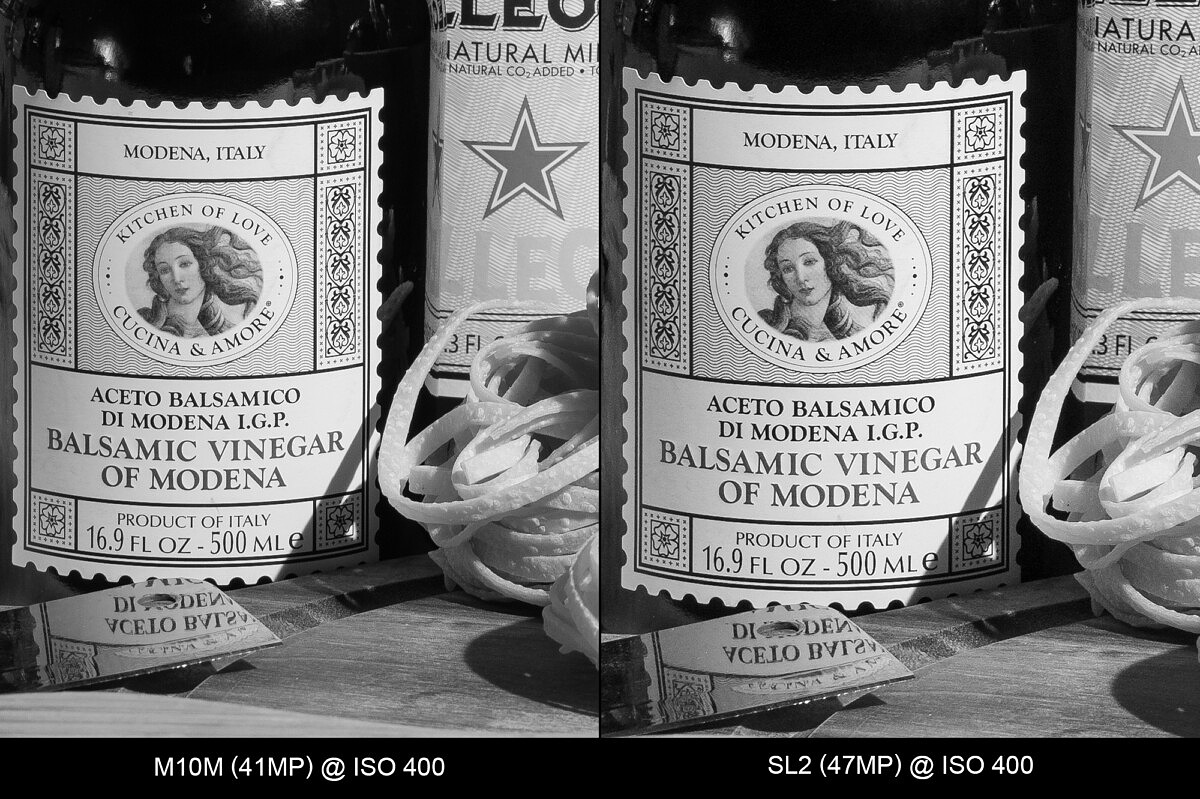
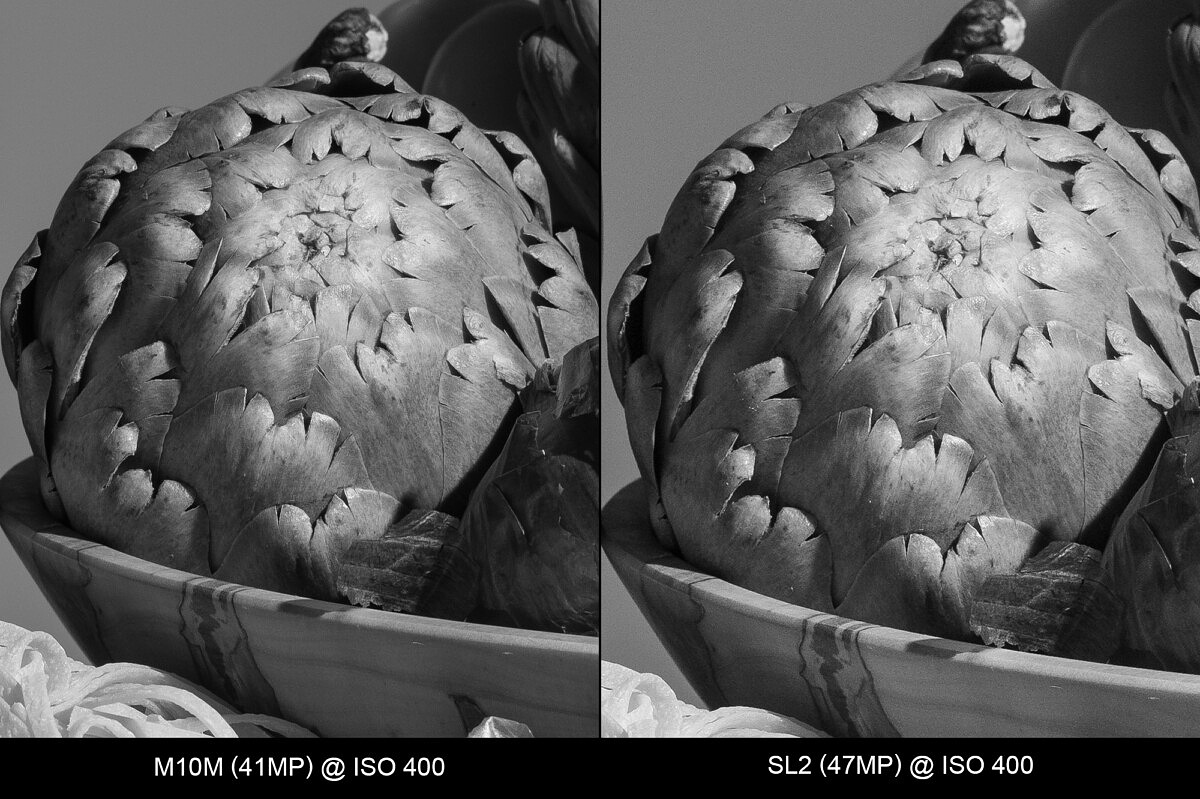
ISO 800
At ISO 800, we see very like results to ISO 400. Both cameras continue to produce largely noise-free images with outstanding item.
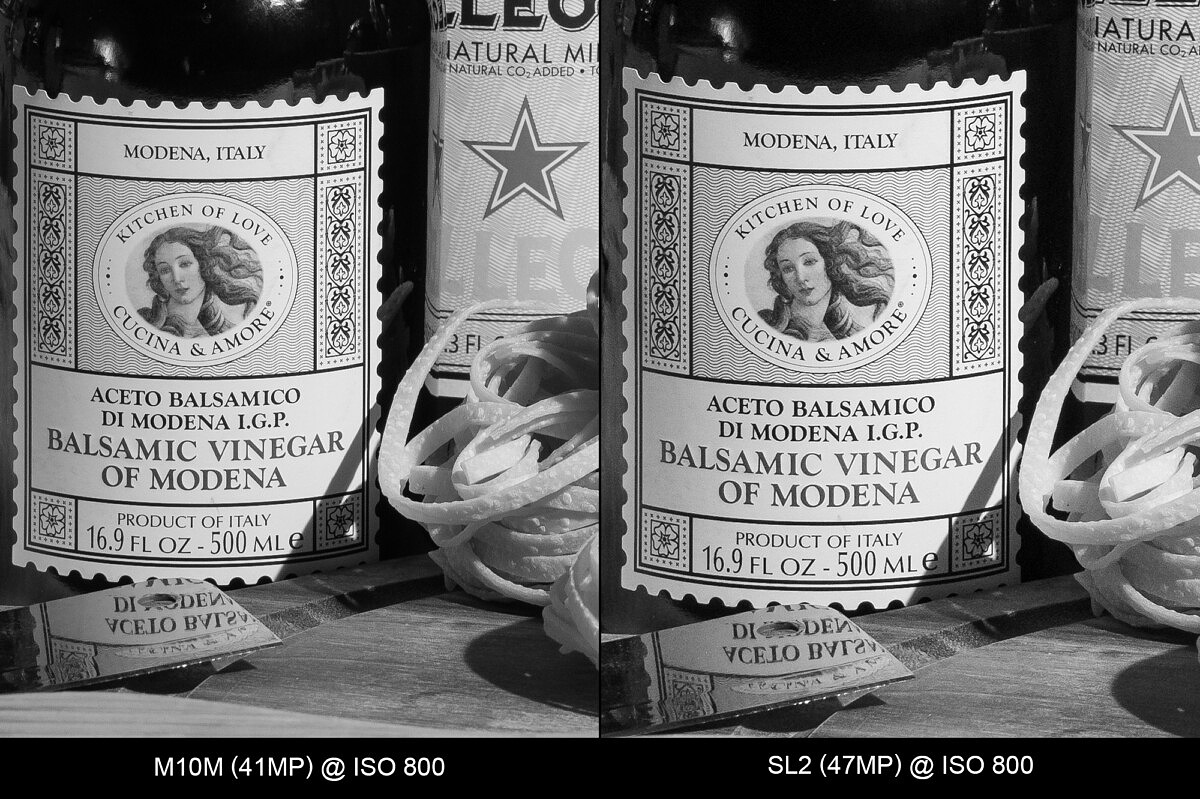
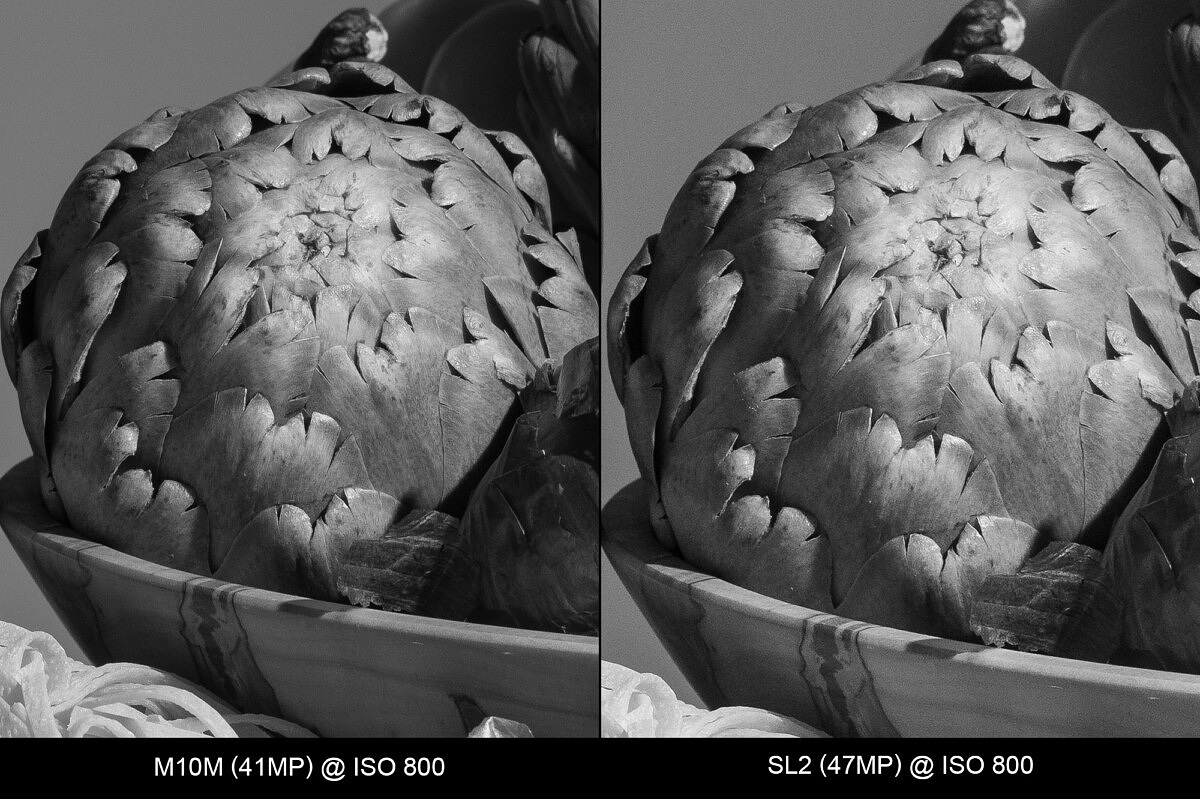
ISO 1600
At ISO 1600, the M10M continues to be perfect. The SL2 is starting to lose but a bit of fine detail. Also, of note is that the SL2 exposure seems to be getting darker and less contrasty. This trend volition continue as the ISO increases. My guess is that the dynamic range is starting to suffer and this is the visible result. If I had chosen to adjust tone settings on a per-paradigm footing rather than per-camera, some of this could have been compensated for.
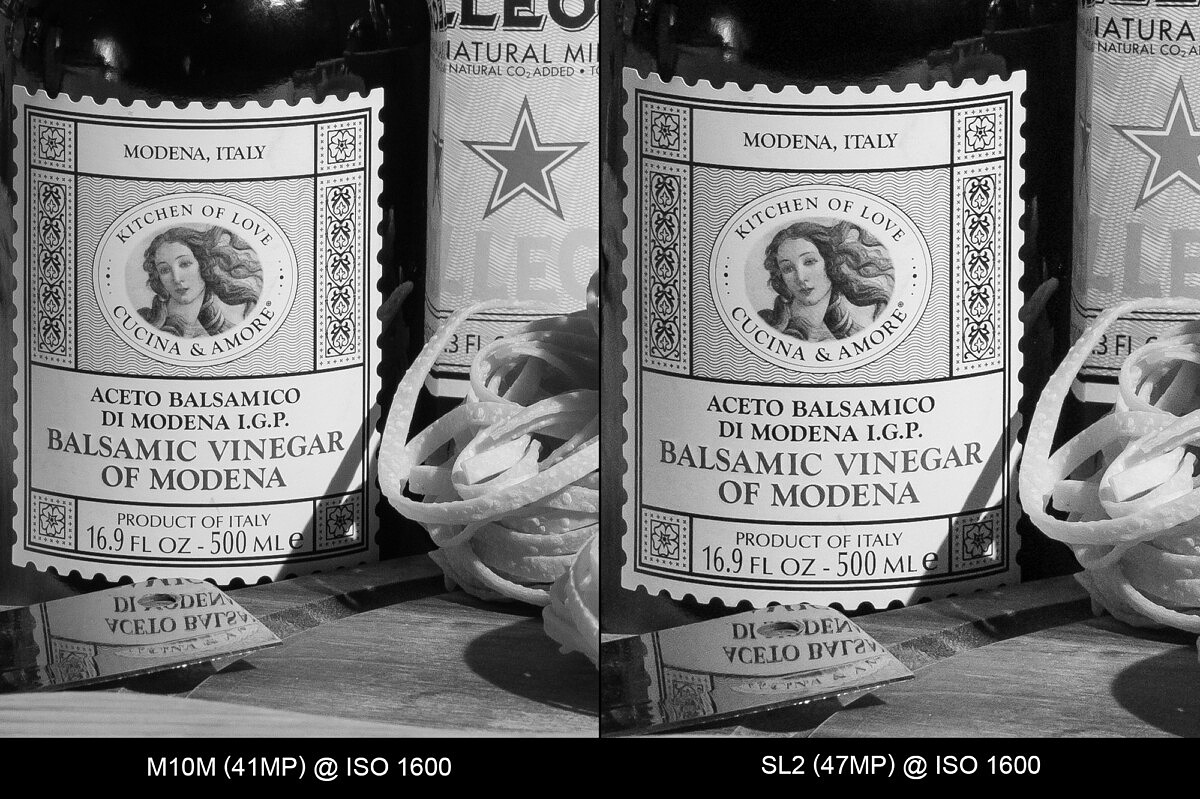
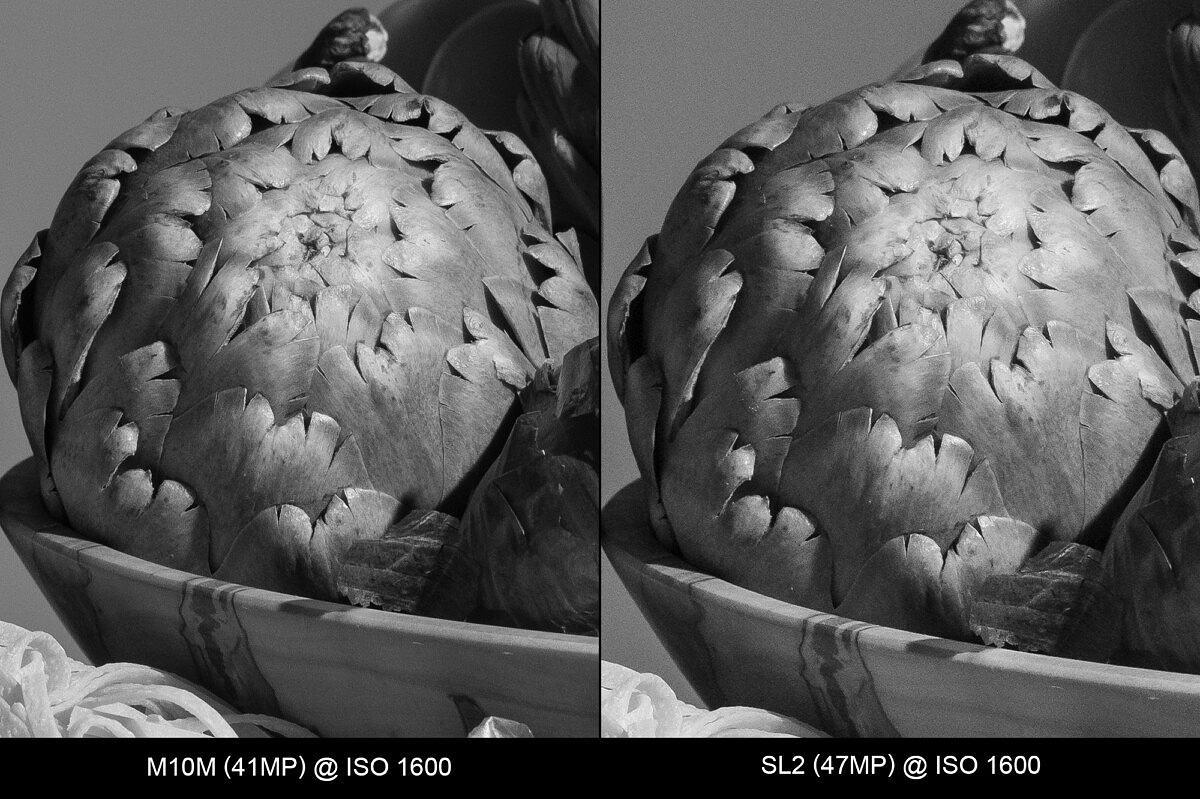
ISO 3200
Performance at ISO 3200 is very similar to ISO 1600. Both cameras expect first-class.
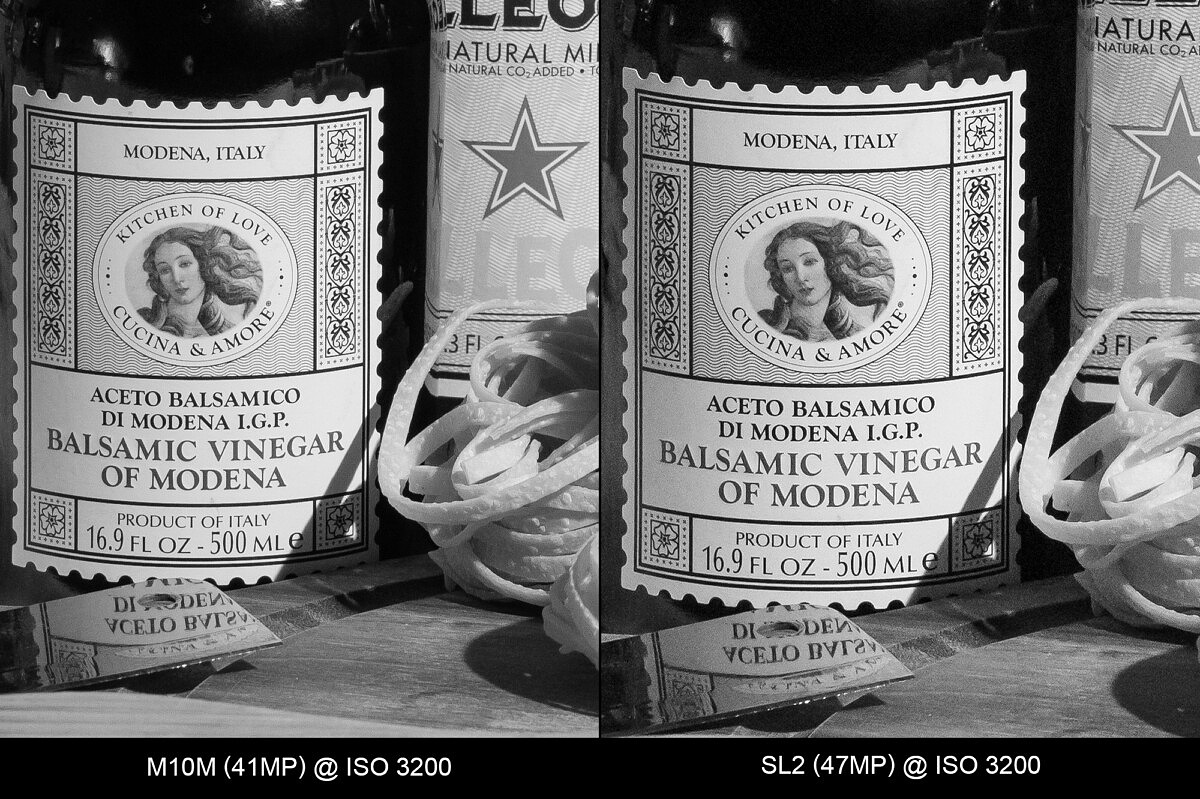
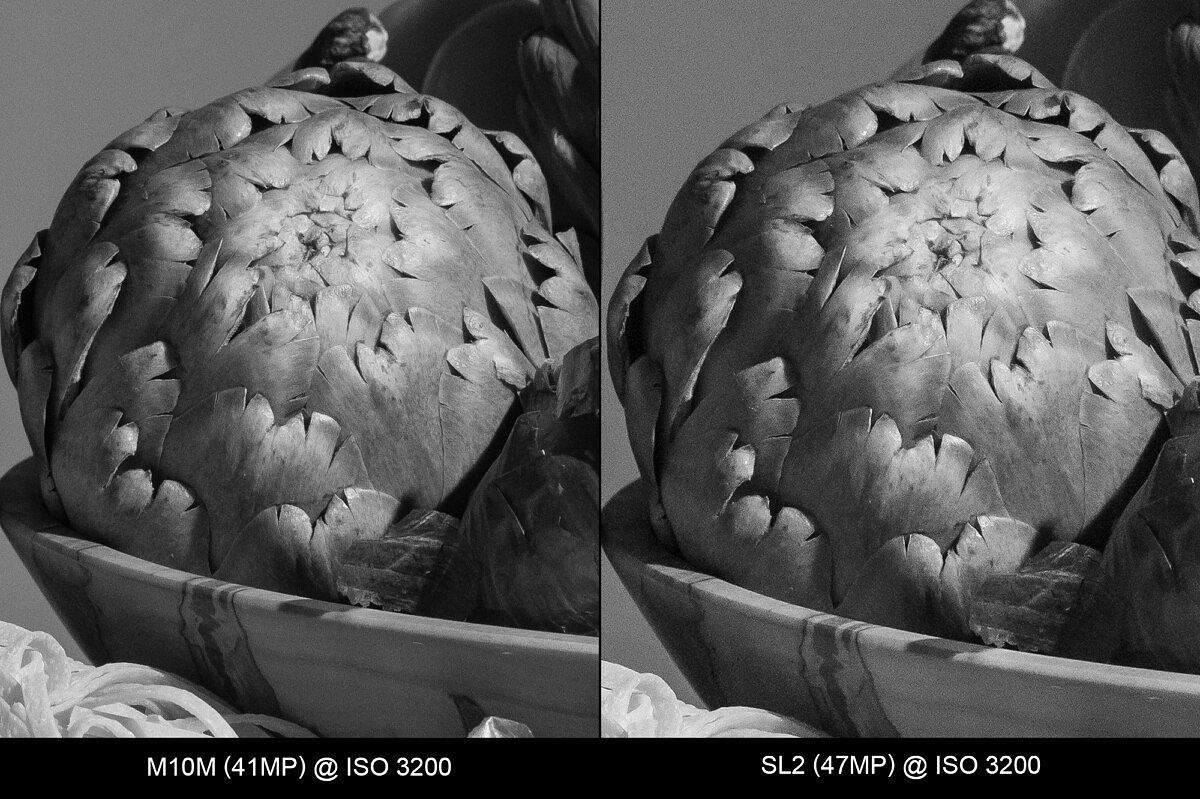
ISO 6400
While the M10M continues trucking along at ISO 6400, the SL2 is starting to show a slight decrease in overall paradigm quality. A bit more noise, a little less item and a minor drop in dynamic range all contribute here. ISO 6400 is however completely usable on the SL2, simply non equally good equally staying below ISO 3200.
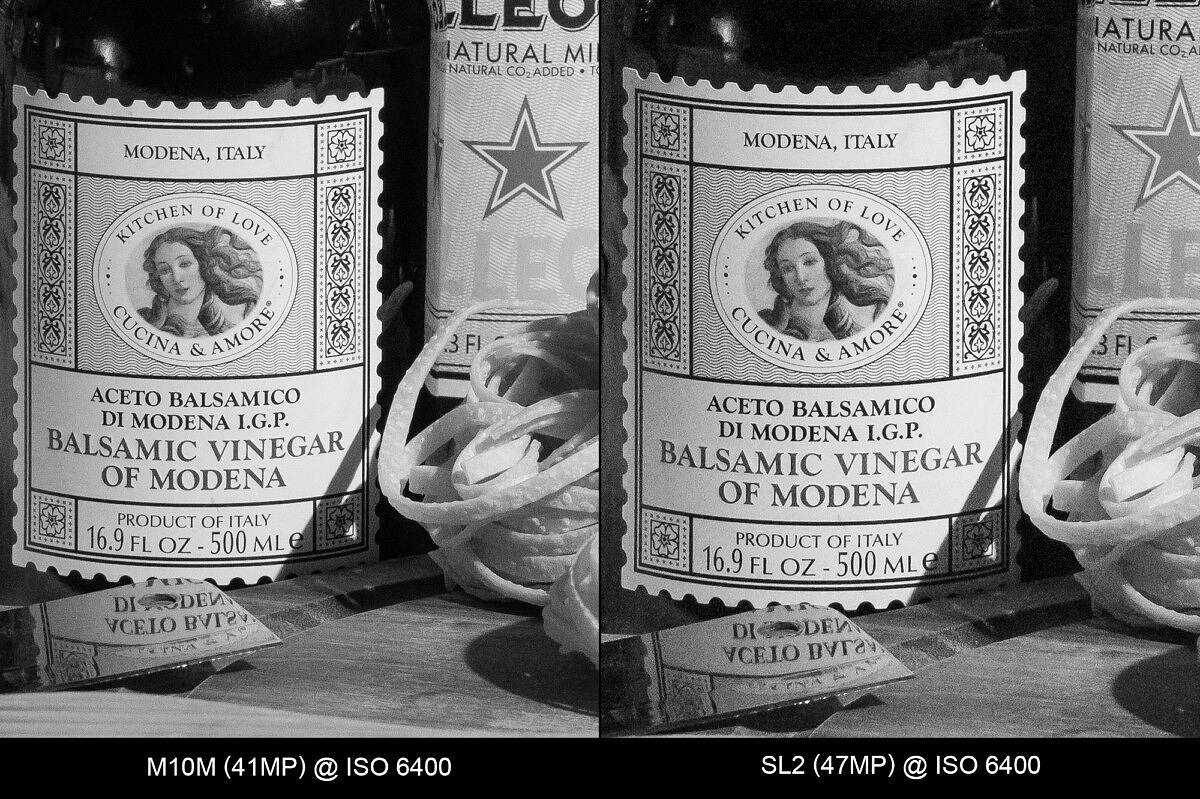
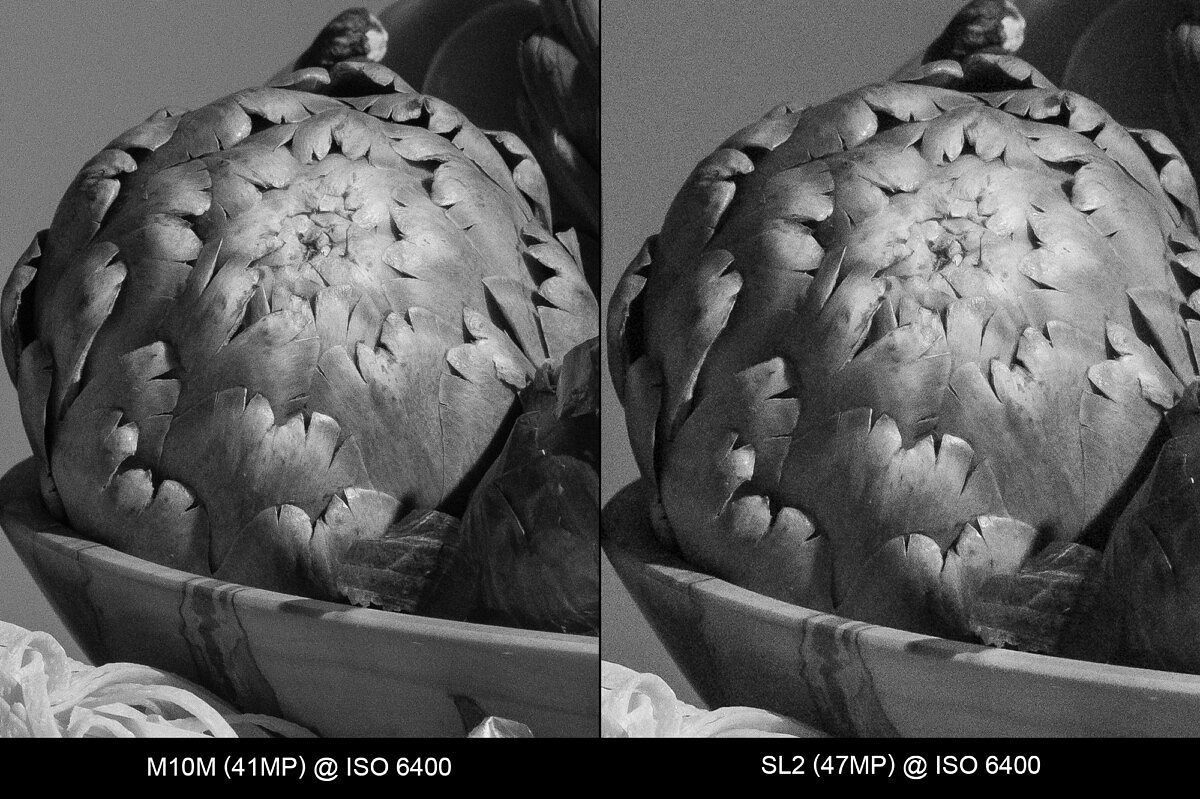
ISO 8000 vs. 6400
Because the SL2 only has whole ISO steps, nosotros're going to lock it in at ISO 6400 while ticking up another 3rd for theM10M. And no surprise here. The M10M looks amend at ISO 8000 than the SL2 does at ISO 6400.
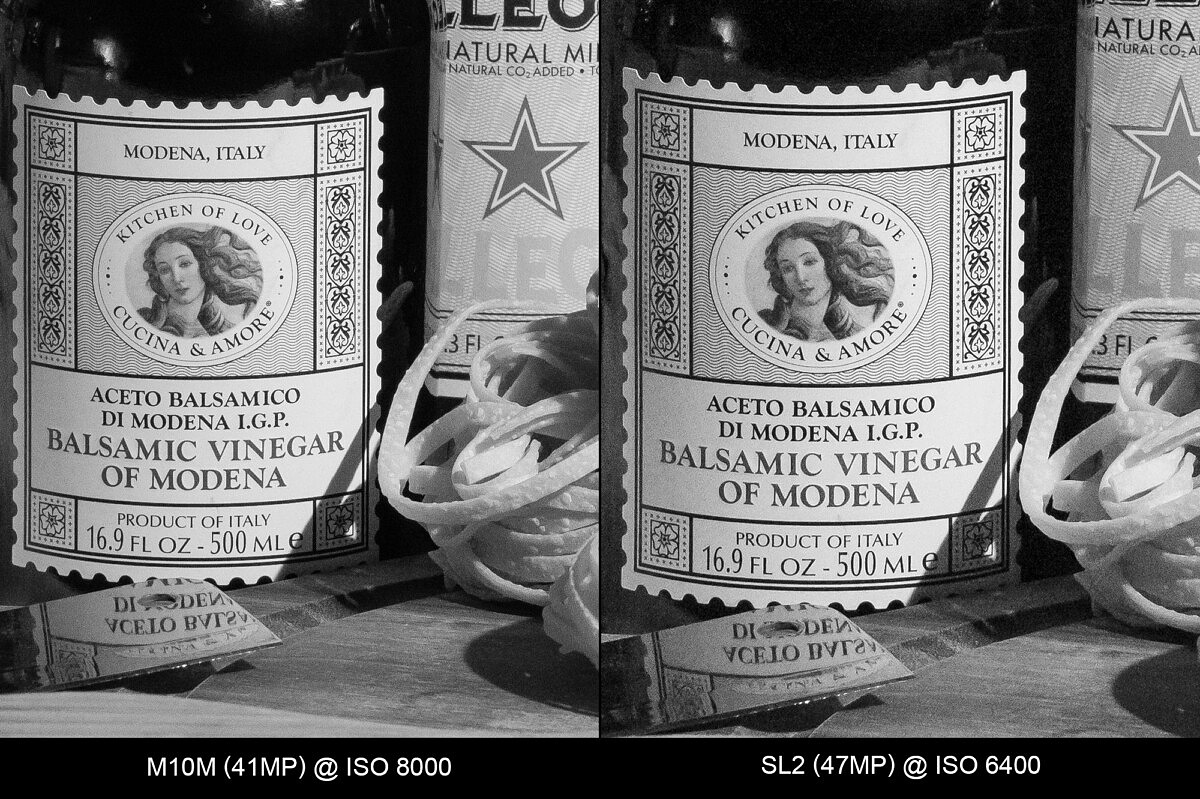
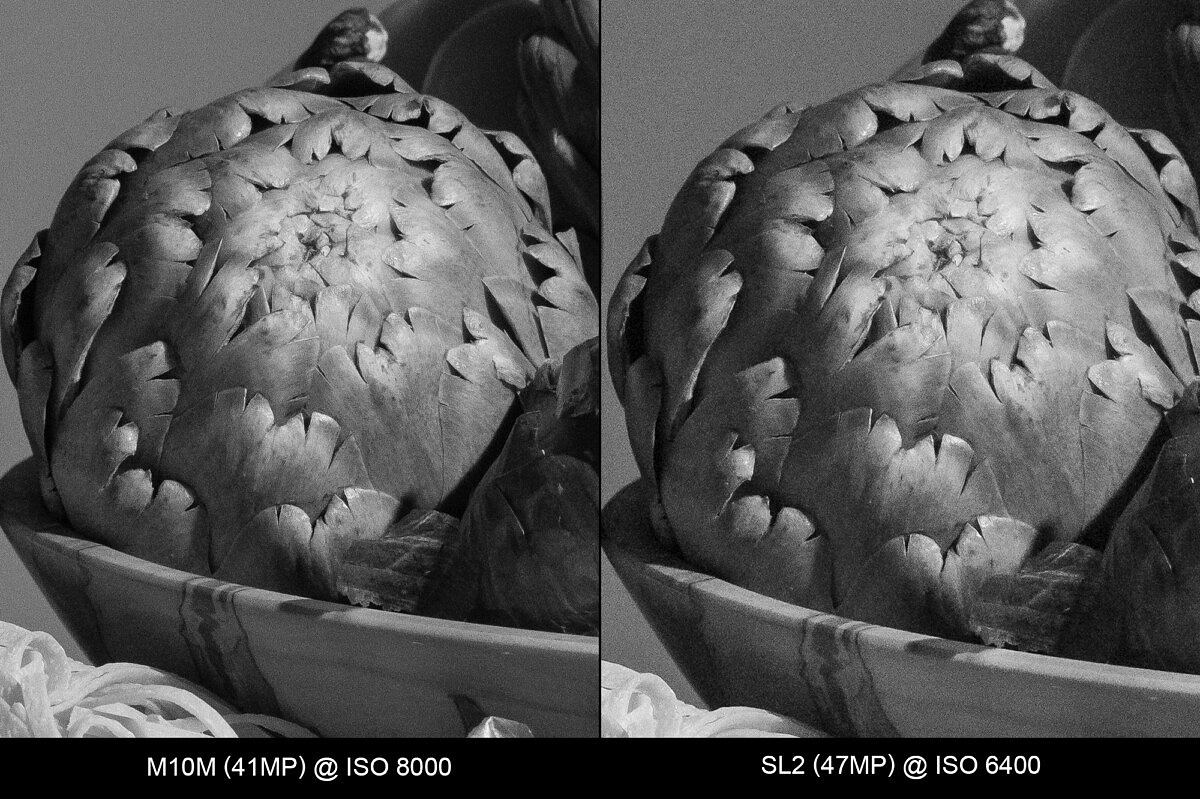
ISO 10000 vs. 6400
At ISO 10000 the M10M is producing equivalent image quality to the SL2 at ISO 6400. And as nosotros'll see after jumping to ISO 12500, this volition exist the all-time instance for the SL2.
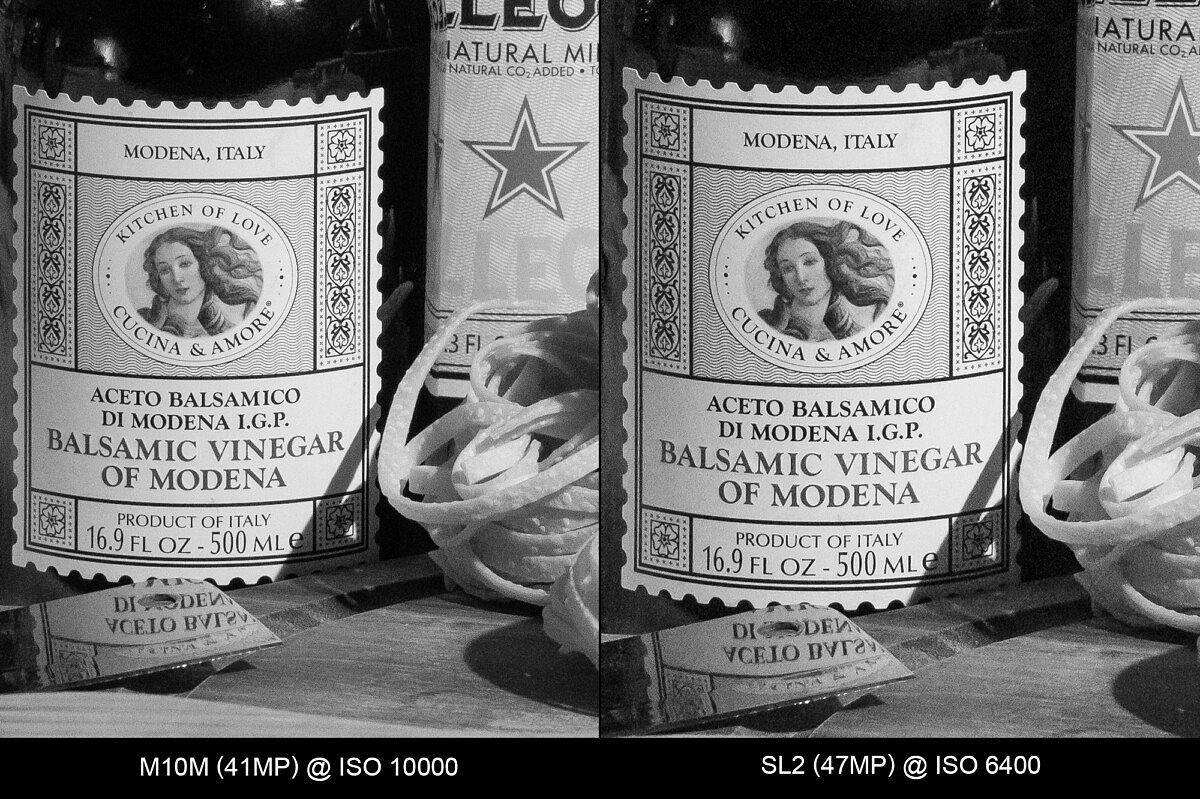
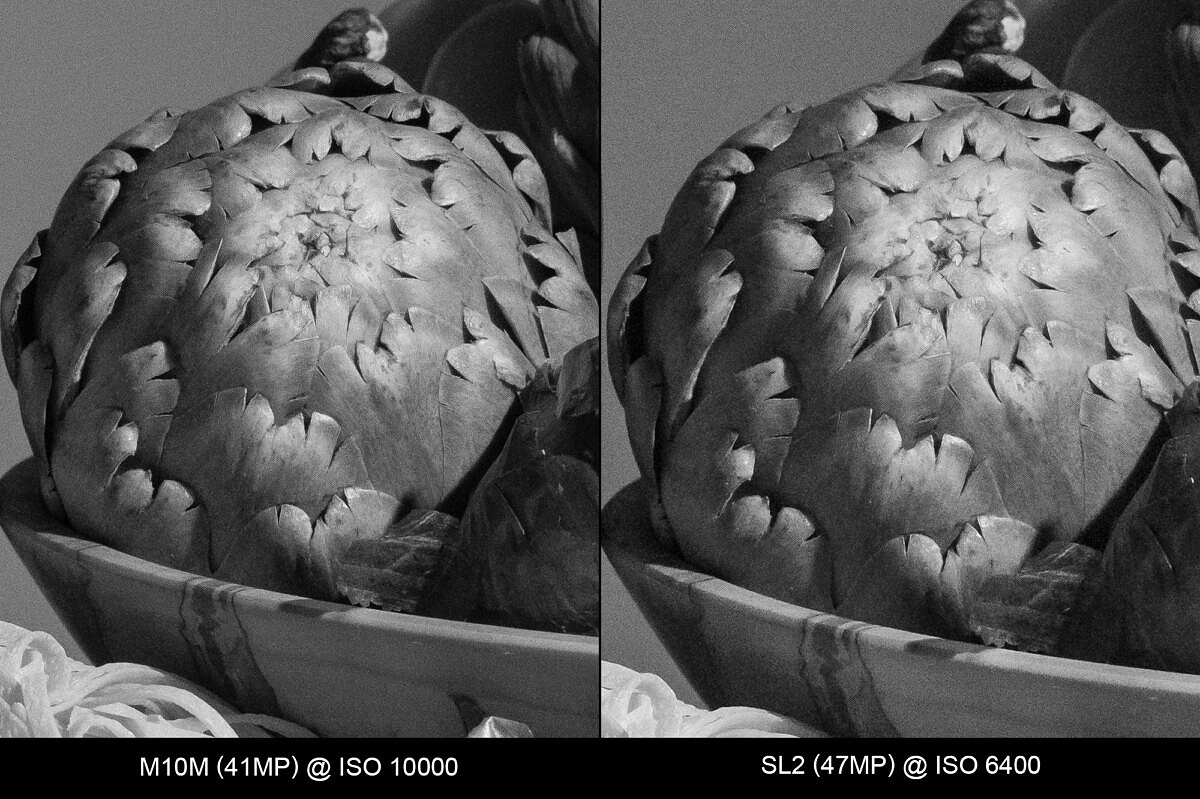
ISO 12500
Now, with the SL2 bumped upwardly to ISO 12500, the M10M pulls ahead significantly. The M10M however looks roughly the same every bit ISO 10000, but the SL2 is showing noticeable degradation.
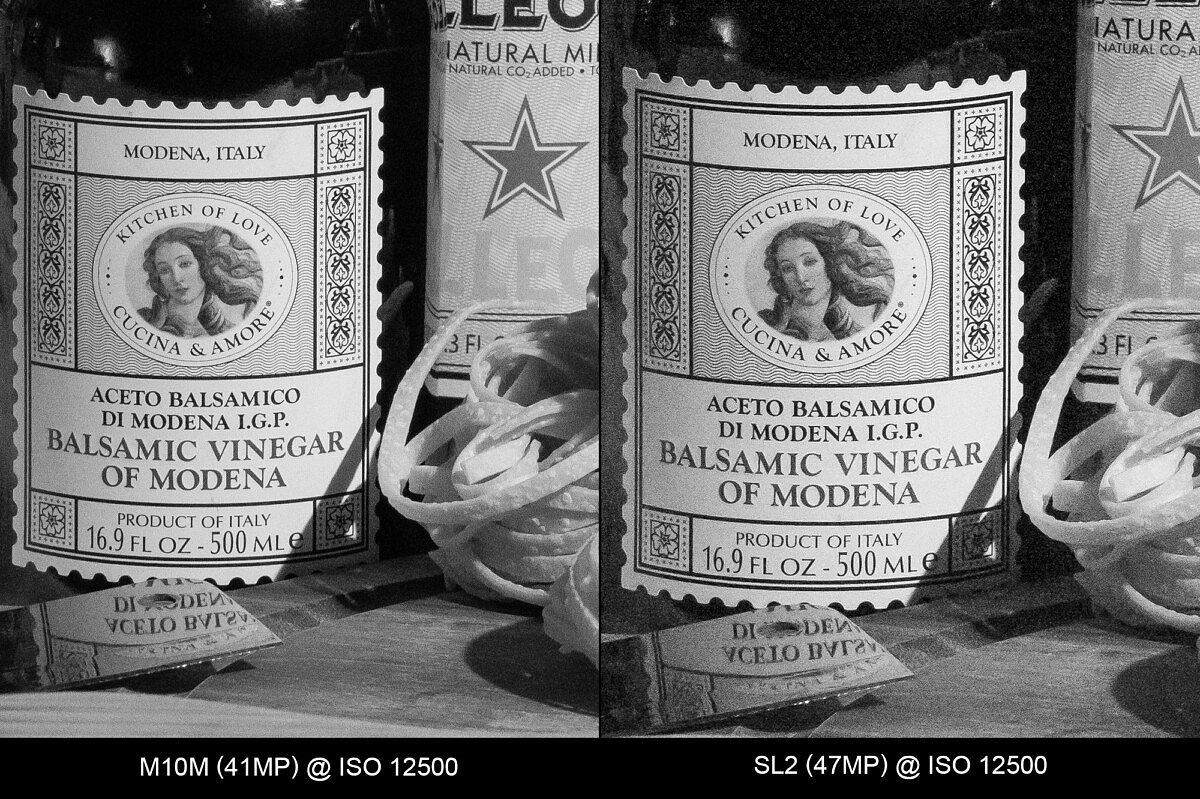
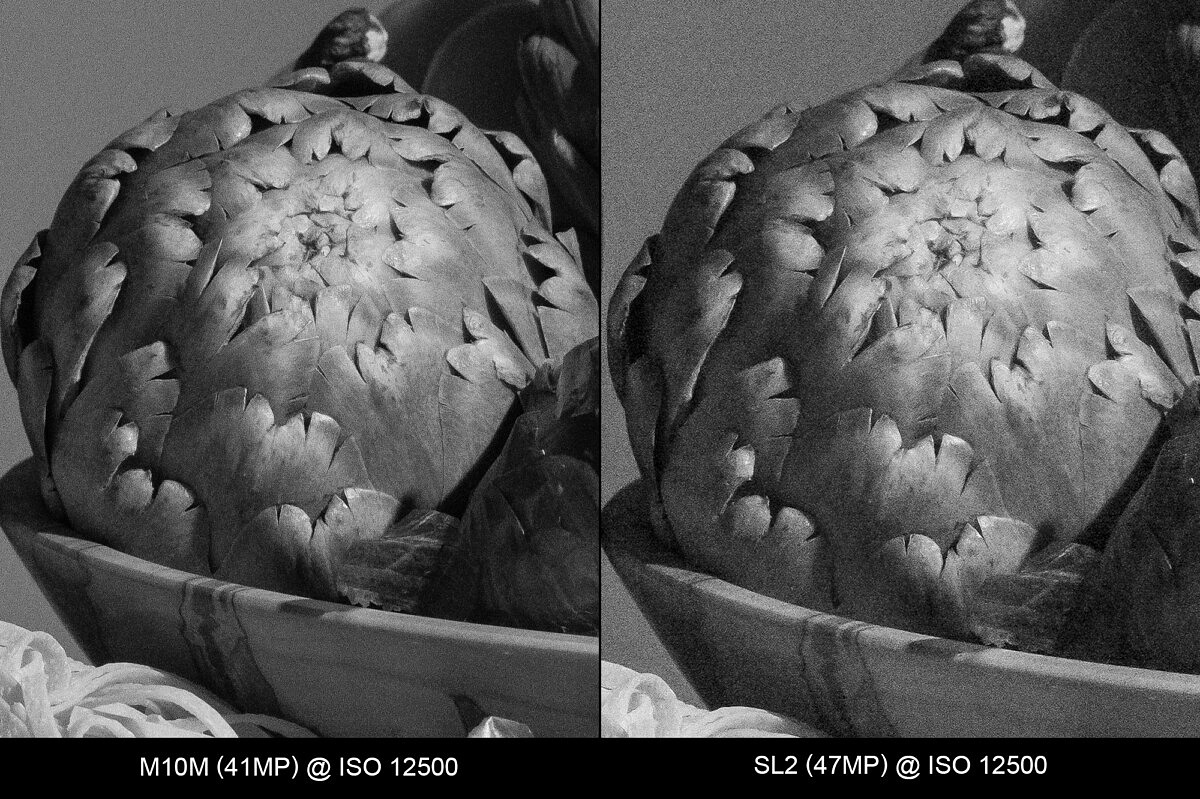
ISO 16000 vs. 12500
At ISO 16000 and 20000, the M10M is much better than the SL2 at ISO 12500.
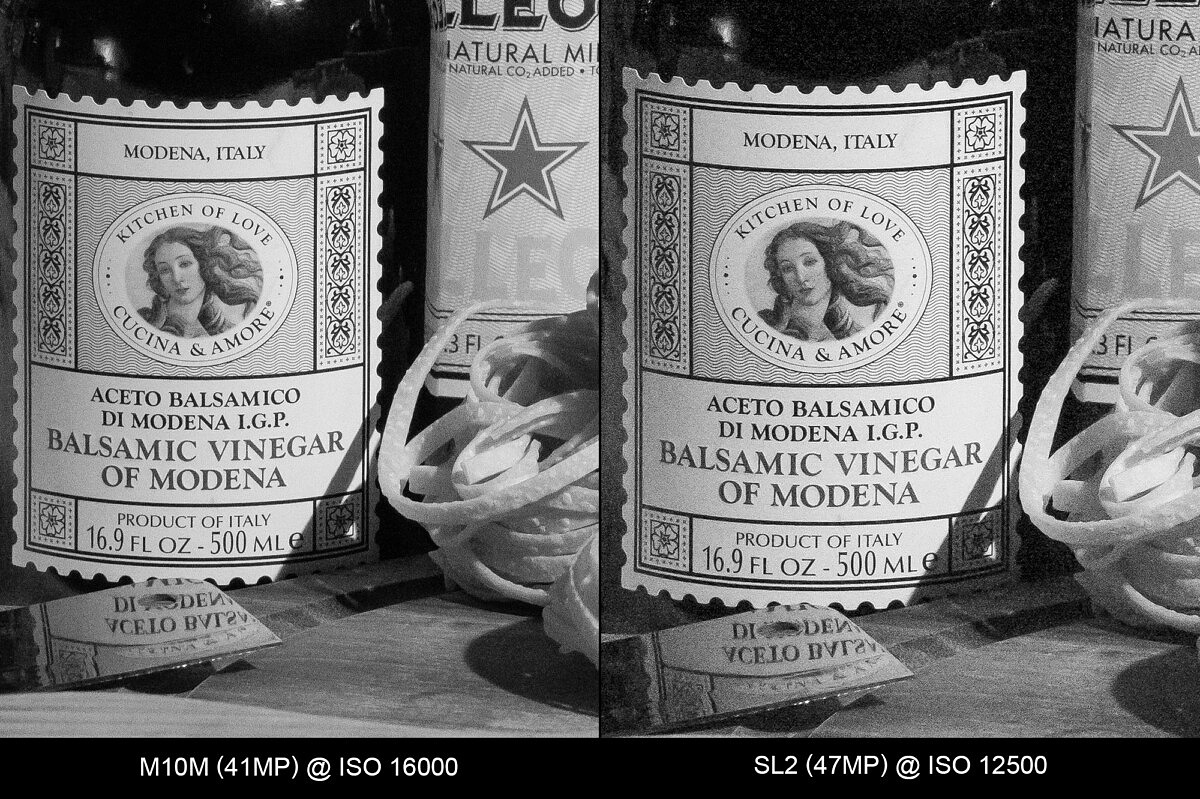
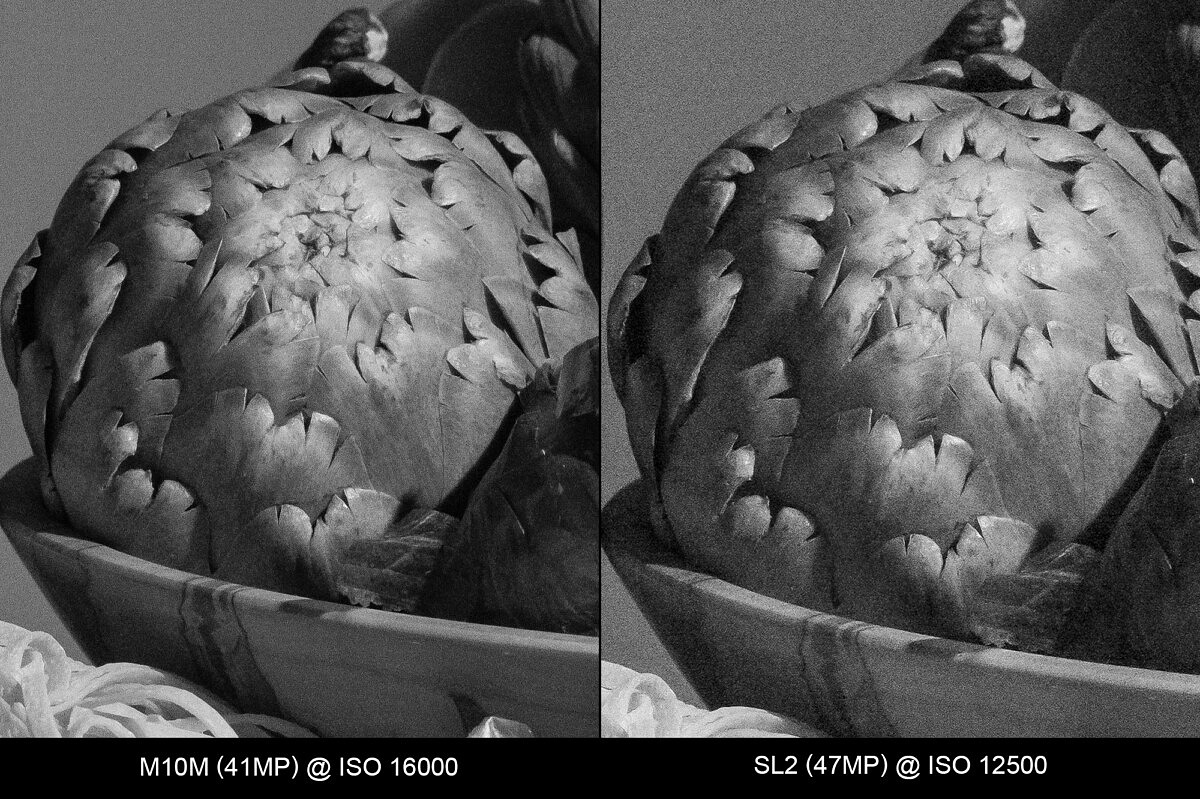
ISO 20000 vs. 12500
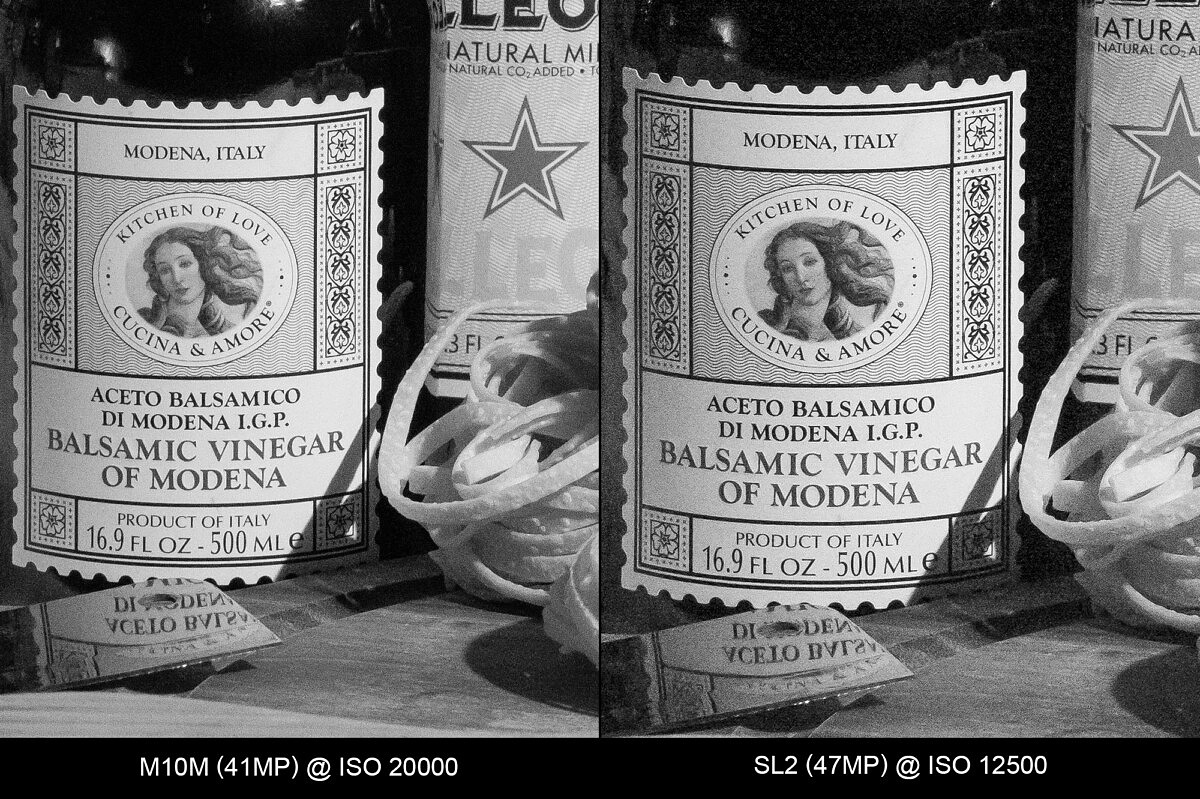
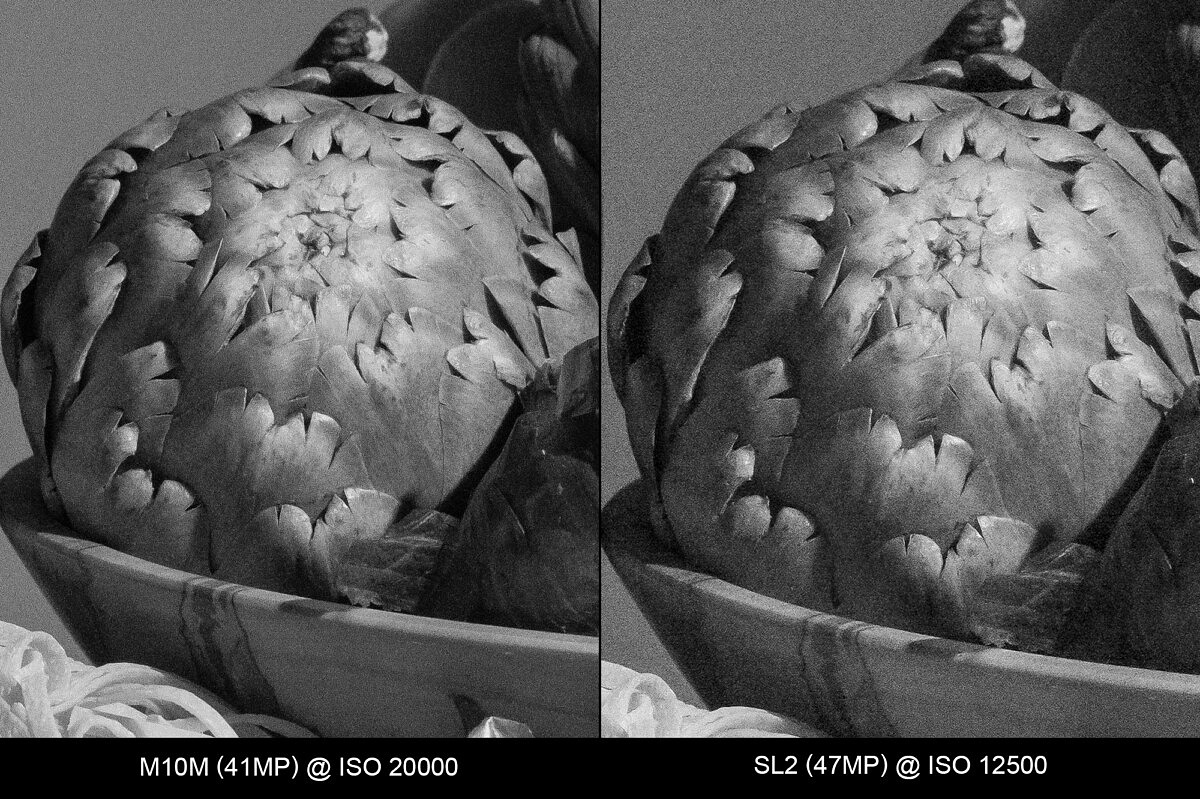
ISO 25000
At 1 stop from its maximum ISO setting, the SL2 is no match for the M10M. The quality difference observed at ISO 12500 – 20000 is fifty-fifty more than pronounced here. While I'd consider the results at 25000 to be borderline usable on the SL2, the M10M however looks great.
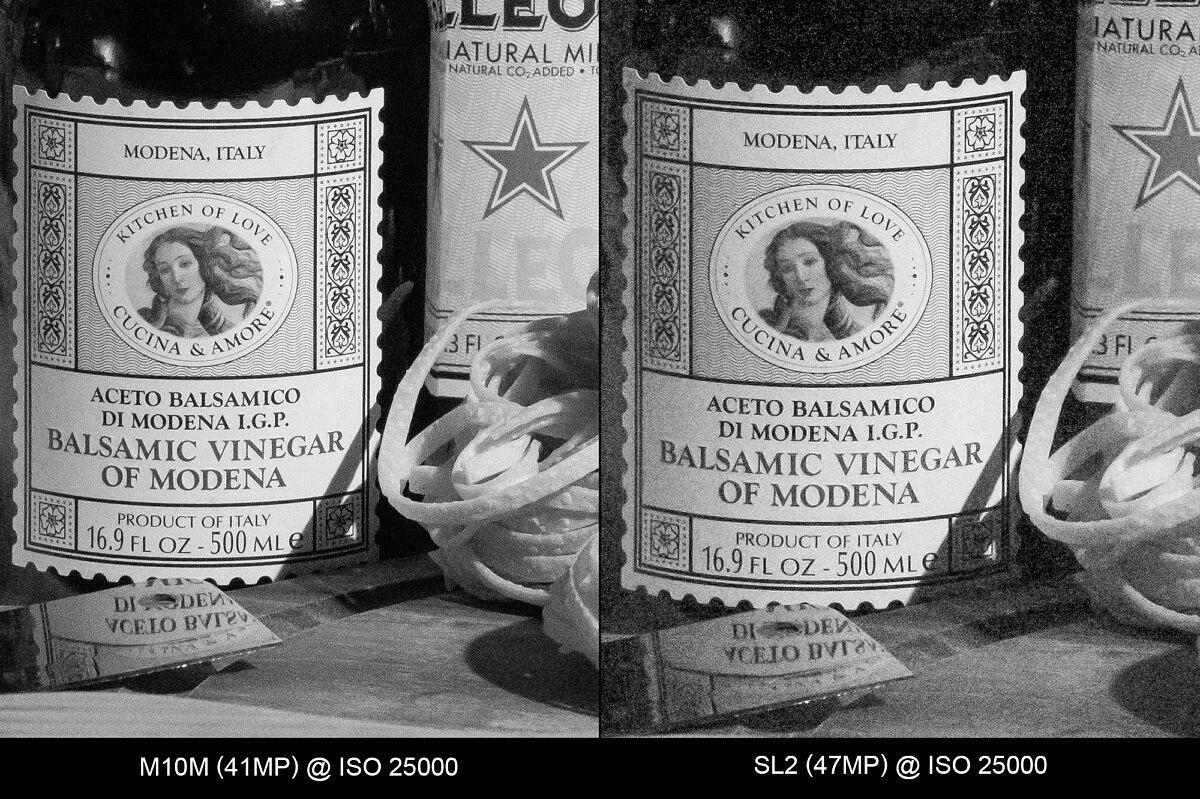
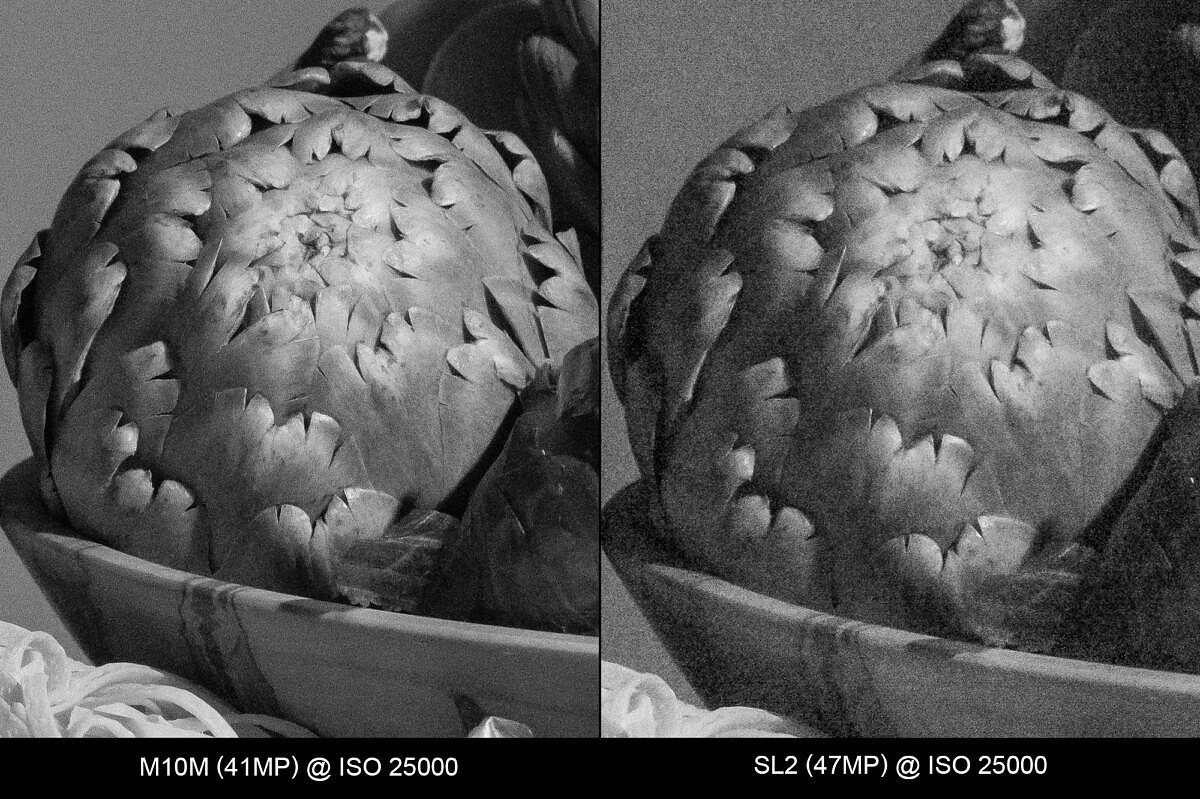
ISO 32000 vs. 25000
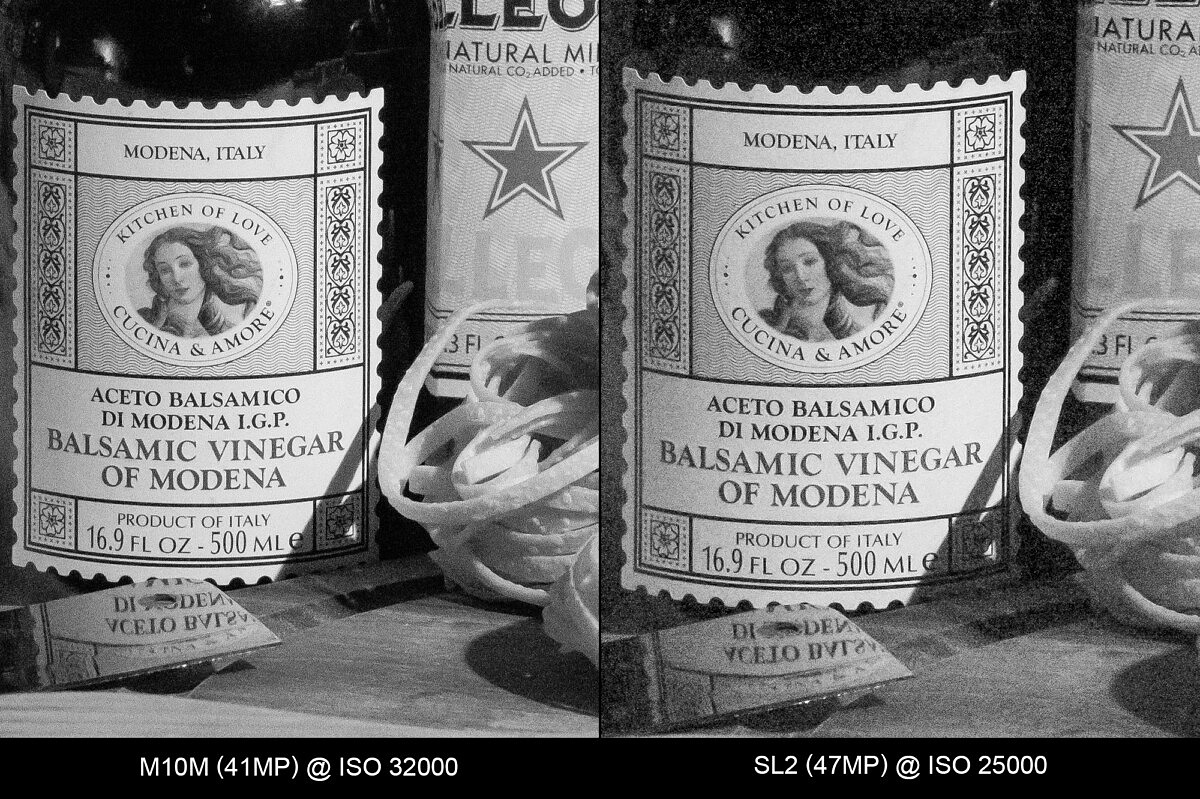
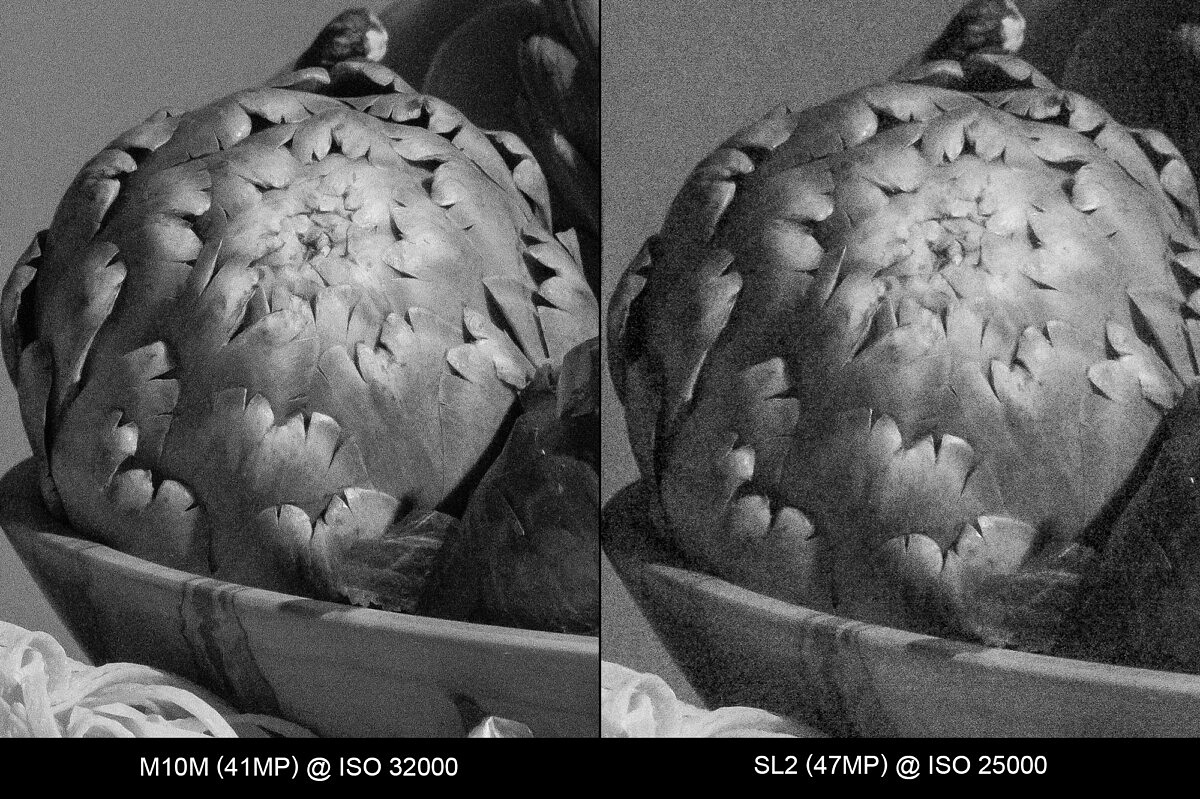
ISO 40000 vs. 25000
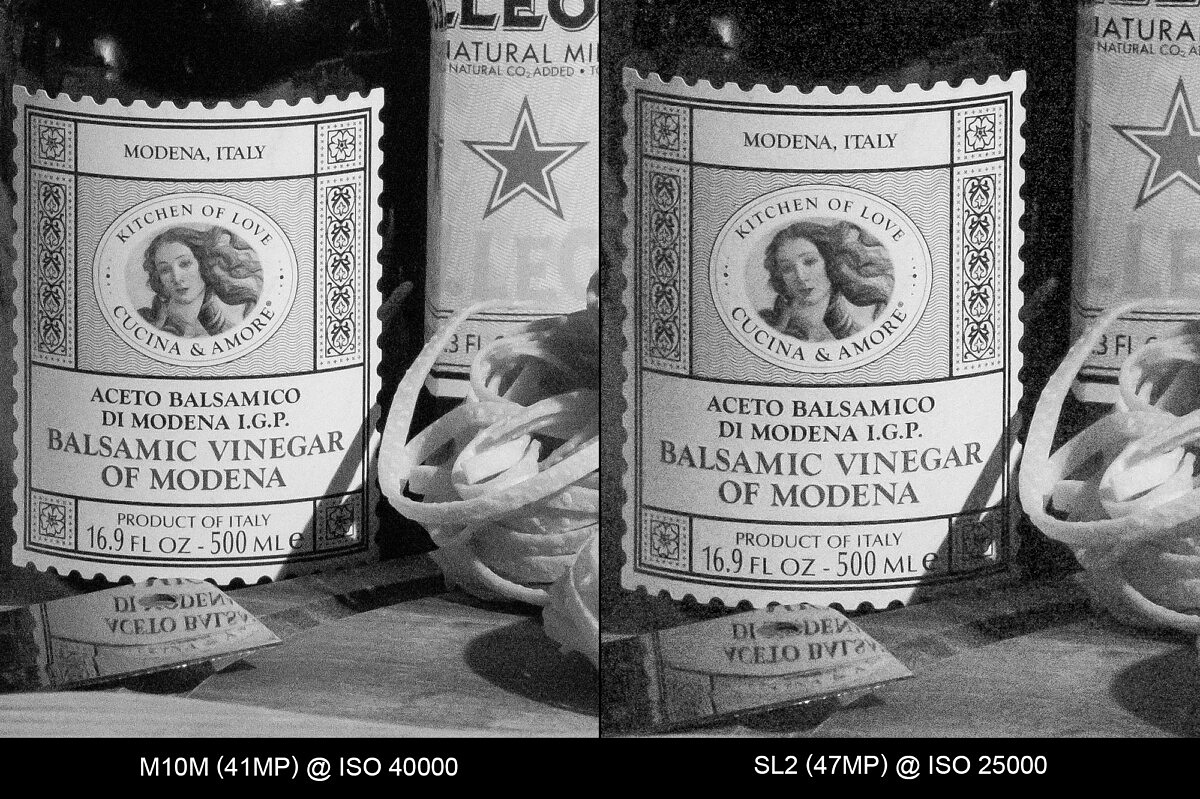
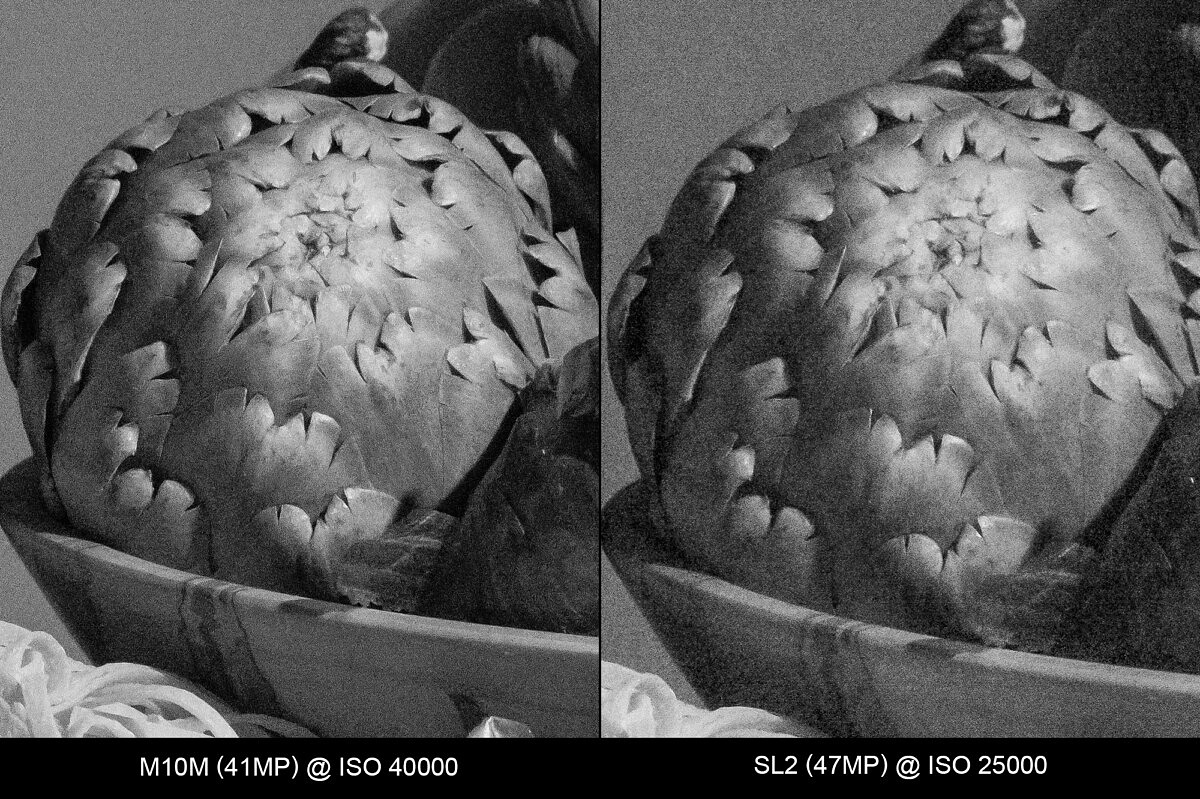
ISO 50000
Now at the upper limit of the the SL2, results at ISO 50,000 are fairly unusable. There is an overwhelming corporeality of noise, even with aggressive racket reduction. Particular is sacrificed both due to noise, noise reduction and lack of dynamic range. Meanwhile, the M10M continues to put upward a decent epitome.
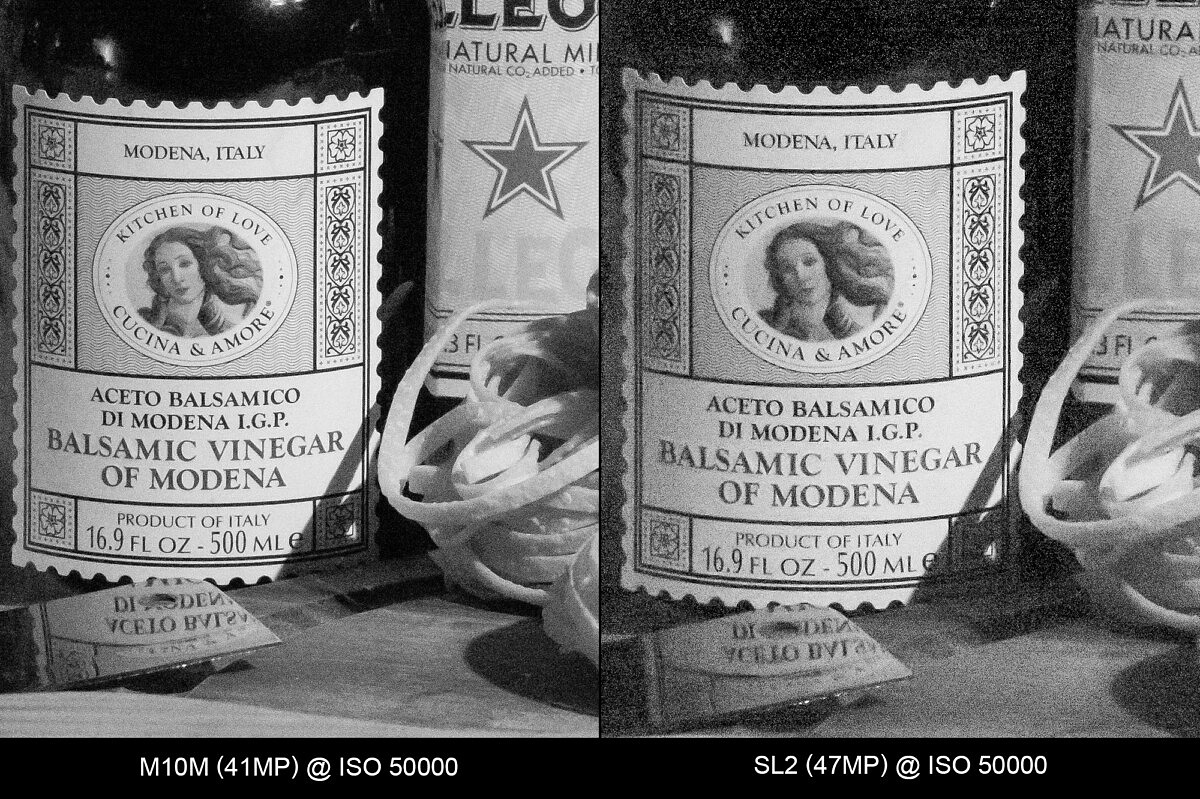
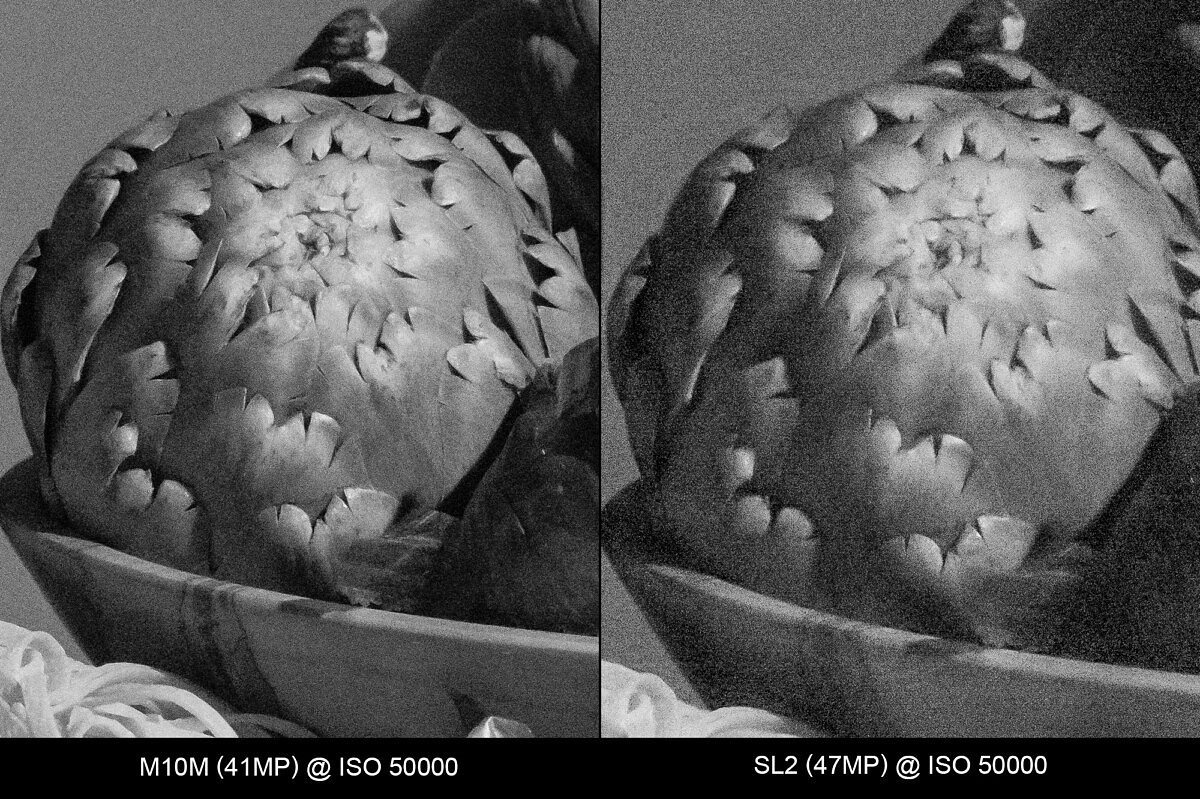
ISO 64000 vs. 50000
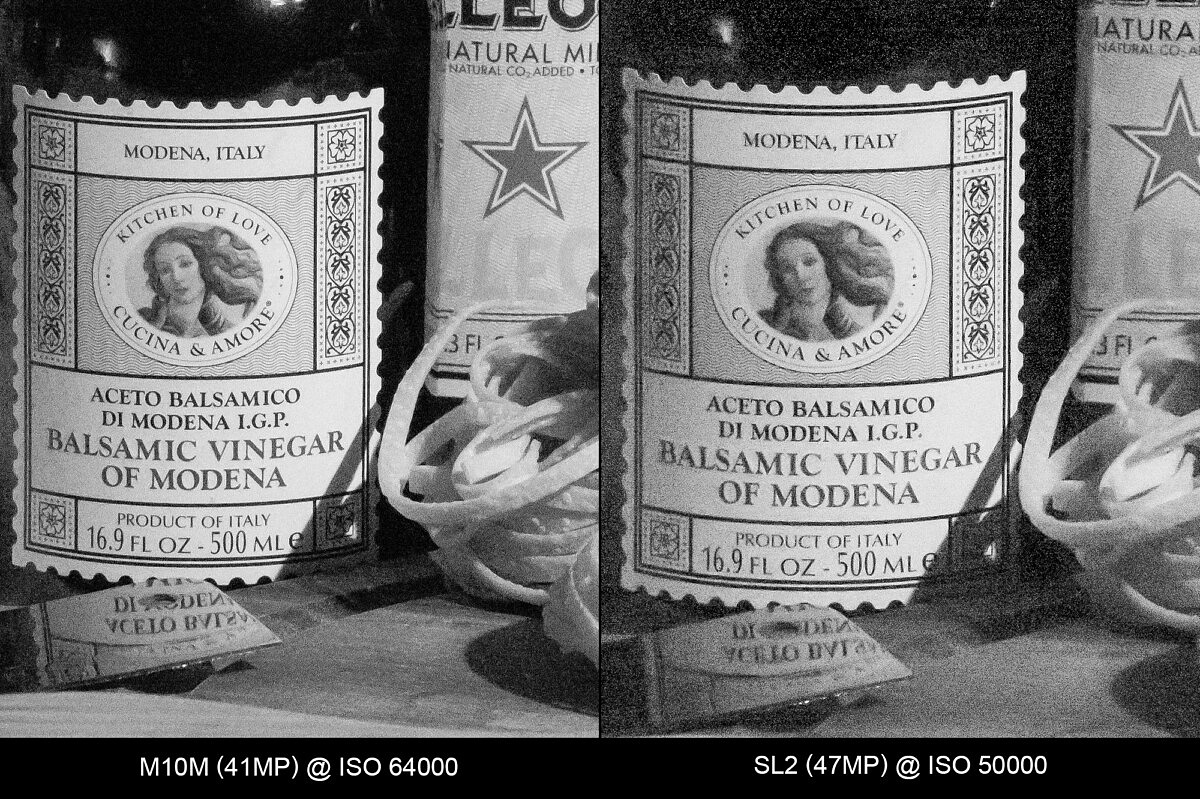
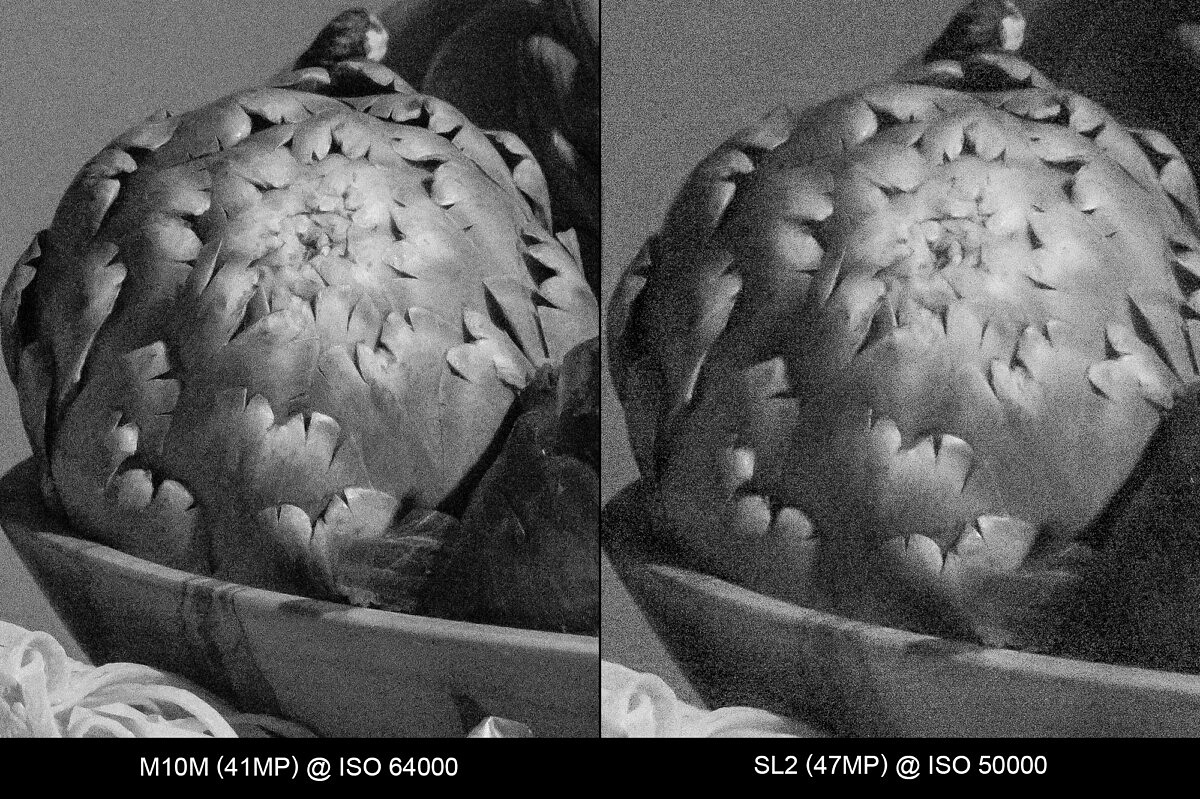
ISO 80000 vs. 50000
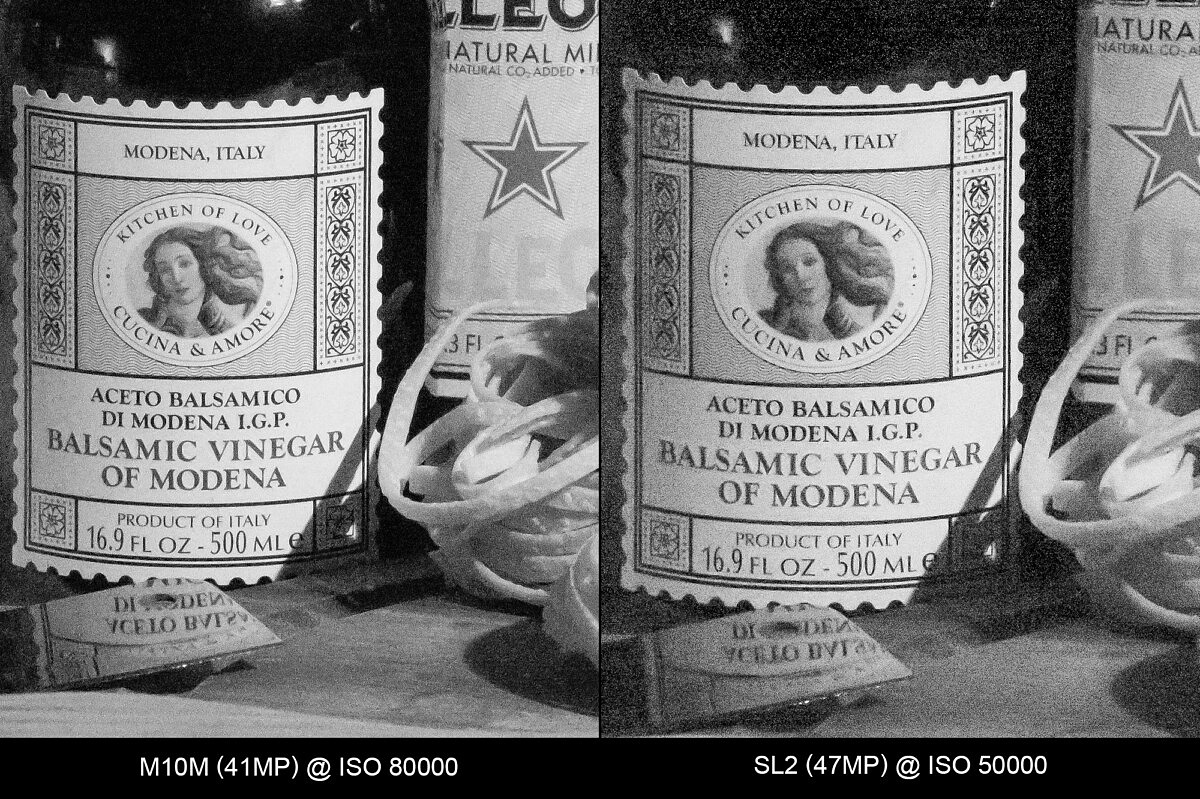
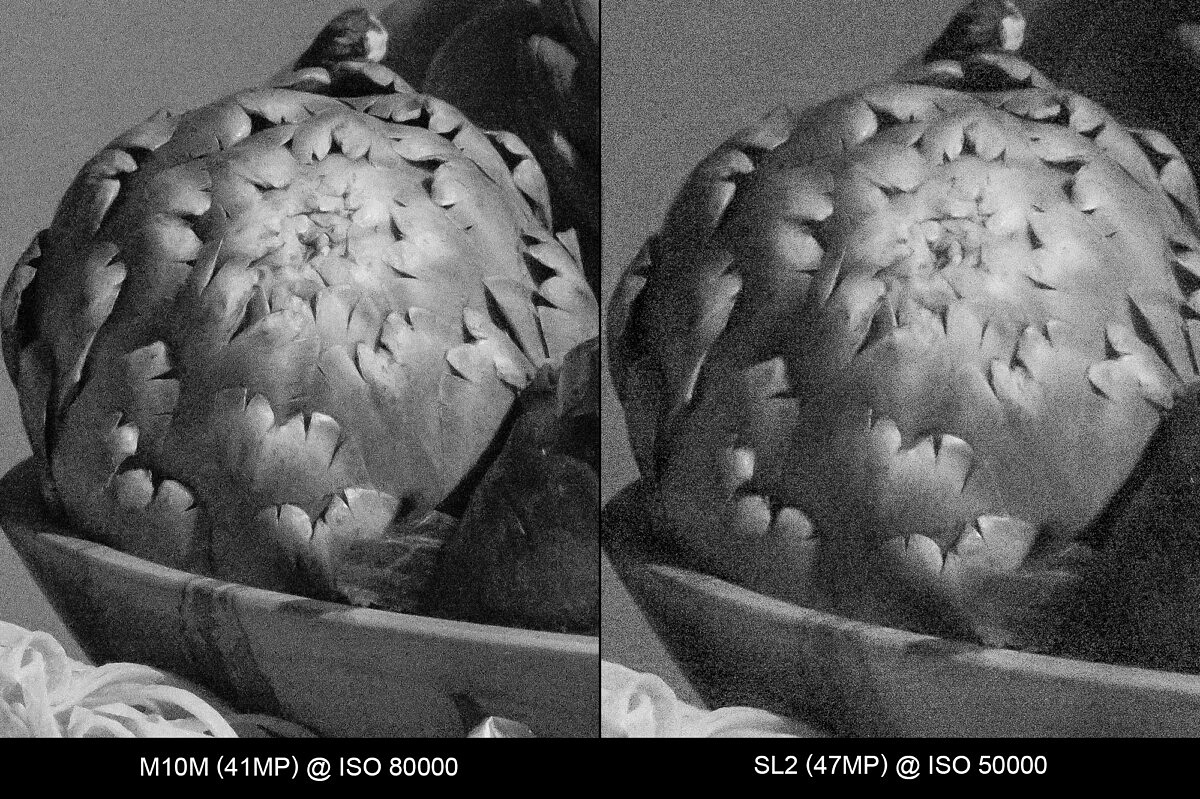
ISO 100000 vs. 50000
Even when maxed out at ISO 100000, the M10M still produces a better epitome than the SL2 does at ISO 50000.
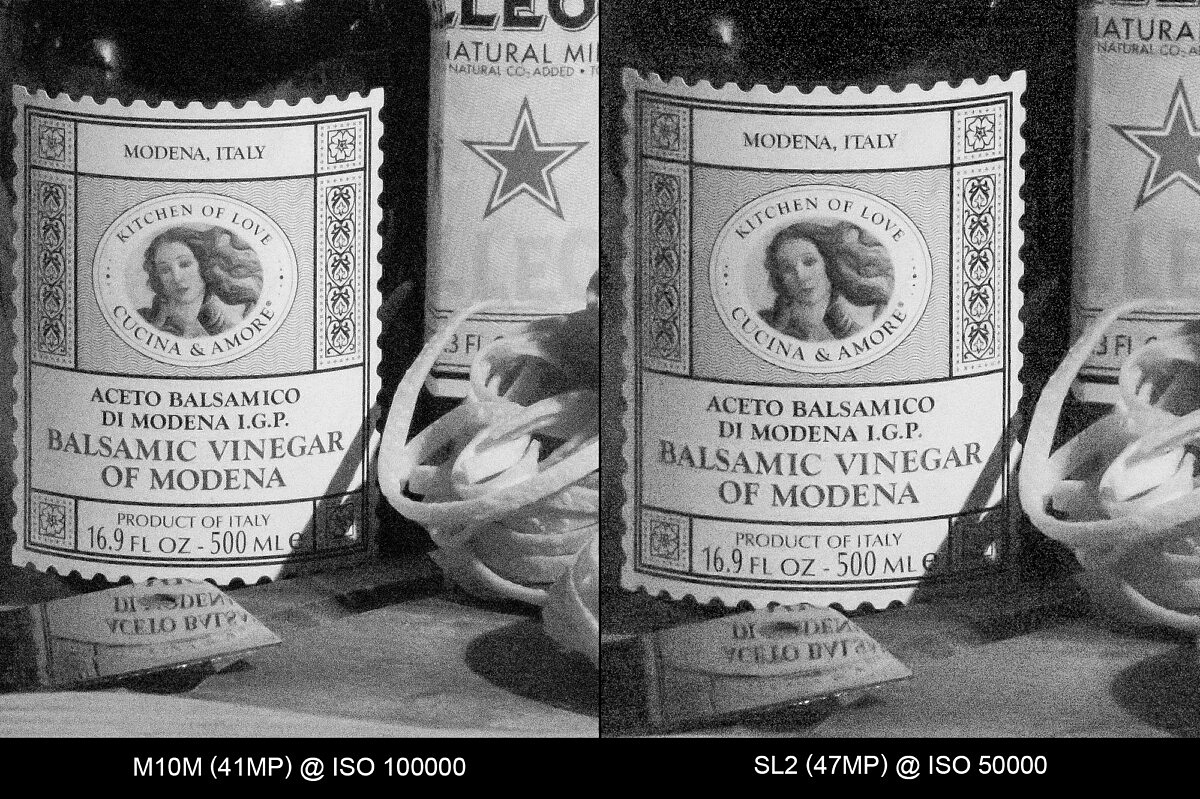
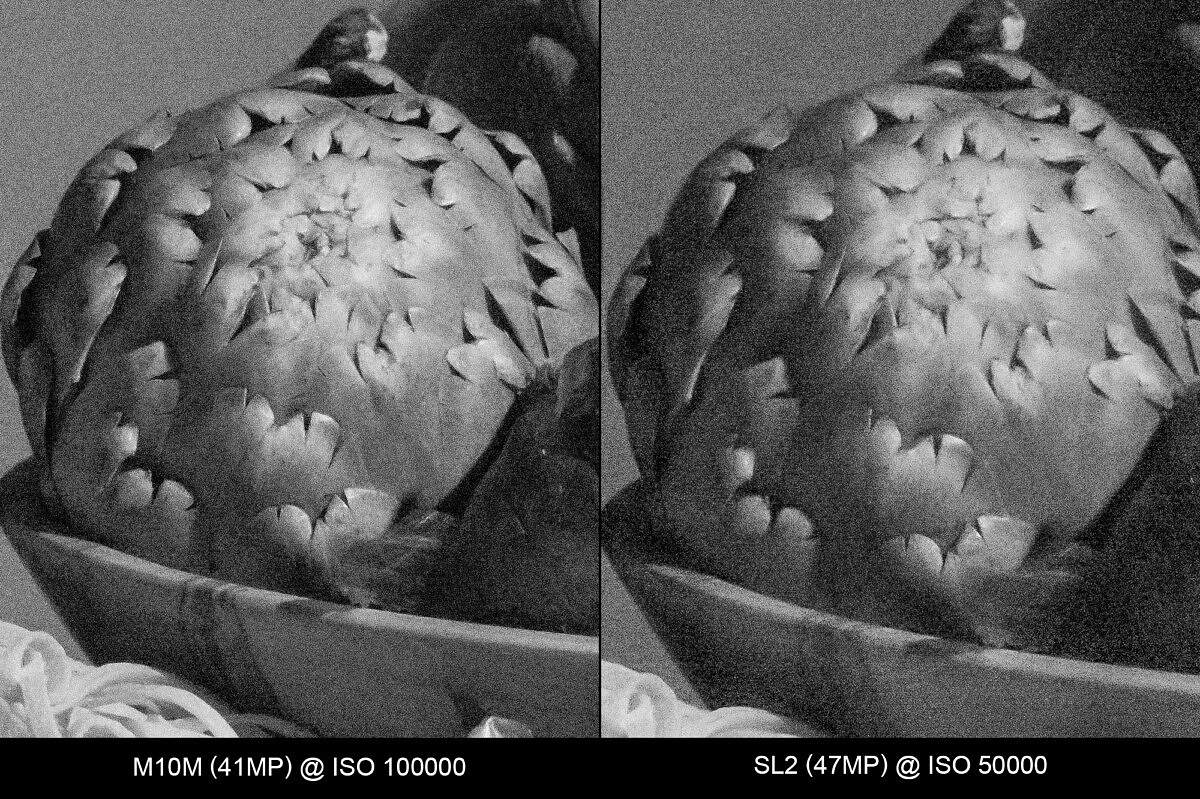
Best of Loftier ISO Settings
For this last comparison, I've put what I consider the highest ISO setting from each photographic camera that represents the all-time balance of lite sensitivity, item resolution and acceptable noise. For the M10M, as in the roundup of 1000 cameras, ISO 32000 looks phenomenal and gives upward very little regarding epitome quality. In guild to visually friction match up to the M10M, the SL2 puts up a decent, if not super-impressive ISO 6400. With detached i/3 stop increments, nosotros probably could have gotten more than, but ISO 12500 was simply as well much sacrifice for my tastes. The net result is a 2.three stop advantage for the M10M over the color flagship.
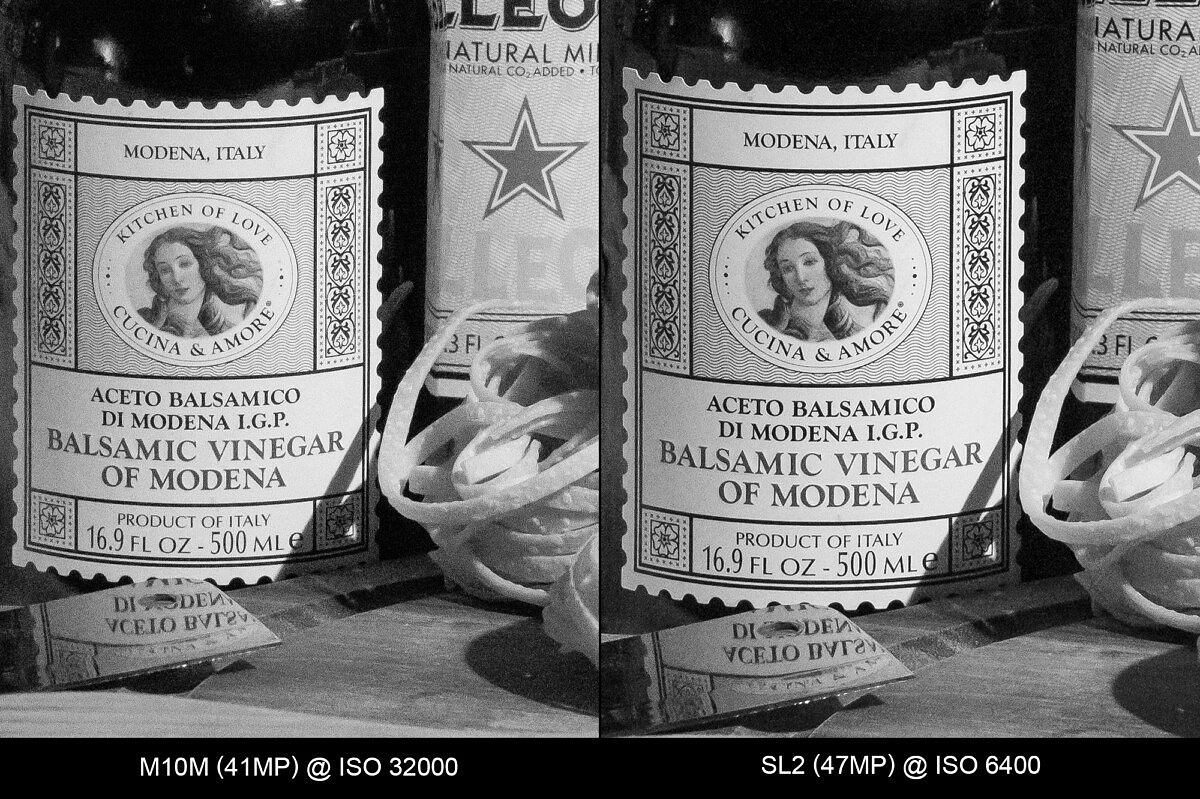
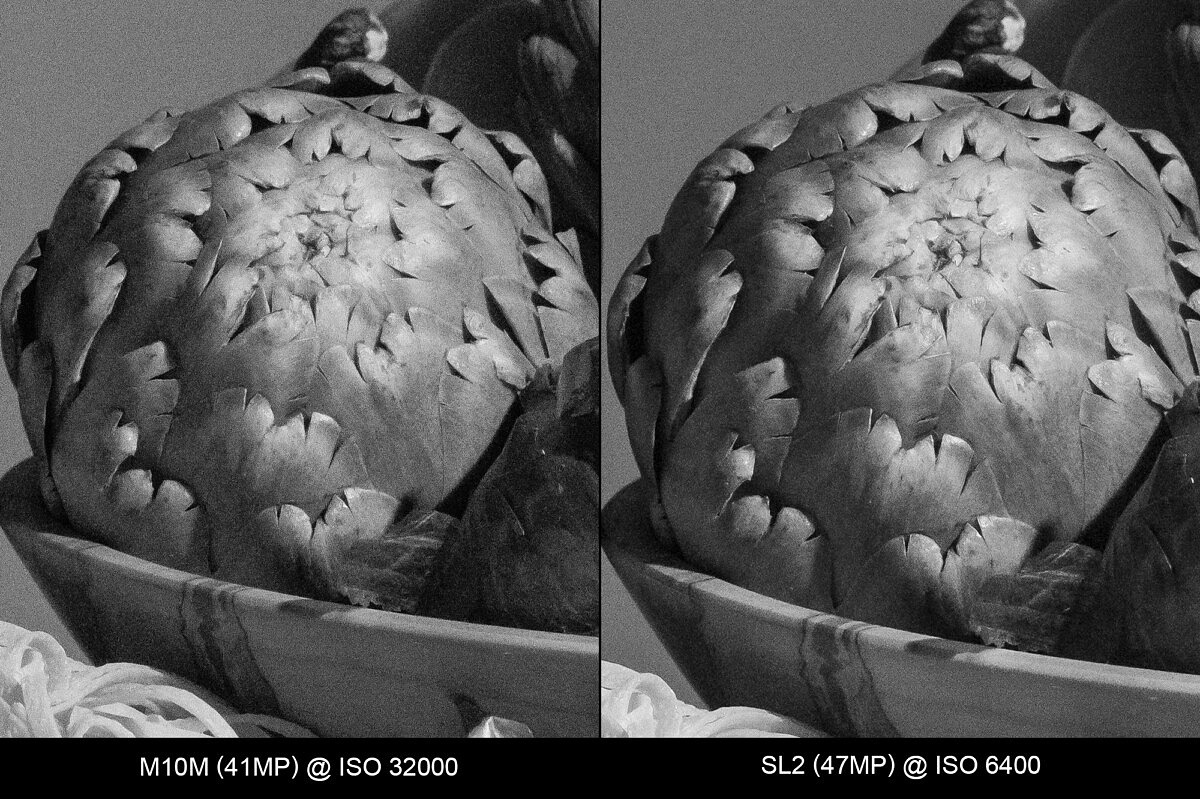
Final Thoughts
My number one takeaway: The M10 Monochrom is admittedly incredible in its ability to remainder item resolution with noise suppression, offering depression low-cal adequacy unimaginable just a few years agone. With that out of the way, allow's take a quick await at how the M10 Monochrom matches up confronting the One thousand contenders and the SL2.
Tackling the Chiliad lineup get-go, the M246 at 5 years onetime, puts upwardly an beauteous fight confronting the much newer M10-P and M10 Monochom. And if all you lot need is solid ISO 12500, the M246 still represents an amazing value in 2020. The M10-P, for its function, did even improve than I imagined. Sure, really clean results top out effectually ISO 10000, but the camera tin push past there in a pinch. As noise increases, sharpness and detail are largely maintained. Ultimately, the M10M posts around a 1.5 stop reward over both the M Monochrom (Typ 246) and the M10-P at their best case settings, but can extend that lead to over 2 stops equally ISO continues to increase.
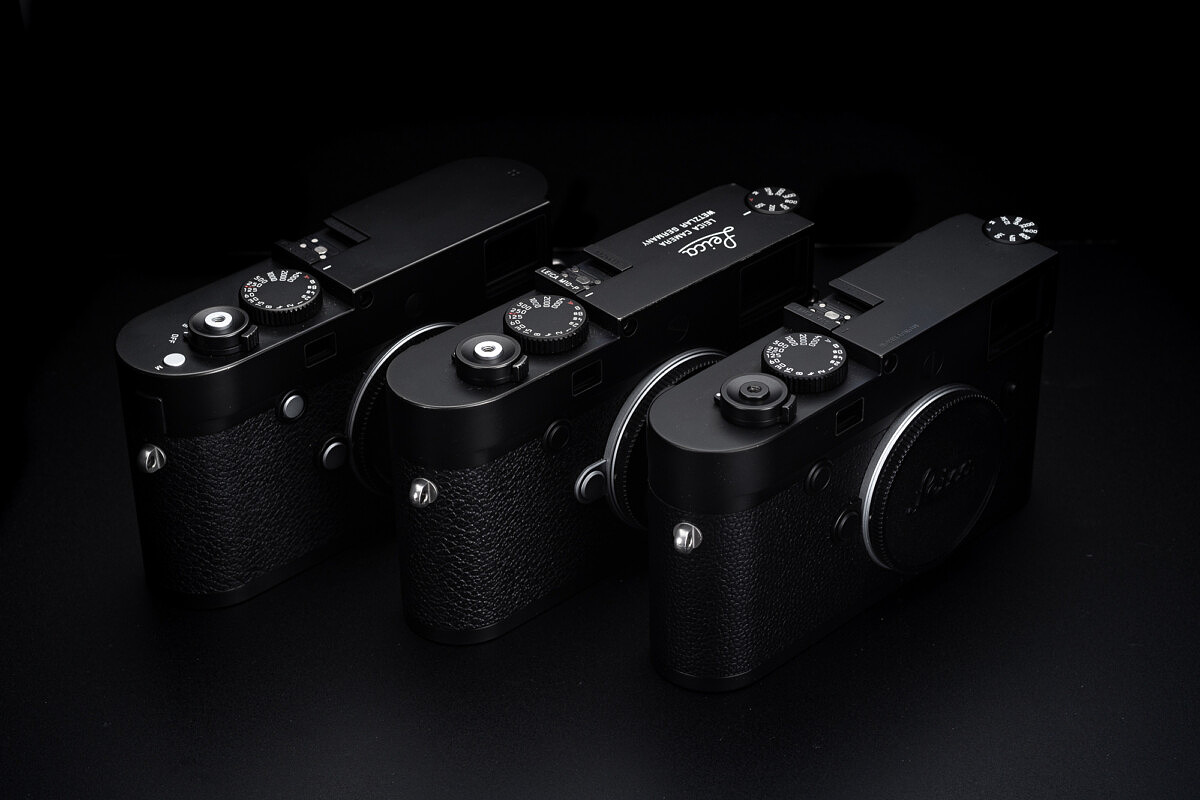
The results from the SL2 were somewhat unexpected. As the electric current technology flagship for Leica, I was hoping for a little amend showing from the SL2. With an optimal top stop of ISO 6400, the SL2 tin notwithstanding claim the resolution and detail crown at the depression-to-mid range of ISO values, simply suffers from dissonance and reduced dynamic range at ISO 12500 and in a higher place. The internet result is a 2.5 stop improvement in loftier ISO of the M10M over the SL2.
That being said, having used the SL2 extensively for the last several months, I never felt limited by its ISO range. And because of the constructive sensor-based image stabilization, I rarely need to go past ISO 6400. Given that it offers double the resolution the of the M10, I'm willing to make that tradeoff in order to maximize image quality for my landscape photography and proceeds access to the exceptional SL lenses.
The M10 Monochrom, on the other hand, has allowed me to shoot at i/500th of a second, under almost whatever lighting condition, taking a completely different approach to eliminating photographic camera shake. With the M10 Monochrom, you just don't need to always worry nigh ISO.
Hopefully, you constitute the results here helpful in understanding the blackness and white capabilities of all these excellent photographic tools. Ultimately, whatever of them volition work extremely well for existent-globe photography. Whether you prioritize the unparalleled low light prowess of the M10 Monochrom, the value of the M Monochrom (Typ 246), the flexibility of a color M with the M10-P, or the technically advanced feature set and ultimate resolution of the SL2, volition be up to y'all as a lensman and what works all-time for your photography.
Leica Monochrom 246 Vs M10,
Source: https://www.reddotforum.com/content/2020/05/bw-iso-showdown-2020-leica-m10-monochrom-vs-m-monochrom-typ-246-vs-m10-p-vs-sl2/
Posted by: rowanforpets.blogspot.com


0 Response to "Leica Monochrom 246 Vs M10"
Post a Comment